-
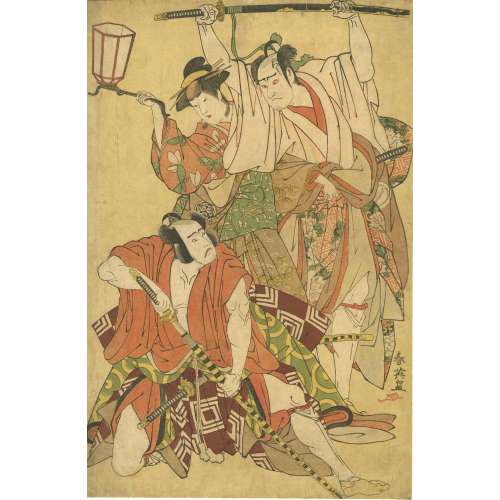 Katsukawa Shun'ei. Signed: Shun'ei ga (春英画). Vertical Ōban. No reference whatsoever. Unidentified play, actors, roles, year, theatre. SOLD
Katsukawa Shun'ei. Signed: Shun'ei ga (春英画). Vertical Ōban. No reference whatsoever. Unidentified play, actors, roles, year, theatre. SOLD -
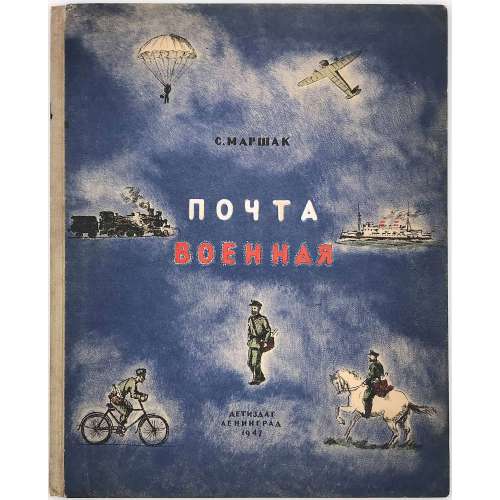 С. Маршак. Почта военная. Детиздат : Ленинград, 1947.
С. Маршак. Почта военная. Детиздат : Ленинград, 1947.Hard-bound Quatro (304 x 246 mm) printed in lithography with hand-colored details on cover.
The name of artist hardly legible on a stamp on frontispiece: скворцов.
The text repeats itself on multiple pages. Most probably the book is a pilot run, never went to mass printing and distribution. -
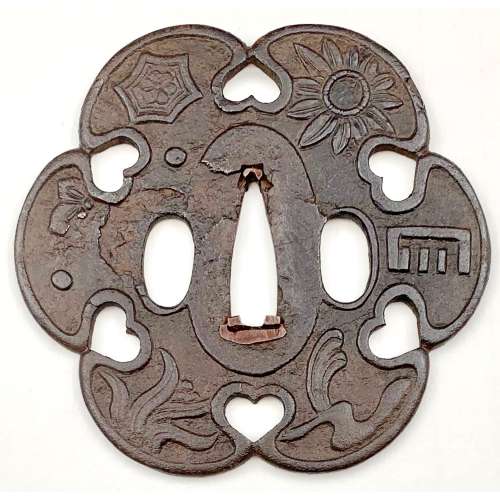 Iron tsuba of six-lobed (mutsu-mokkō-gata) form, with six wild boar's eye shape (inome) openings (sukashi). Ryo-Hitsu and the entire perimeter of tsuba have typical for this school raised rim; raised seppa dai. Lobes are decorated in low relief carving (sukidashi-bori). On the obverse: chrysanthemum, Genji mon, waves and rocks, grasses and star, bellflower, star and flower in tortoiseshell (kikko). On the reverse: Stars and different flowers, and flying geese. The plate is damaged to the left of nakago-ana and around the left hitsu-ana. Kamakura-bori school. Late Muromachi period (1514-1573). Diameter: 89 mm; Thickness at seppa-dai: 4.0 mm; Weight: 108.8 g [large]. There is a similar tsuba in this collection, TSU-0345.2018, but with a different motif and much smaller: diameter 74.3 mm, thickness at seppa-dai: 3.2 mm, weight: 62.8 g.Another look-a-like tsuba can be found at the Compton Collection, part II, pp. 14-15, №17, though his tsuba is more massive (80 x 84 x 4 mm).
Iron tsuba of six-lobed (mutsu-mokkō-gata) form, with six wild boar's eye shape (inome) openings (sukashi). Ryo-Hitsu and the entire perimeter of tsuba have typical for this school raised rim; raised seppa dai. Lobes are decorated in low relief carving (sukidashi-bori). On the obverse: chrysanthemum, Genji mon, waves and rocks, grasses and star, bellflower, star and flower in tortoiseshell (kikko). On the reverse: Stars and different flowers, and flying geese. The plate is damaged to the left of nakago-ana and around the left hitsu-ana. Kamakura-bori school. Late Muromachi period (1514-1573). Diameter: 89 mm; Thickness at seppa-dai: 4.0 mm; Weight: 108.8 g [large]. There is a similar tsuba in this collection, TSU-0345.2018, but with a different motif and much smaller: diameter 74.3 mm, thickness at seppa-dai: 3.2 mm, weight: 62.8 g.Another look-a-like tsuba can be found at the Compton Collection, part II, pp. 14-15, №17, though his tsuba is more massive (80 x 84 x 4 mm).
Varshavsky Collection: TSU-0345.2018
This tsuba, TSU-0401.2019, is the biggest of all three (another mine and the one from Campton Collection). The presence of a flower in a tortoiseshell symbol (crest or mon) on this tsuba alludes to Izumo Shrine. The overall piece, with symbols of grasses, waves, flowers, incense, stars, and flying geese, is full of autumnal connotations.
Compton Collection, part II, pp. 14-15, №17: Kamakura-bori tsuba, ca. 1450.
-
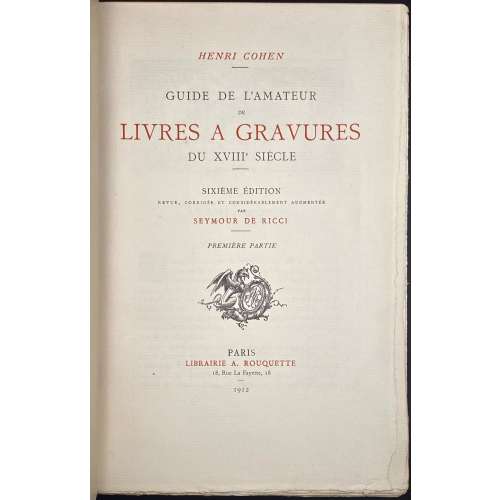 Herni Cohen. Guide de l'amateur de livres à gravures du XVIIIe siècle (6e édition) / Revue, corrigée et considérablement augmentée par Seymour de Ricci, préface par R. Portalis; 2 Volumes. – Paris: Librairie A. Rouquette, 1912. – Achevé d'Imprimer à Melun par Émile Legrand le 25 juin MDCCCCXII [1912]. Vol. 1, Première partie – ABAA-LUY: ffl [4 blanks] [2 - orig. grey front wrapper w/title, verso blank] [2 blanks] [2 - ht, tirage] [2 - blank, frontis. w/protect. sheet] [2 - blank, frontis. w/protect. sheet] (double frontis. - correct), [2 - t.p., blank] [i - avant-propos w/vignette] ii-vi, [vii - préface w/vignette] viii-xxvi; [1-2 - Tome 1, I] 2-668 (two numbers per page), [2 - fin, blank] [2 blanks] [2 - orig. grey back wrapper, recto blank] [orig. spine strip] [4 blanks] bfl. Vol. 2, Seconde partie – MAB-ZUR : ffl [4 blanks] [2 - orig. grey front wrapper w/title, verso blank] [2 blanks] [2 - ht, blank] [2 - t.p., blank] [2 - blank, frontis. w/protect. sheet] [2 - blank, frontis. w/protect. sheet] (double frontis. - correct), [1-2 - Tome II, 22] 671-1248 (two numbers per page), [2 - printer, blank] [2 blanks] [2 - orig. grey back wrapper, recto imprim.] [orig. spine strip] [4 blanks] bfl. Size: Super Royal 8vo, 26.2 x 17.2 x 5.1 cm. Binding: Contemporary blue half morocco over marbled boards, marbled end-papers, top margin gilt, gilt lettering to spine (title, owner: P. R.).; bookplate pasted to verso of the first blank leaf: " Ex Libris R. Decamps Scrive." – for bibliophile René Descamps-Scrive (French, 1853 –1924). Original wrappers preserved. Printed on Hollande paper, copy № 2 of the first 50; total print-run 1050 copies. Catalogue raisonné of French illustrated books of the 18th century.
Herni Cohen. Guide de l'amateur de livres à gravures du XVIIIe siècle (6e édition) / Revue, corrigée et considérablement augmentée par Seymour de Ricci, préface par R. Portalis; 2 Volumes. – Paris: Librairie A. Rouquette, 1912. – Achevé d'Imprimer à Melun par Émile Legrand le 25 juin MDCCCCXII [1912]. Vol. 1, Première partie – ABAA-LUY: ffl [4 blanks] [2 - orig. grey front wrapper w/title, verso blank] [2 blanks] [2 - ht, tirage] [2 - blank, frontis. w/protect. sheet] [2 - blank, frontis. w/protect. sheet] (double frontis. - correct), [2 - t.p., blank] [i - avant-propos w/vignette] ii-vi, [vii - préface w/vignette] viii-xxvi; [1-2 - Tome 1, I] 2-668 (two numbers per page), [2 - fin, blank] [2 blanks] [2 - orig. grey back wrapper, recto blank] [orig. spine strip] [4 blanks] bfl. Vol. 2, Seconde partie – MAB-ZUR : ffl [4 blanks] [2 - orig. grey front wrapper w/title, verso blank] [2 blanks] [2 - ht, blank] [2 - t.p., blank] [2 - blank, frontis. w/protect. sheet] [2 - blank, frontis. w/protect. sheet] (double frontis. - correct), [1-2 - Tome II, 22] 671-1248 (two numbers per page), [2 - printer, blank] [2 blanks] [2 - orig. grey back wrapper, recto imprim.] [orig. spine strip] [4 blanks] bfl. Size: Super Royal 8vo, 26.2 x 17.2 x 5.1 cm. Binding: Contemporary blue half morocco over marbled boards, marbled end-papers, top margin gilt, gilt lettering to spine (title, owner: P. R.).; bookplate pasted to verso of the first blank leaf: " Ex Libris R. Decamps Scrive." – for bibliophile René Descamps-Scrive (French, 1853 –1924). Original wrappers preserved. Printed on Hollande paper, copy № 2 of the first 50; total print-run 1050 copies. Catalogue raisonné of French illustrated books of the 18th century. -
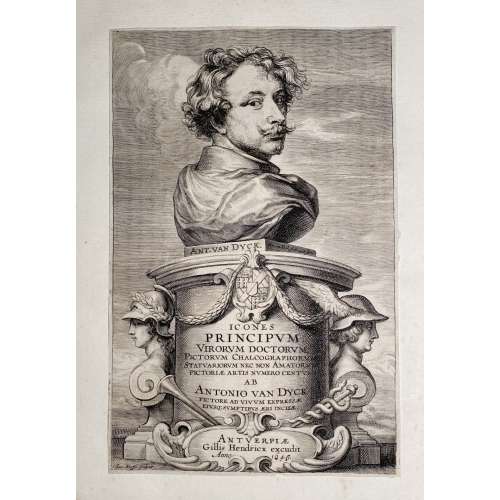 A book of sixty-eight copperplate engravings (burin and etching) by various artists after Anthony van Dyck, and one engraving by Lucas Vorsterman I, printed in black on laid paper, bound in full calf with a blind-stamped double-fillet ruling to the boards, spine with raised bands, gilt floral lozenges in compartments, gilt lettering "RECUE DE FIGUR", all margins sprinkled red, marbled end-papers. Engravers: Adriaen Lommelin (French engraver, 1637 – c. 1673) : 12 plates: №№ 3, 17, 18, 20, 21, 24, 25, 26, 28, 30, 35, and 48. Anthony van Dyck (Flemish, 1599 – 1641) : partially engraved himself 1 plate: № 53. Antoine Couchet (Flemish, 1630 – 1678) : 1 plate № 30. Conrad Waumans [Woumans] (Flemish engraver, 1619 – after 1675) : 6 plates: №№ 5, 32, 36, 57, 64, and 66. Cornelis Galle the Younger (Flemish engraver, 1615 – 1678) : 5 plates: №№ 2, 7, 10, 29, and 33. Hendrick Snyers (Flemish engraver, 1611 – 1644) : 1 plate: № 9. Jacob Neefs, or Neeffs (Flemish engraver, 1610 – after 1660): 4 plates: №№ 1, 16, 45, and 67. Johannes [Jan] Meyssens (Flemish engraver and publisher, 1612 – 1670) : engraved 6 plates: №№ 4, 22, 31, 51, 61, and 62. Lucas Vorsterman the Elder (Flemish engraver, 1595 – 1675) : engraved 7 plates: №№ 11, 15, 55, 58, 59, 65, and 69. Michael Natalis, or Noël (Flemish engraver, 1610 – 1668) : 1 plate: № 34 Paulus Pontius (Flemish engraver, 1603 – 1658) : 2 plates: №№ 37 and 52. Peeter Clouwet (Flemish engraver, 1629 – 1670) : 3 plates: №№ 13, 27, and 49. Peeter van Lisebetten (Flemish engraver, 1630 – 1678) : 1 plate: № 56. Pieter de Bailliu (Flemish engraver, 1613 – after 1660) : 4 plates: №№ 8, 14, 44, and 54. Pieter de Jode II (Flemish, 1606 – 1670/74) : 7 plates: №№ 12, 19, 23, 46, 47, 50, and 60. Richard Gaywood (British, fl. 1644 – 1668) : 1 plate: № 63. Robert van Voerst (Dutch, 1597 – 1636) : 1 plate: № 6. Schelte Adamsz. Bolswert (Flemish, c. 1586 – 1659) : 2 plates: №№ 18 and 68. Wenceslaus Hollar (Bohemian, 1607 – 1677) : 6 plates: №№ 38, 39, 40, 41, 42, and 43. Publishers: 36 prints were printed/published by Johannes [Jan] Meyssens (Flemish, 1612 – 1670) : (2), (4), (5), (7), (8), (9), (10), (12), (14), (22), (29), (31), (32), (33), (34), (36), (37), (39), (40), (41), (42), (43), (44), (45), (46), (51), (53), (54), (56), (57), (60), (61), (62), (64), (66), (67). Gillis Hendricx (fl. 1640 – 1677) published 11 prints, including the title page: (1), (13), (18), (26), (30), (47), (48), (50), (59), (65), (68). N. Burgund. Cons. Brab : (20); John Overton (British, 1639/40 – 1713) : (63); Hendrik van der Borcht II (Dutch, 1614 – c. 1690) : (38); Peter Stent (British, fl. c. 1637 – 1665) : (63). Description of plates:
A book of sixty-eight copperplate engravings (burin and etching) by various artists after Anthony van Dyck, and one engraving by Lucas Vorsterman I, printed in black on laid paper, bound in full calf with a blind-stamped double-fillet ruling to the boards, spine with raised bands, gilt floral lozenges in compartments, gilt lettering "RECUE DE FIGUR", all margins sprinkled red, marbled end-papers. Engravers: Adriaen Lommelin (French engraver, 1637 – c. 1673) : 12 plates: №№ 3, 17, 18, 20, 21, 24, 25, 26, 28, 30, 35, and 48. Anthony van Dyck (Flemish, 1599 – 1641) : partially engraved himself 1 plate: № 53. Antoine Couchet (Flemish, 1630 – 1678) : 1 plate № 30. Conrad Waumans [Woumans] (Flemish engraver, 1619 – after 1675) : 6 plates: №№ 5, 32, 36, 57, 64, and 66. Cornelis Galle the Younger (Flemish engraver, 1615 – 1678) : 5 plates: №№ 2, 7, 10, 29, and 33. Hendrick Snyers (Flemish engraver, 1611 – 1644) : 1 plate: № 9. Jacob Neefs, or Neeffs (Flemish engraver, 1610 – after 1660): 4 plates: №№ 1, 16, 45, and 67. Johannes [Jan] Meyssens (Flemish engraver and publisher, 1612 – 1670) : engraved 6 plates: №№ 4, 22, 31, 51, 61, and 62. Lucas Vorsterman the Elder (Flemish engraver, 1595 – 1675) : engraved 7 plates: №№ 11, 15, 55, 58, 59, 65, and 69. Michael Natalis, or Noël (Flemish engraver, 1610 – 1668) : 1 plate: № 34 Paulus Pontius (Flemish engraver, 1603 – 1658) : 2 plates: №№ 37 and 52. Peeter Clouwet (Flemish engraver, 1629 – 1670) : 3 plates: №№ 13, 27, and 49. Peeter van Lisebetten (Flemish engraver, 1630 – 1678) : 1 plate: № 56. Pieter de Bailliu (Flemish engraver, 1613 – after 1660) : 4 plates: №№ 8, 14, 44, and 54. Pieter de Jode II (Flemish, 1606 – 1670/74) : 7 plates: №№ 12, 19, 23, 46, 47, 50, and 60. Richard Gaywood (British, fl. 1644 – 1668) : 1 plate: № 63. Robert van Voerst (Dutch, 1597 – 1636) : 1 plate: № 6. Schelte Adamsz. Bolswert (Flemish, c. 1586 – 1659) : 2 plates: №№ 18 and 68. Wenceslaus Hollar (Bohemian, 1607 – 1677) : 6 plates: №№ 38, 39, 40, 41, 42, and 43. Publishers: 36 prints were printed/published by Johannes [Jan] Meyssens (Flemish, 1612 – 1670) : (2), (4), (5), (7), (8), (9), (10), (12), (14), (22), (29), (31), (32), (33), (34), (36), (37), (39), (40), (41), (42), (43), (44), (45), (46), (51), (53), (54), (56), (57), (60), (61), (62), (64), (66), (67). Gillis Hendricx (fl. 1640 – 1677) published 11 prints, including the title page: (1), (13), (18), (26), (30), (47), (48), (50), (59), (65), (68). N. Burgund. Cons. Brab : (20); John Overton (British, 1639/40 – 1713) : (63); Hendrik van der Borcht II (Dutch, 1614 – c. 1690) : (38); Peter Stent (British, fl. c. 1637 – 1665) : (63). Description of plates: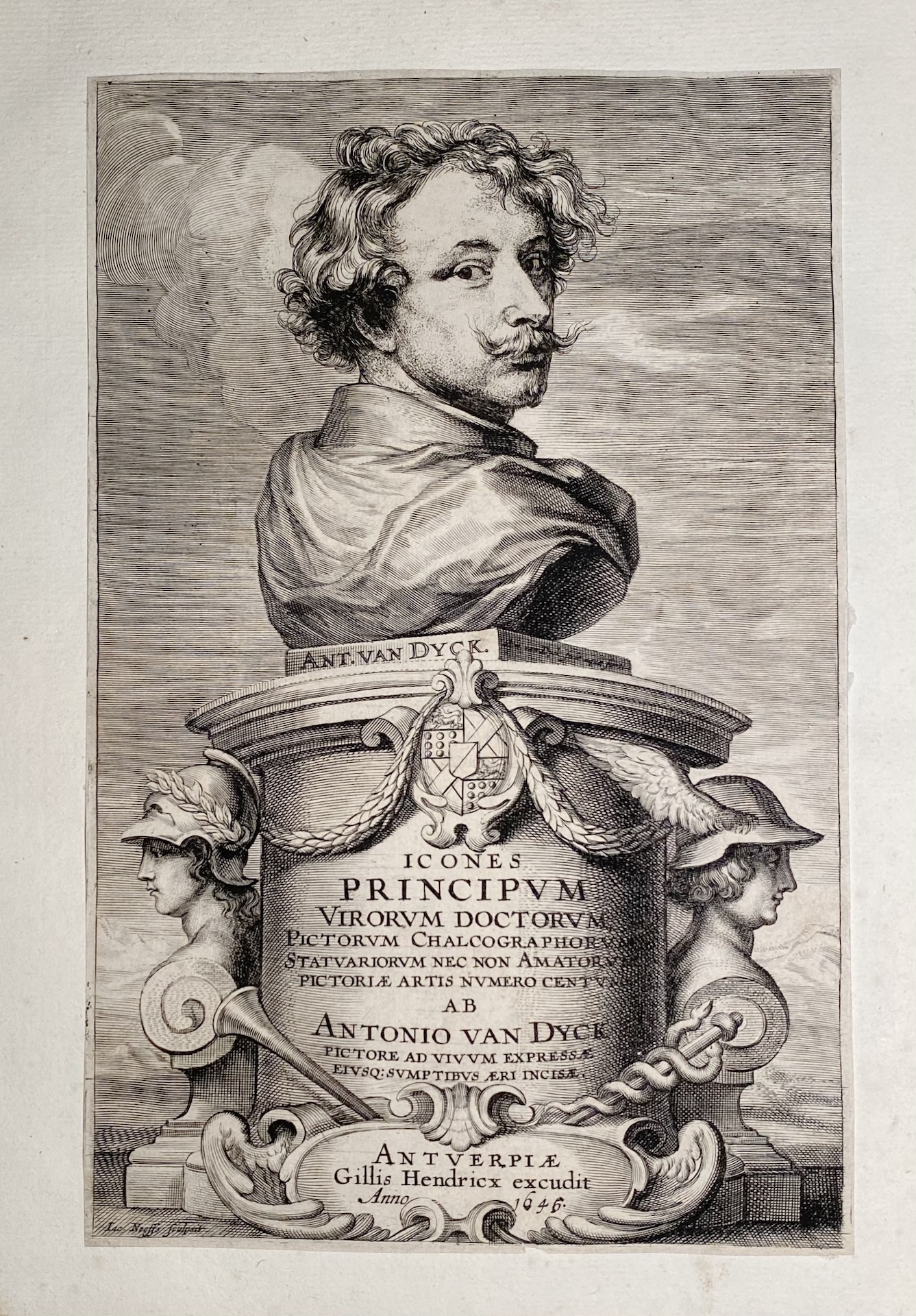
1. Engraved title page by Jacob Neeffs in 1646. On the slab supporting the bust, left: “ANT. VAN DYCK”, right: “Ant. van Dyck fecit aqua forti”. On the face of pedestal: “PRINCIPVM | VIRORVM DOCTORVM, | PICTORVM CHALCOGRAPHORVM, | STATVARIORVM NEC NON AMATORVM | PICTORIÆ ARTIS NVMERO CENTVM | AB | ANTONIO VAN DYCK, | PICTORE AD VIVVM EXPRESSÆ | EIVSQ: SVMPTIBVS ÆRI INCISÆ.” In cartouche: “ANTVERPIÆ | Gillis Hendricx excudit | Anno 1645” (corrected by hand “1646”). At lower left margin: “Iac. Neeffs Sculpsit.” The print with cut off margins pasted to the bound-in leaf. Size of the print: 24.3 x 15.8 cm. 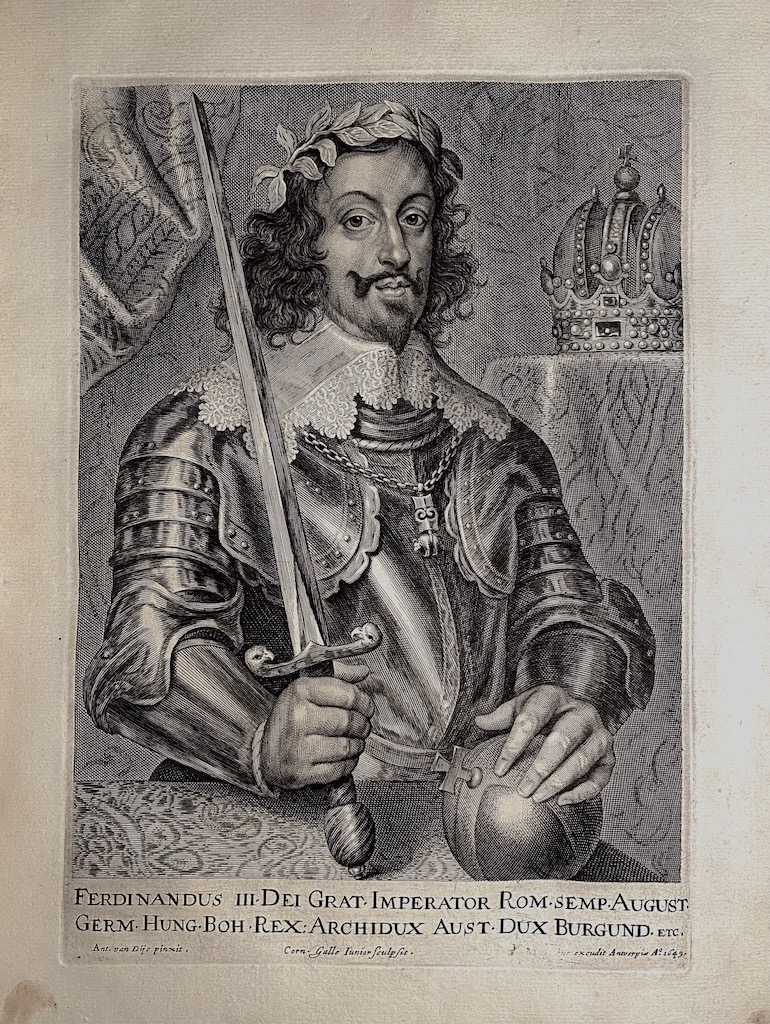
2. Ferdinand III, Holy Roman Emperor and King of Hungary and Bohemia (1608 – 1657); engraved by Cornelis Galle the Younger (Flemish, 1615–1678) in 1649. Inscription: “FERDINANDUS III. DEI GRAT. IMPERATOR ROM.SEMP.AUGUST. | GERM. HUNG. BOH. REX: ARCHIDICUX AU ST. DUX BURGUND. ETC.”. Below: “Ant. van Dÿc pinxit” <–> “Corn. Galle Iunior sculp∫it.”<–> “…excudit Antuerpiæ A.o 1649”. Second state with Meyssens’ name burnished. 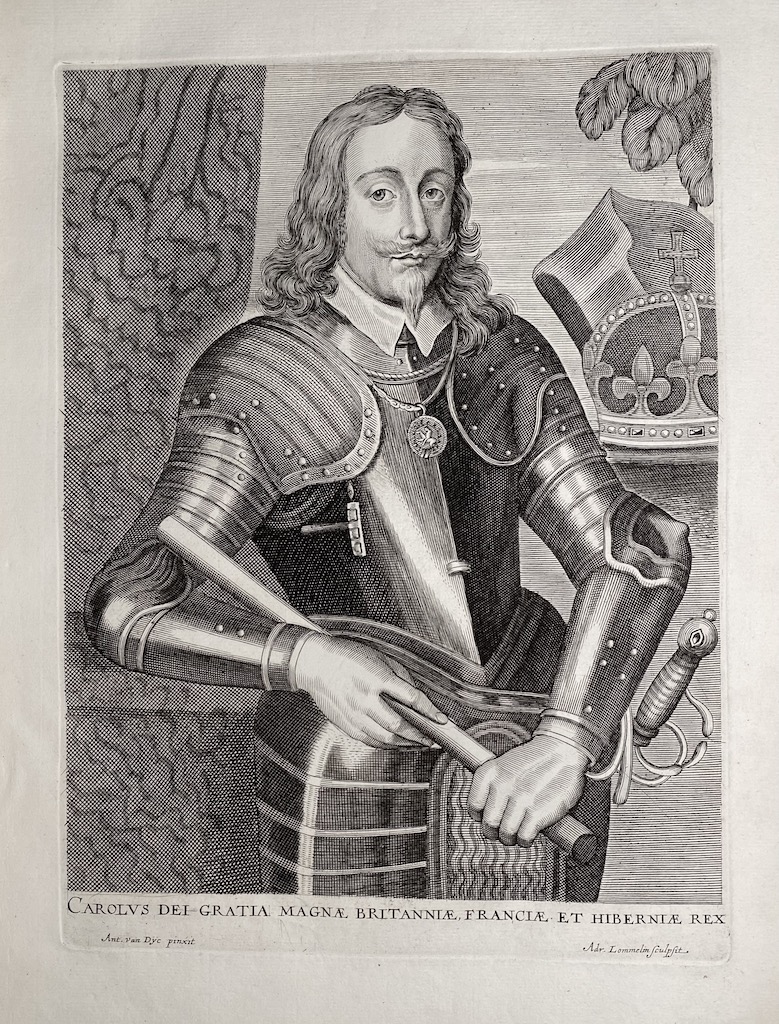
3. Charles I, King of England, Scotland, and Ireland (British, 1600 – 1649); engraved by Adriaen Lommelin (French, 1637 – c. 1673). Inscription: “CAROLVS DEI GRATIA MAGNÆ BRITANNIÆ, FRANCIÆ ET HIBERNIÆ REX”. Below: “Ant. van Dÿc pinxit” <–> “Adr. Lommelin sculpsit”. 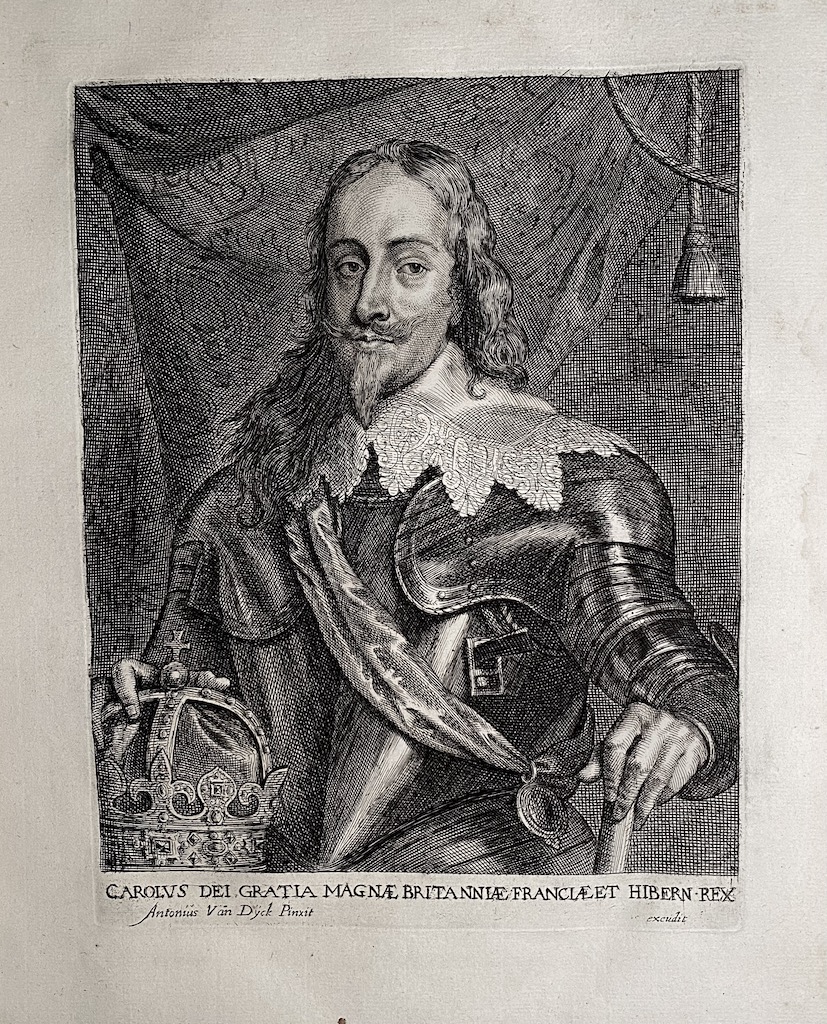
4. Charles I, King of England, Scotland, and Ireland (British, 1600 – 1649); engraved by Johannes [Jan] Meyssens (Flemish, 1612 – 1670). Inscription: “CAROLVS DEI GRATIA MAGNÆ BRITANNIÆ, FRANCIÆ ET HIBERNIÆ REX”. Below: Antonius Van Dÿck eques pinxit” <–> “...excudit”. Meyssens’ name burnished. [See similar print №61 with Ioannes Meysens name present]. 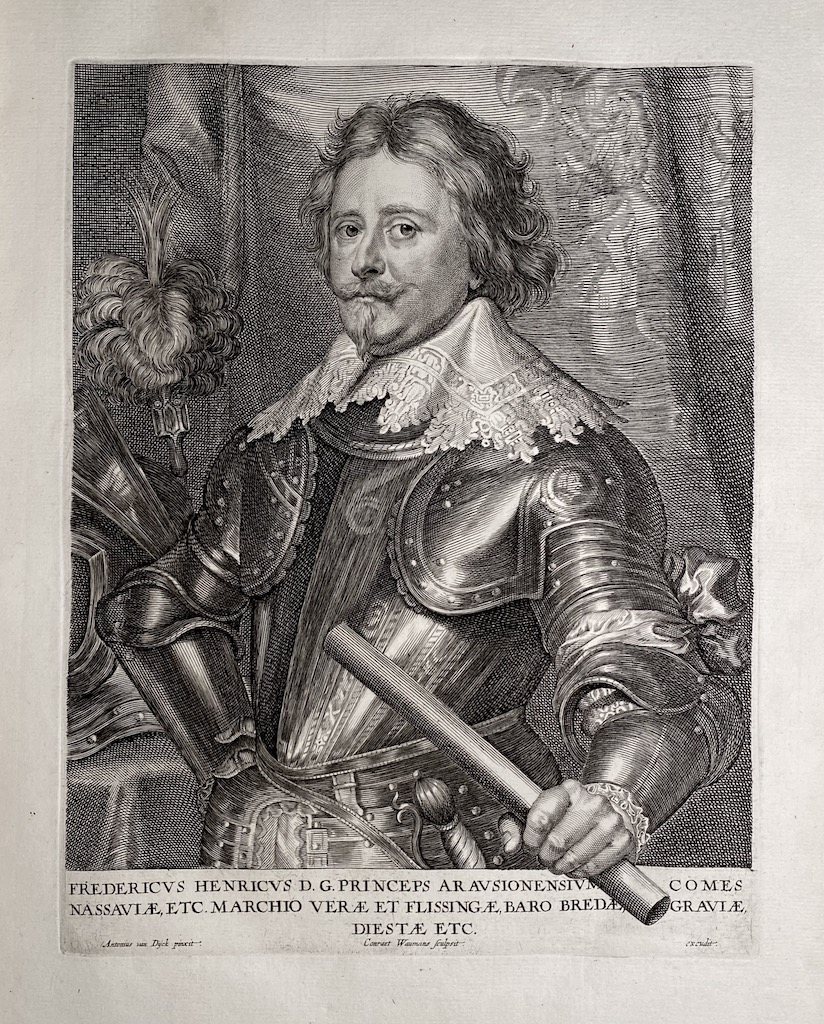
5. Frederick Henry, Prince of Orange, Count of Nassau (Dutch, 1584 – 1647); engraved by Conrad Waumans [Woumans] (Flemish, 1619 – after 1675). Inscription: “FREDERICVS HENRICVS, D.G. PRINCEPS ARAVSIONENSIVM, COMES | NASSAVIÆ, ETC. | MARCHIO VERÆ ET FLISSINGÆ, BARO BREDÆ GRAVÆ, | DIESTÆ ETC.” Below: “Antonius van Dÿck pinxit” <–> “Conraet Waumans sculpsit” <–> “…excudit”. Meyssens’ name burnished. [Similar to №57, but with Ioannes Meyssens name in place]. 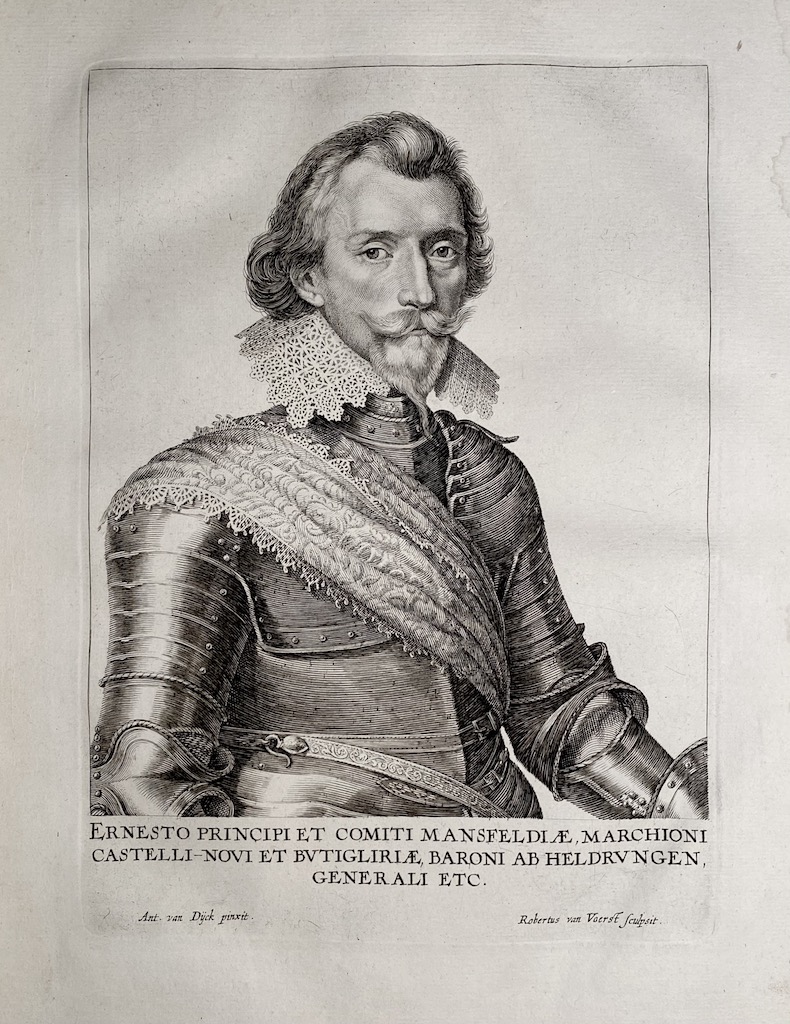
6. Count Ernst von Mansfield (German, 1580 – 1626); engraved by Robert van Voerst (Dutch, 1597 – 1636). Inscription: “ERNESTO PRINCIPI ET COMITI MANSFELDIÆ, MARCHIONI | CASTELLI-NOVI ET BUTIGLIRIÆ, BARONI AB HELDRUNGEN, GENERALI ETC.” Below “Ant. Van Dÿck pinxit” <–> “Robertus van Voerst Sculpsit”. 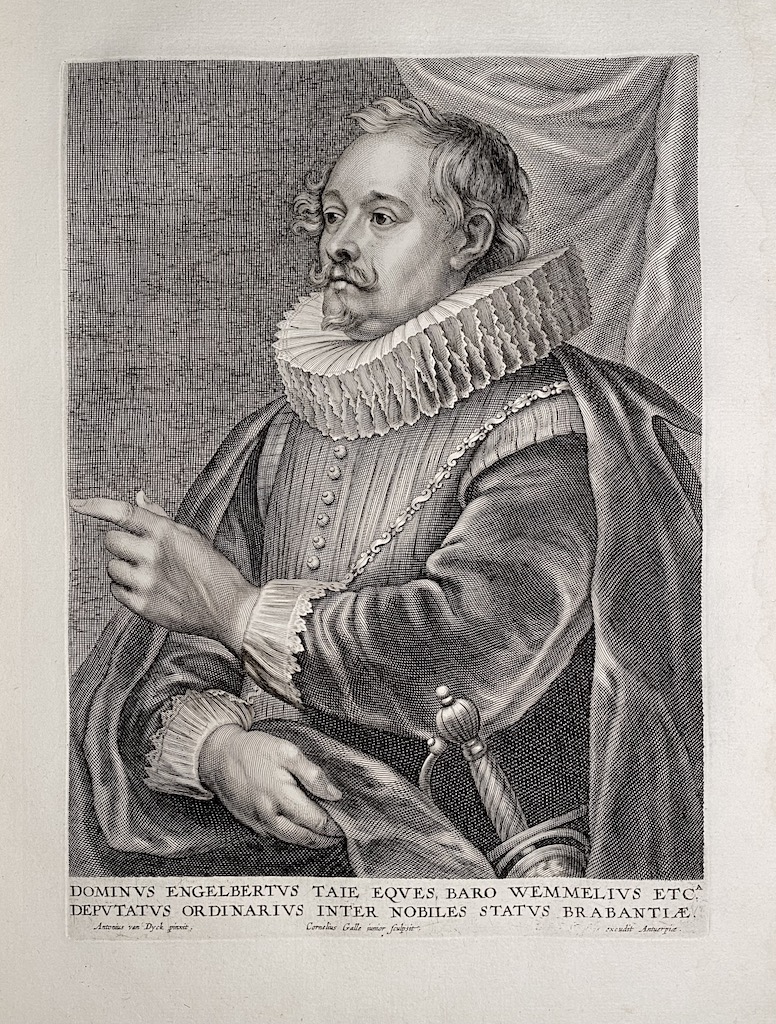
7. Engelbert Taye, Baron of Wemmel (Flemish, ? – 1638); engraved by Cornelis Galle the Younger. “DOMINVS ENGELBERTVS TAIE EQVES, BARO WEMMELIVS ETC.A | DEPVTATVS ORDINARIVS INTER NOBILES STATVS BRABANTIÆ.”. Below: “Antonius van Dyck pinxit”, “Cornelius Galle iunior ∫culpsit” <–> “…excudit Antuerpiæ.”. Second state, with “Ioannes Meyssens” erased. 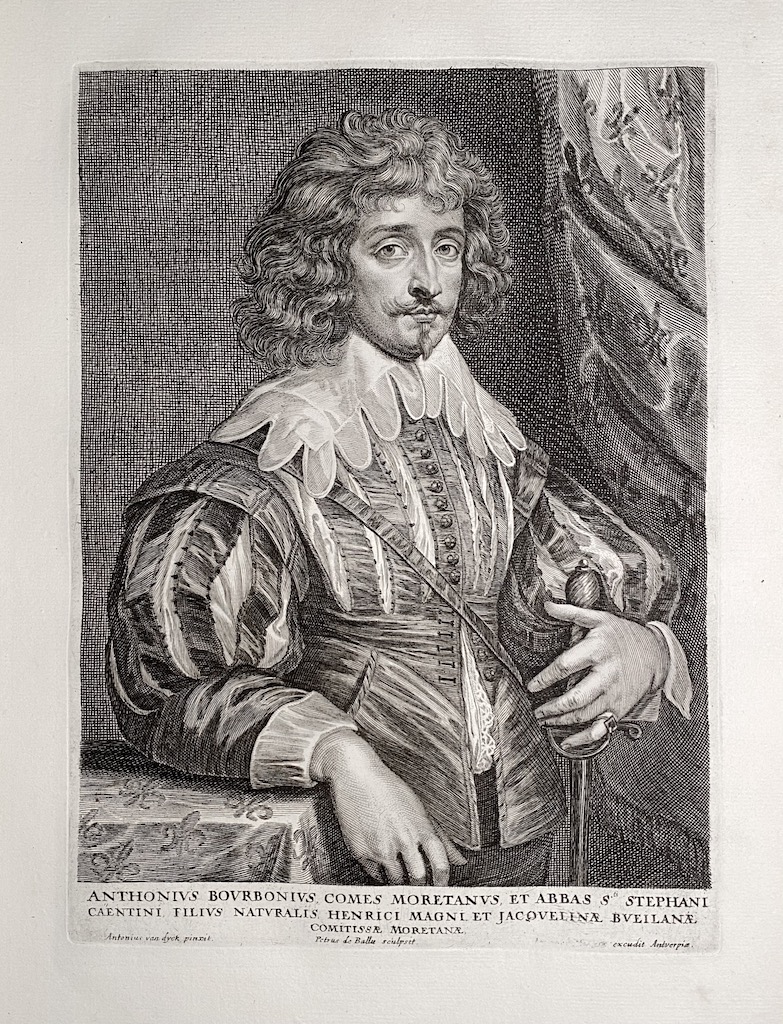
8. Antoine de Bourbon, comte de Moret (French, 1607 – 1632); engraved by Pieter de Bailliu (Flemish, 1613 – after 1660). Inscription: “ATHONIVS BOVRBONIVS, COMES MORETANVS, ET ABBAS S.TI STEPHANI | CAENTINI, FILIVS NATVRALIS, HENRICI MAGNI ET JACQVELINÆ BVEILANÆ | COMITISSÆ MORETANÆ,”. Below: “Antonius van dyck pinxit.” <–> “Petrus de Ballu sculpsit.” <–>“… excudit Antverpiæ.”. Second state with “Ioannes Meyssens” erased. Antoine de Bourbon was the illegitimate son of Henri IV, Roi de France and Jacqueline de Bueil, Comtesse de Moret. 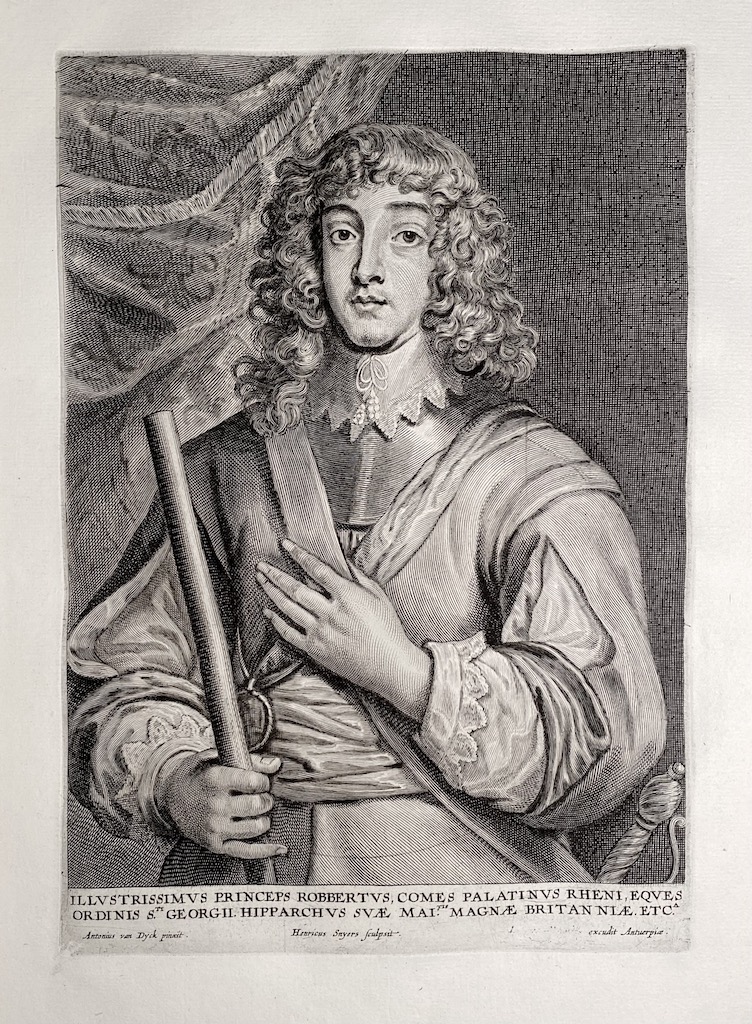
9. Prince Rupert of the Rhine (German, Bohemian, 1619 –1682); engraved by Hendrick Snyers (Flemish, 1611 – 1644). Inscription: “ILLVSTRISSIMVS PRINCEPS ROBBERTVS, COMES PALATINVS RHENI, EQVES | ORDINIS S.TI GEORGII. HIPPARCHVS SVÆ MAI.TIS MAGNÆ BRITANNIÆ. ETC.A”. Below: “Antonius van Dyck pinxit” <–> “Henricus Snyers sculpsit” <–> “...excudit Antuerpiæ.”. Second state with “Ioannes Meyssens” erased. 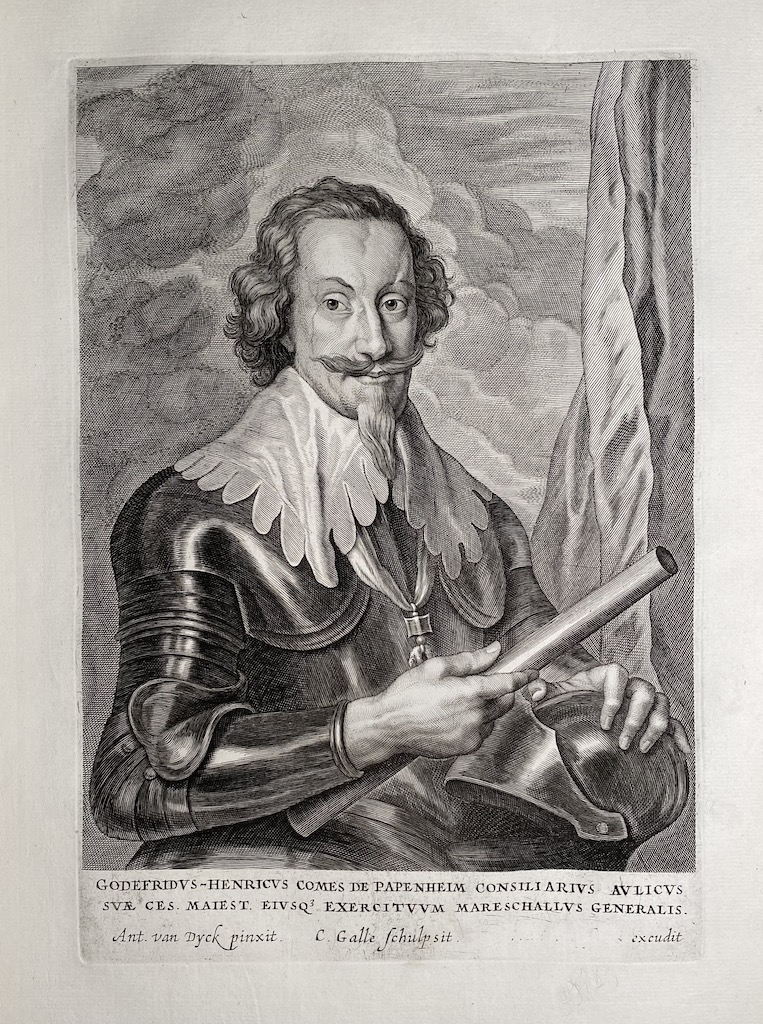
10. Gottfried-Heinrich, Count of Pappenheim; engraved by Cornelis Galle the Younger. Inscription: “GODEFRIDVS-HENRICVS COMES DE PAPENHEIM CONSILIARIVS AVLICVS | SVÆ CES. MAIES. EIVSQ³ EXERCITVVM MARESCHALLVS GENERALIS.” Lettered with production details below: “Ant. van Dyck pinxit” <–> “C. Galle ∫chulpsit.” <–> “…excudit”. Second state with “Ioan. Meyßens” erased. 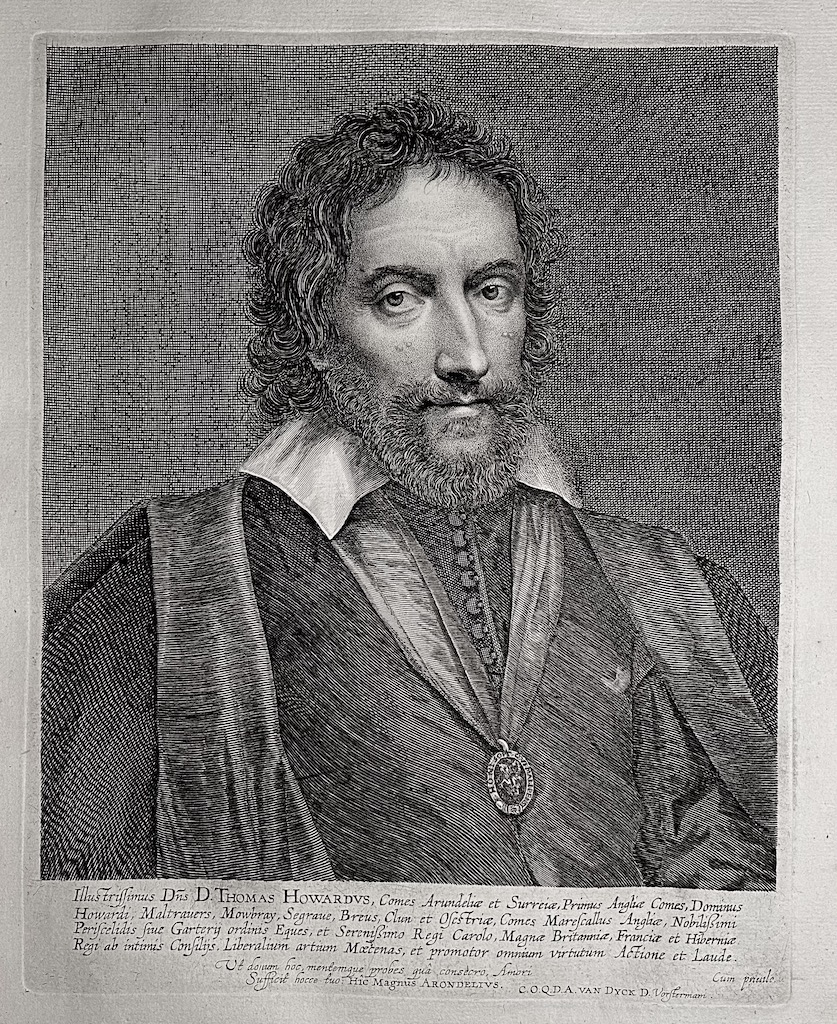
11. Thomas Howard, 14th Earl of Arundel (British, 1585 – 1646); engraved by Lucas Vorsterman the Elder (1595–1675). Inscription: “Illustri∫∫imus Dñs. D.Thomas Howardvs, Comes Arundeliæ et Surreiæ, Primus Angliæ Comes, Dominus | Howardi, Maltrauers, Mowbray, Segraue, Breus, Clun et O∫estriæ, Comes Mare∫callus Angliæ, Nobilißimi | Pericelidis ∫iue Garterij ordinis Eques, et Serenißimo Regi Carolo, Magnæ Britaniæ, Franciæ et Hiberniæ | Regi ab intimis Consilijs, Liberalium artium Mæcenas, et promotor omnion virtutum Actione et Laude.”. Below: “Ut donum hoc, mantenque probes qua consecro, Amori | Sufficit hocci tuo: Hic Magnvs ARONDELIVS”, “C.O.Q.D.A. VAN DYCK D. Vor∫termani.”, “Cum priuile.”. Third state with ‘Opera Vorstermanni’ burnished and two lines of Latin added below the four lines of the title. 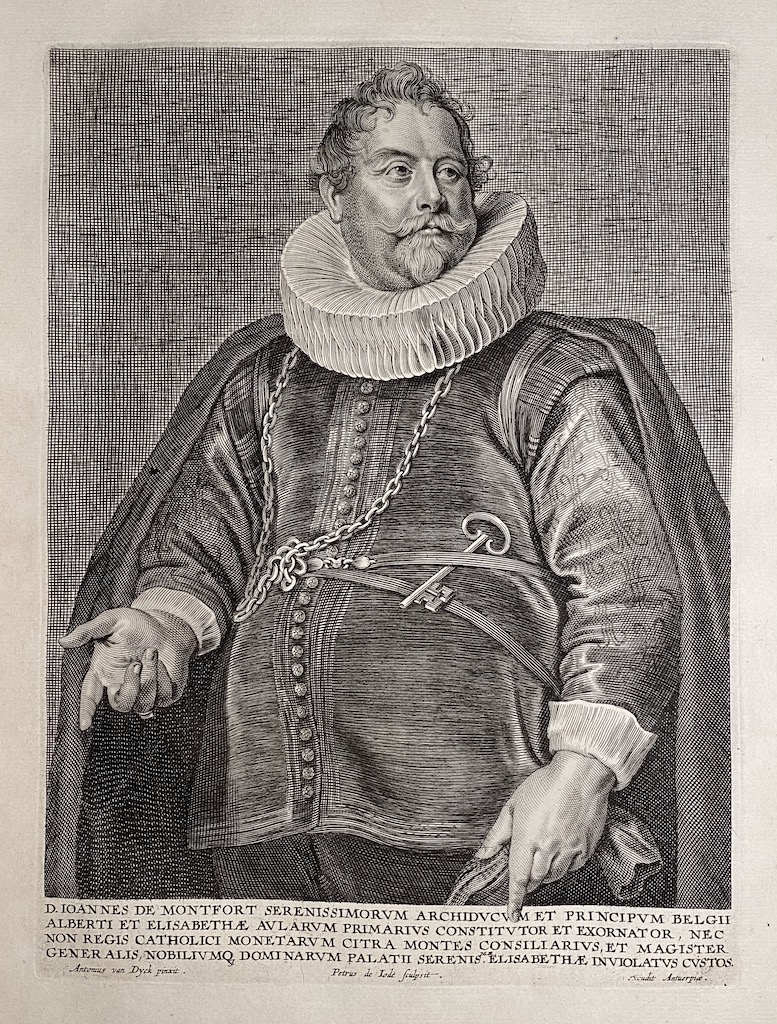
12. Jan van Montfort [Jean de Montfort] (Flemish, 1567 – 1648); engraved by Pieter de Jode II (Flemish, 1606 – 1670/74). Inscription: “D. IOANNES DE MONTFORT SERENISSIMORVM ARCHIDVCVM ET PRINCIPVM BELGII | ALBERTI ET ELISABETHÆ AVLARVM PRIMARIVS CONSTITVTOR ET EXORNATOR, NEC | NON REGIS CATHOLICI MONETARVM CITRA MONTES CONSILIARIVS, ET MAGISTER. | GENERALIS, NOBILIVMQ3 DOMINARVM PALATII SERENIS.MÆ ELISABETHÆ INVIOLATVS CVSTOS.” Below: “Antonius van Dyck pinxit.” <–> “Petrus de Iode sculpsit.” <–> “…excudit Antuerpiæ”. Second state with “Ioannes Meyssens” erased. 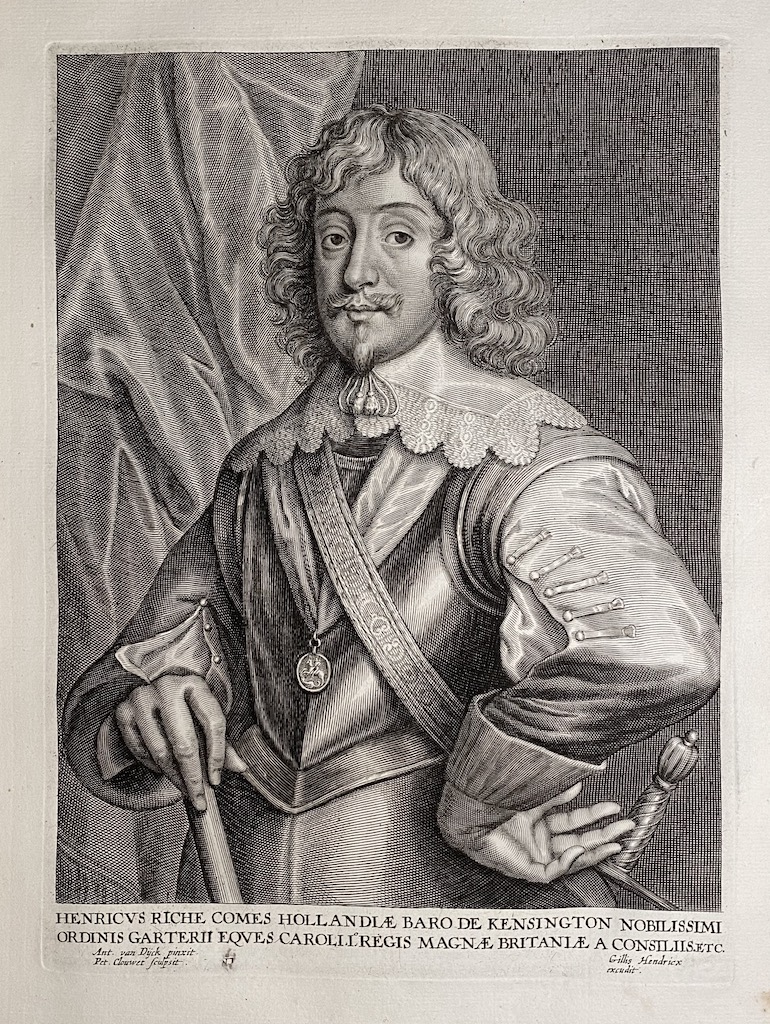
13. Henry Rich, 1st Earl of Holland (British, 1590 – 1649), engraved by Pieter Clouwet (Flemish, 1629 – 1670). Inscription: “HENRICVS RICHE COMES HOLLANDIÆ BARO DE KENSINGTON NOBILISSIMI | ORDINIS GARTERII EQVES CAROLI. LOREGIS MAGNÆ BRITANIÆ A CONSILIIS. ETC.”. Below: “Ant. van Dÿck pinxit.” | “Pet. Clouwet sculpsit” <–> “Gillis Hendricx | excudit”. Third state with the title added and production details re-engraved. 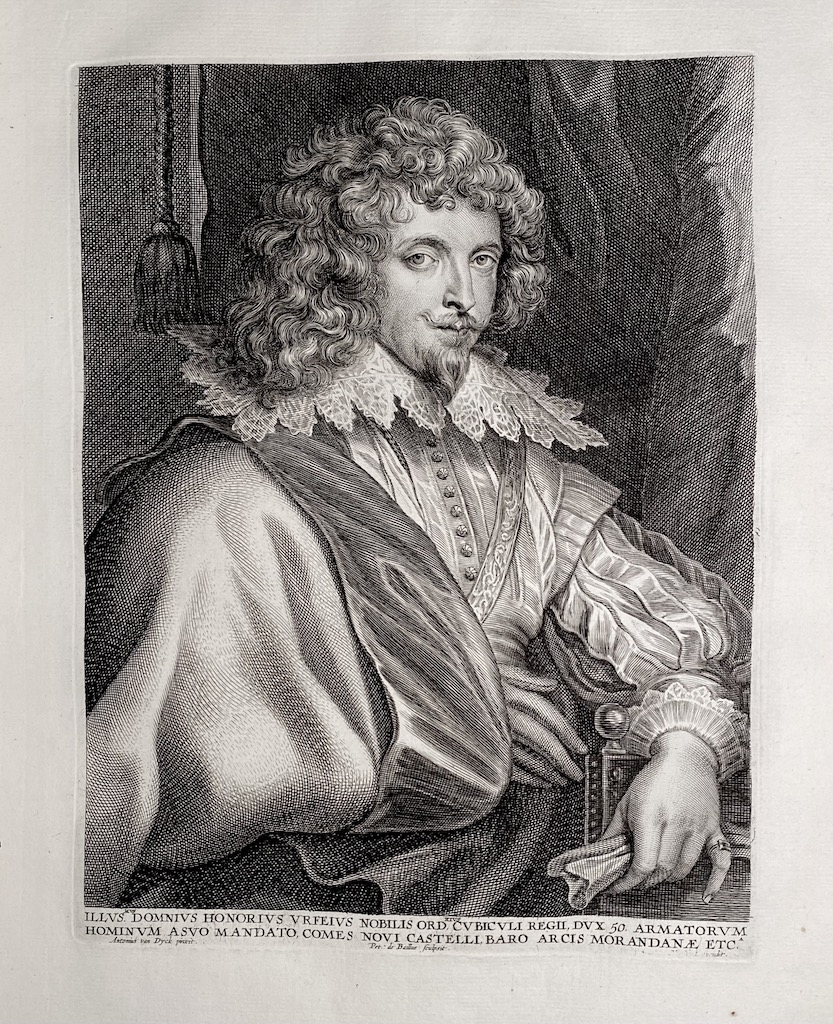
14. Honoré d’Urfé, marquis de Valromey, comte de Châteauneuf (French, 1568 – 1625); engraved by Pieter de Bailliu (Flemish, 1613 – 1660). Inscription: “ILLVS.MVS DOMNIVS HONORIVS VRFEIVS NOBILIS ORD.RIVS CVBICVLI REGII, DVX 50. ARMATORVM | HOMINVM A SVO MANDATO, COMES NOVI CASTELLI, BARO ARCIS MORANDANÆ ETC.A”. Below: “Antonius van Dyck pinxit” <–> “Pet. de Bailliue sculpsit.” <–> “… excudit”. Second lettered state with title and production details, with “Ioannes Meyssens” erased. [There is another copy in this binding, №54, where Ioannes Meysens' name is in place]. 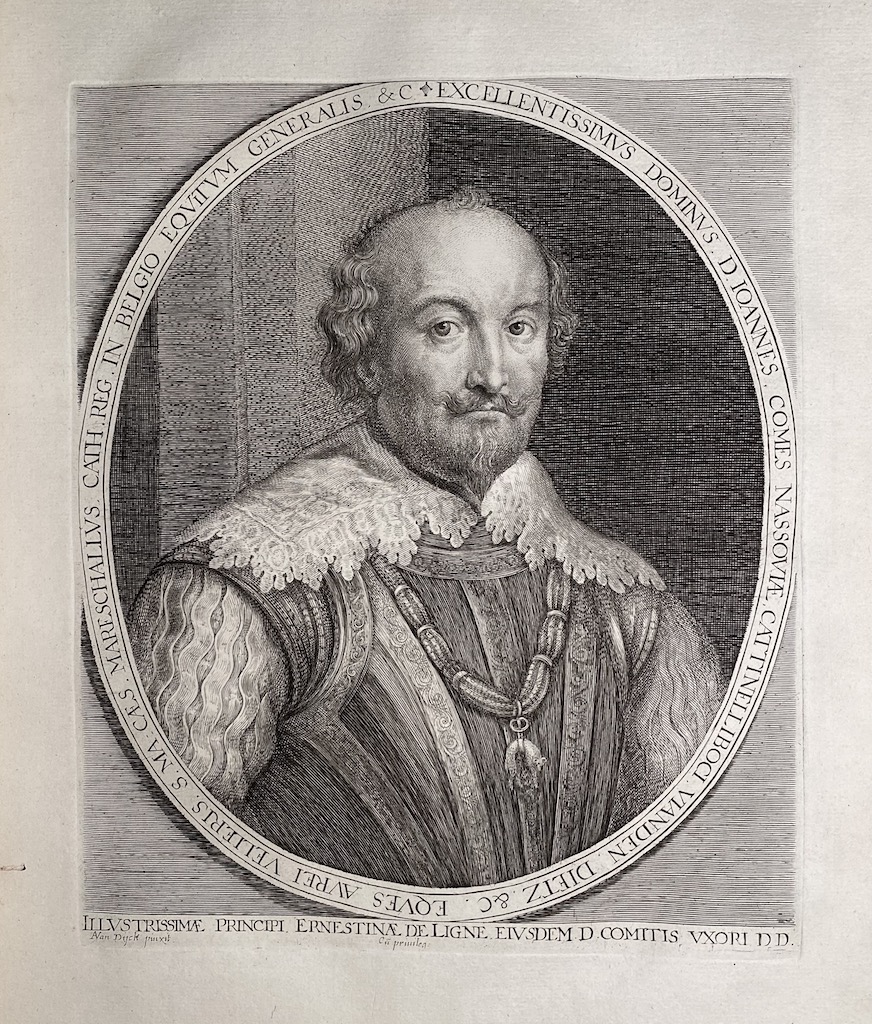
15. Johannes [John VIII], Count of Nassau-Siegen (German, 1583 – 1638); engraved by Lucas Vorsterman I (Flemish, 1595 – 1675). Inscription: in the oval around the portrait “EXCELLENTISSIMVS DOMINVS: D. IOANNES, COMES NASSAOVIÆ, CATTNELLIBOCI: VIANDEN, DIETZ, &C. EQVES AVREI VELLERIS. S. MA: CÆS, MARESCHALIVS, CATH. REG. IN BELGIO. EQVITVM GENERALIS. &C”, in lower margin: “ILLVSTRISSIMÆ PRINCIPI ERNESTINÆ DE LIGNE EIVSDEM D. COMITIS VXORI DD.”, and “AVan Dÿck pinxit.” <–> “Cu Priuleg”. Fourth state with Vorsterman’s address burnished. [For the third state with “Lucas Vorsterman exc” present see № 55]. 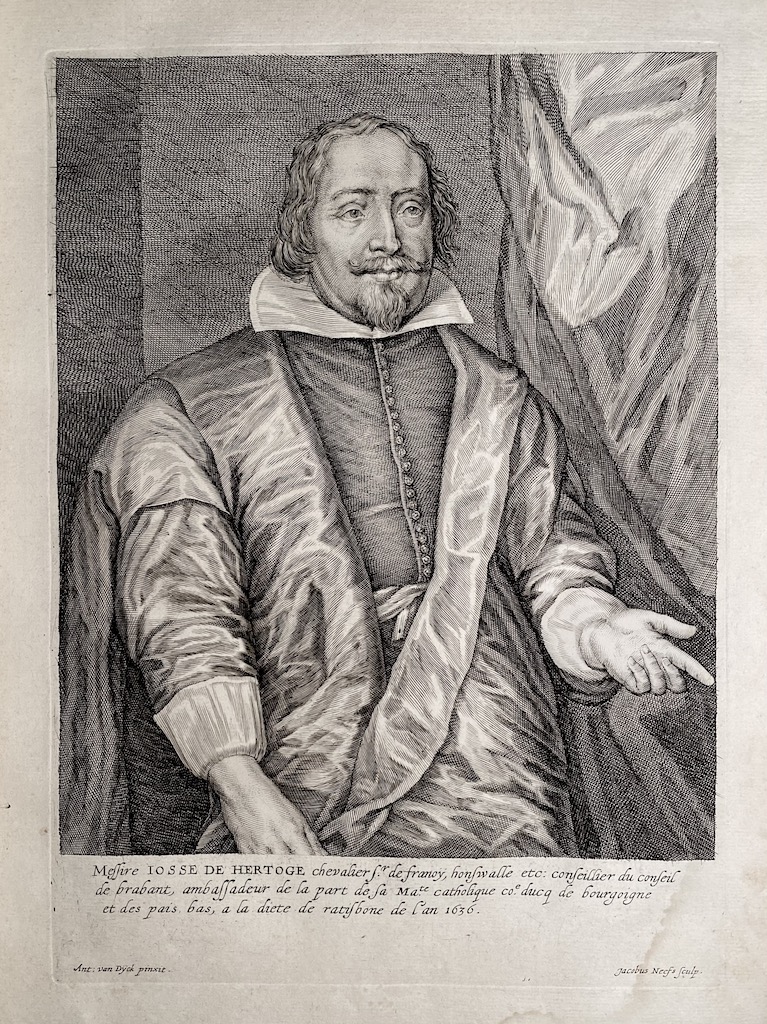
16. Joost de Hertoghe (Flemish, ? –1638); engraved by Jacobus Neefs. Inscription: "Me∫∫ire IOSSE DE HERTOGE chevalier ∫.r de franoÿ, hon∫walle etc: con∫eillier du conseil | de brabant, amba∫∫adeur de la part de ∫a Ma.te catholique co.e ducq de bourgoigne | et des pais bas, a la diete de rati∫bone de l'an 1636." In Lower margine: "Ant: van Dÿck pinxit.", <–>"Jacobus Neefs ∫culp.". Second, lettered state with the title and production details added. 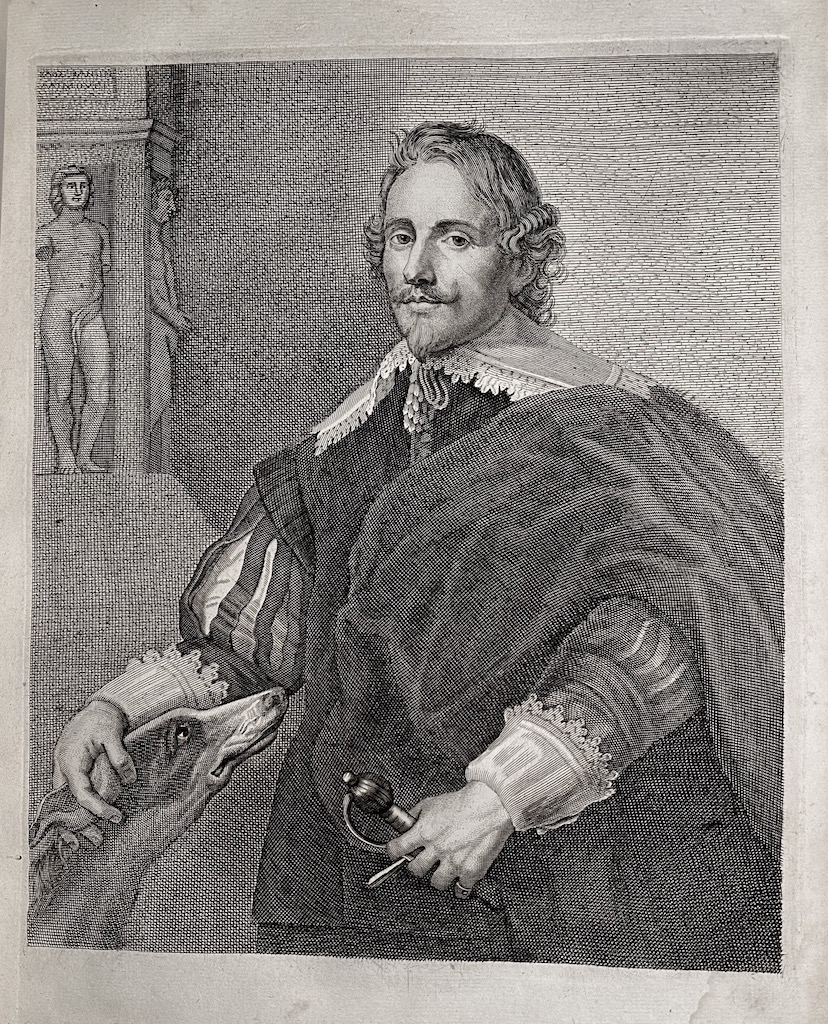
17. Philippe Le Roy (Flemish, 1596 – 1679). No inscription. The printmaker is unidentified but is possibly Adriaen Lommelin. The print is a copy of the print by Vorsterman and Pontius. 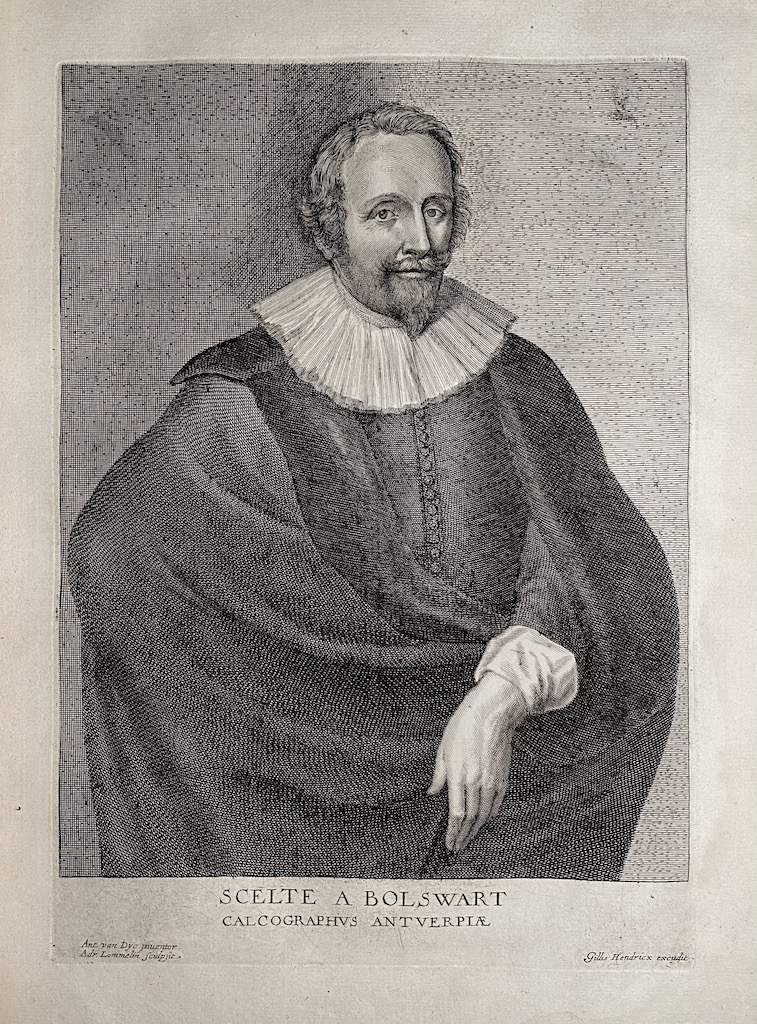
18. Schelte Adamsz. Bolswert (Flemish, c. 1586 – 1659); engraved by Adriaen Lommelin, published by Gillis Hendricx. Inscription: “SCELTE A BOLSWART | CALCOGRAPHVS ANTVERPIÆ”. In lower margin: “Ant. van Dÿc inuentor | Adr. Lommelin sculpsit” <–> “Gillis Hendricx excudit”. Third state with an entirely different head, title and production details added. 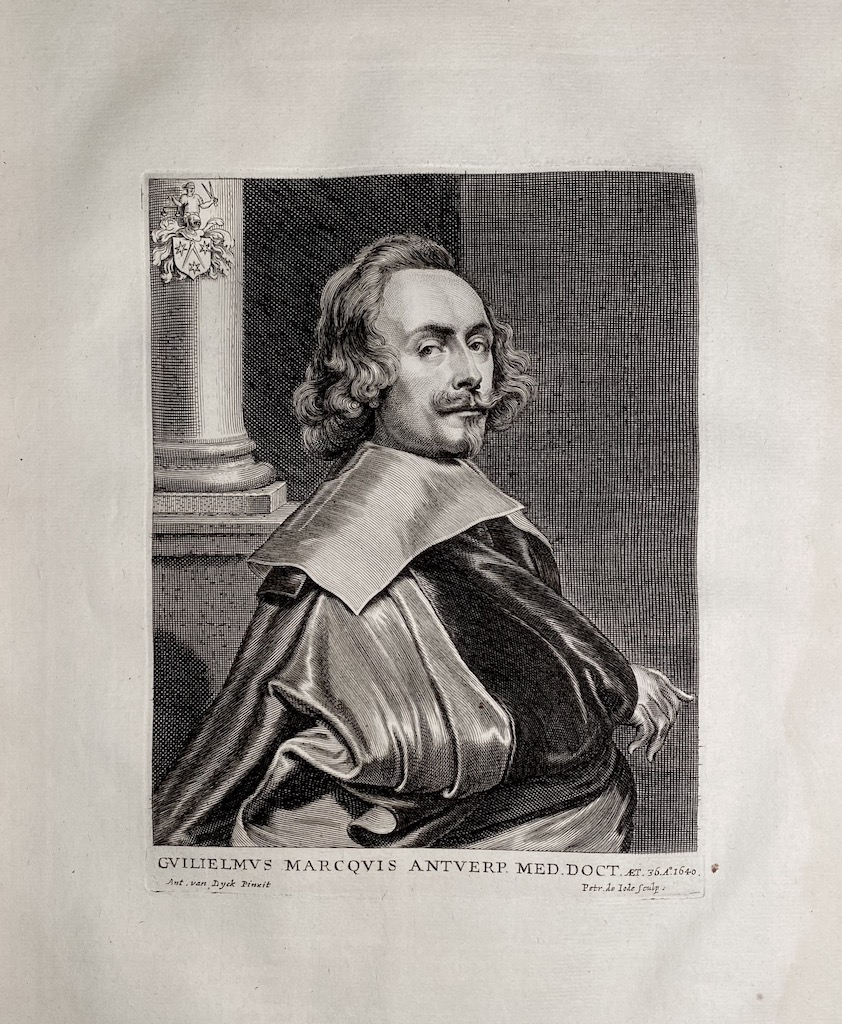
19. Willem Marquis (Flemish, 1604 – 1640); engraved by Pieter de Jode II. Inscription: “GVILIELMVS MARCQUIS ANTVERP. MED. DOCT. ÆT. 36.A.O 1640.” In lower margin: “Ant. van Dyck Pinxit” <–> “Petr. de Iode sculp.”. Second, lettered state with Borreken’s name burnished and replaced by Van Dyck’s. 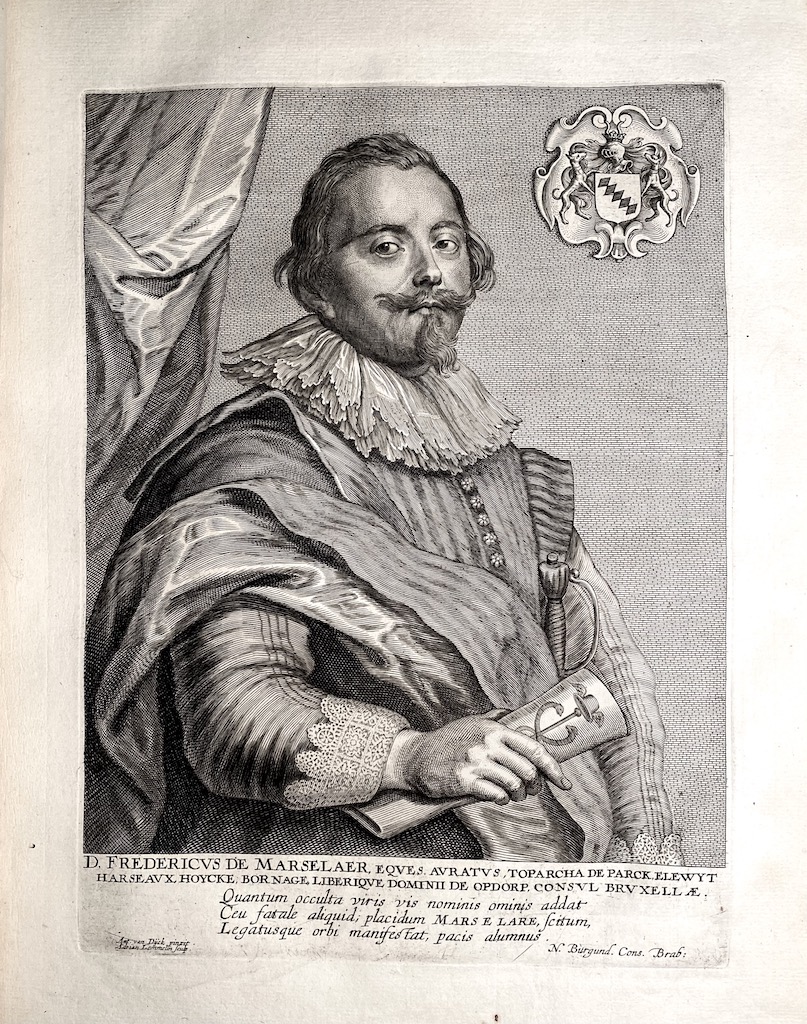
20. Frederik de Marselaer (Flemish, 1584 – 1670); engraved by Adriaen Lommelin. Inscription: “D. FREDERICVS DE MARSELAER, EQVES AVRATVS, TOPARCHA DE PARCK, ELEWYT | HARSEAVX, HOYCKE, BORNAGE, LIBERIQUE DOMINII DE OPDORP, CONSVL BRVXELLÆ.” Three lines of verse below: “Quantum occulta viris vis nominis ominis addat | Ceu fatale aliuid; placidum Mars E Lare, scitum, | Legatusue orbi manifestat, pacis alumnus.”. In lower margin: “Ant. van Dÿck pinxit | Adrian Lommelin sculpsit” <–> “N. Burgund. Cons. Brab:”. Third state with the roll of paper rounded. 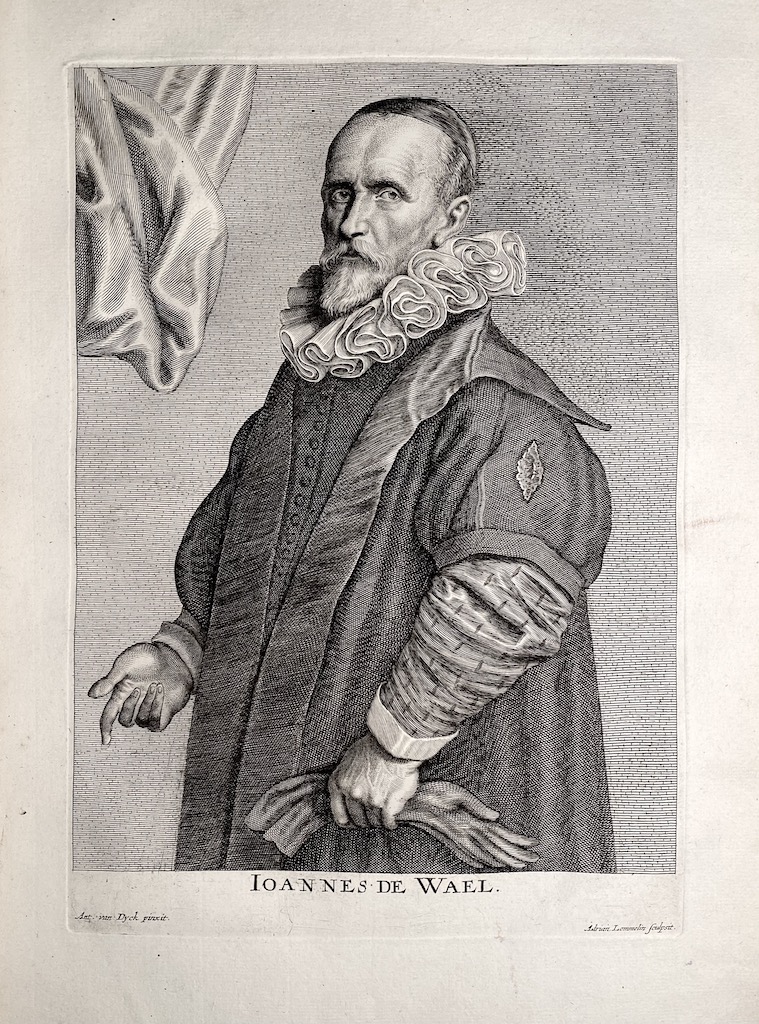
21. Jan Baptist de Wael I (Flemish, 1558 – 1633); engraved by Adriaen Lommelin. Inscription: “IOANNES DE WAEL.”. In lower margin: “Ant. van Dyck pinxit.”<–> and “Adrian Lommelin sculpsit.”. Second, lettered state with the title and production details. British Museum № 1872,1012.4168. 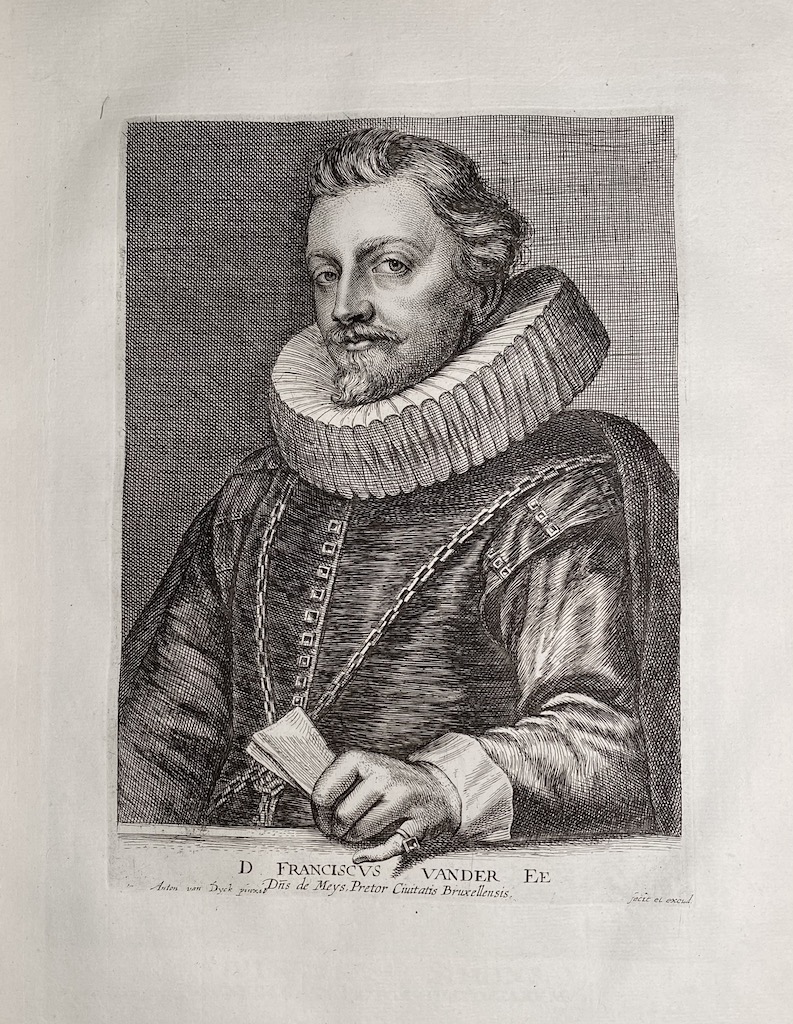
22. François van der Ee (Flemish, ? – 1645); engraved and published by Johannes Meyssens. Inscription: “D . FRANCISCVS VANDER EE | Dñs de Meys, Pretor Ciuitatis Bruxellensis”. In lower margin: “Anton van Dyck pinxit”, and “fecit et excud.”. Fourth, lettered state, finished with the burin, with second line added to the title, with address “Ioannes Meyssens” almost completely burnished. 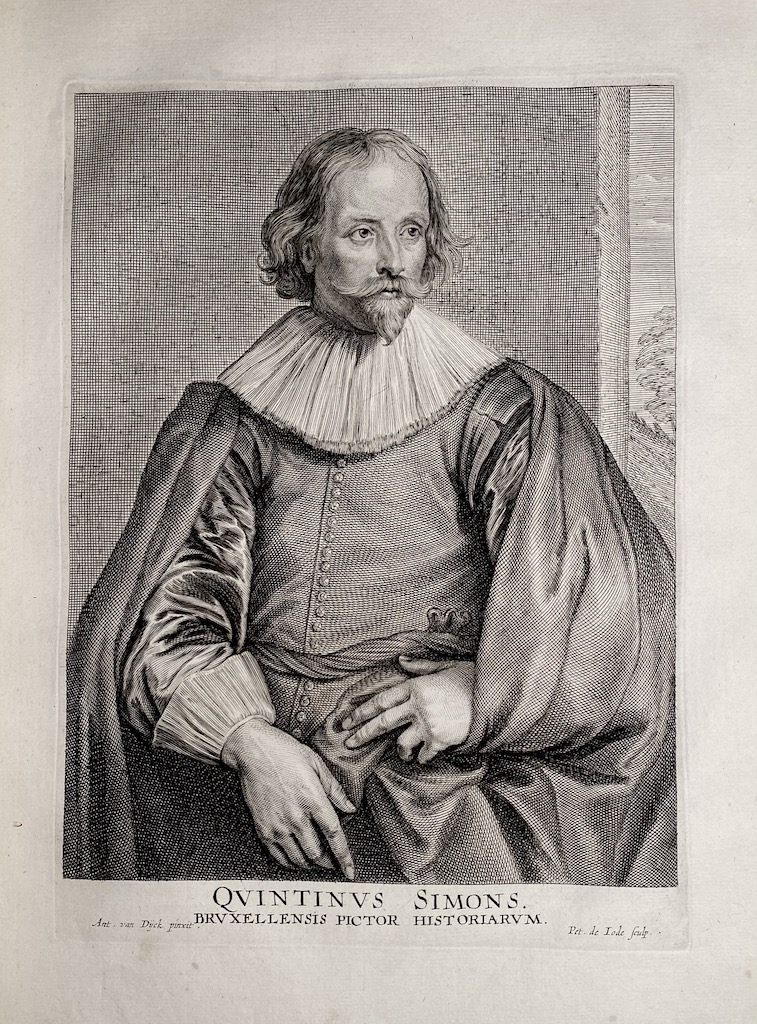
23. Quintijn Simons (Flemish, 1592 – after 1634); engraved by Pieter de Jode II. Inscription: “QVINTINVS SIMONIS. | BRVXELLENSIS PICTOR HISTORIARVM.”. In lower margin: “Ant. van Dijck pinxit.” <–> “Pet. de Iode sculp.”. Third state with second line of title added. 
24. Adriaan Stevens (Flemish, 1561 – 1640); engraved by Adriaen Lommelin. Inscription: "INTEGERRIMVS VIR ADRIANVS STEVENS / S.P.Q. ANTVERP. AB ELEMOSYNIS.". In lower margin:"Ant van Dÿc pinxit." <–> "A. Lommelin sculp.". British Museum # R,1b.20. 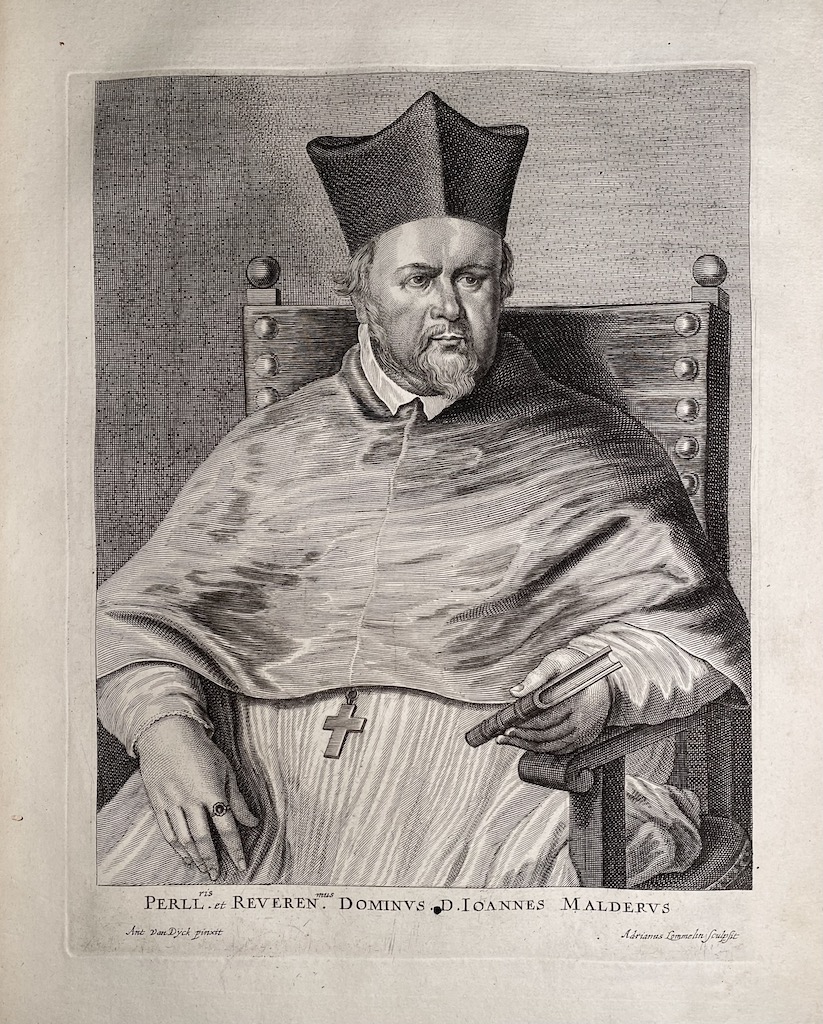
25. Jan van Malderus (Flemish, 1563 – 1633); engraved by Adriaen Lommelin. Inscription: “PERLL.ris et REVEREN.mus DOMINVS. D. IOANNES MALDERVS”. In lower margin: “Ant Van Dÿck pinxit” <–> “Adrianus Lommelin sculpsit”. 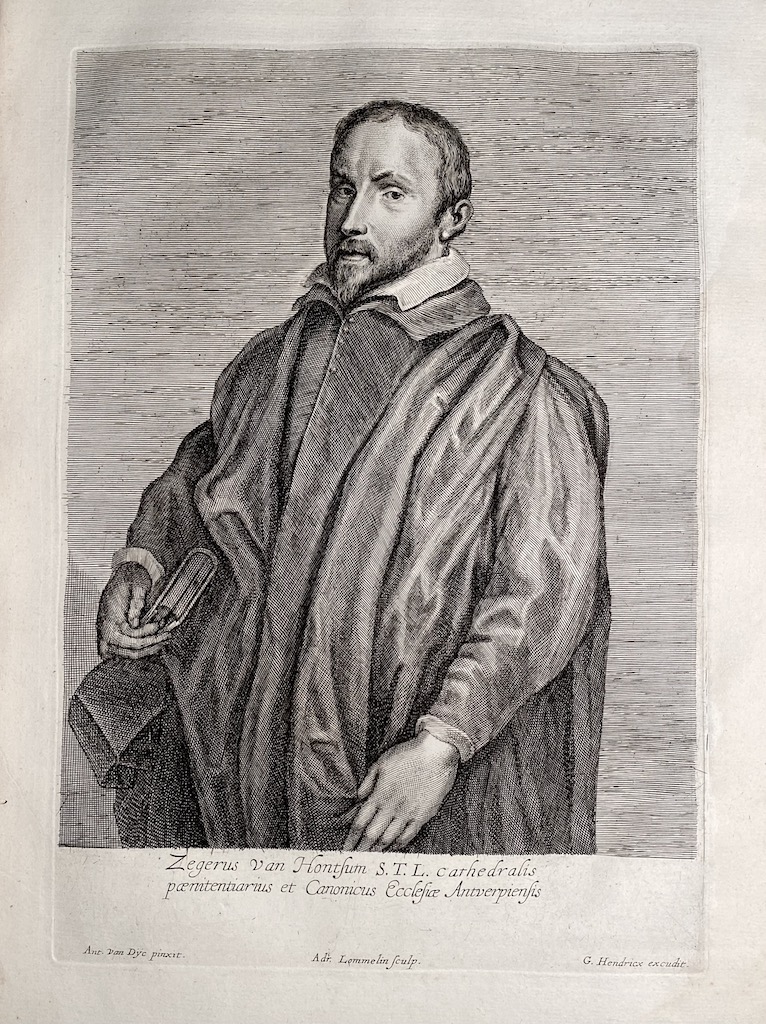
26. Zeger van Hontsum (Flemish, ? – -1643). Engraved by Adriaen Lommelin, published by Gillis Hendricx. Inscription: “Zegerus van Hontsum S.T.L. cathedralis | pænitentiarius et Canonicus Ecclesiæ Antuerpiensis”. In lower margin: “Ant. van Dÿc pinxit” <–> “Adr. Lommelin sculp.” <–> “G. Hendricx excudit”. 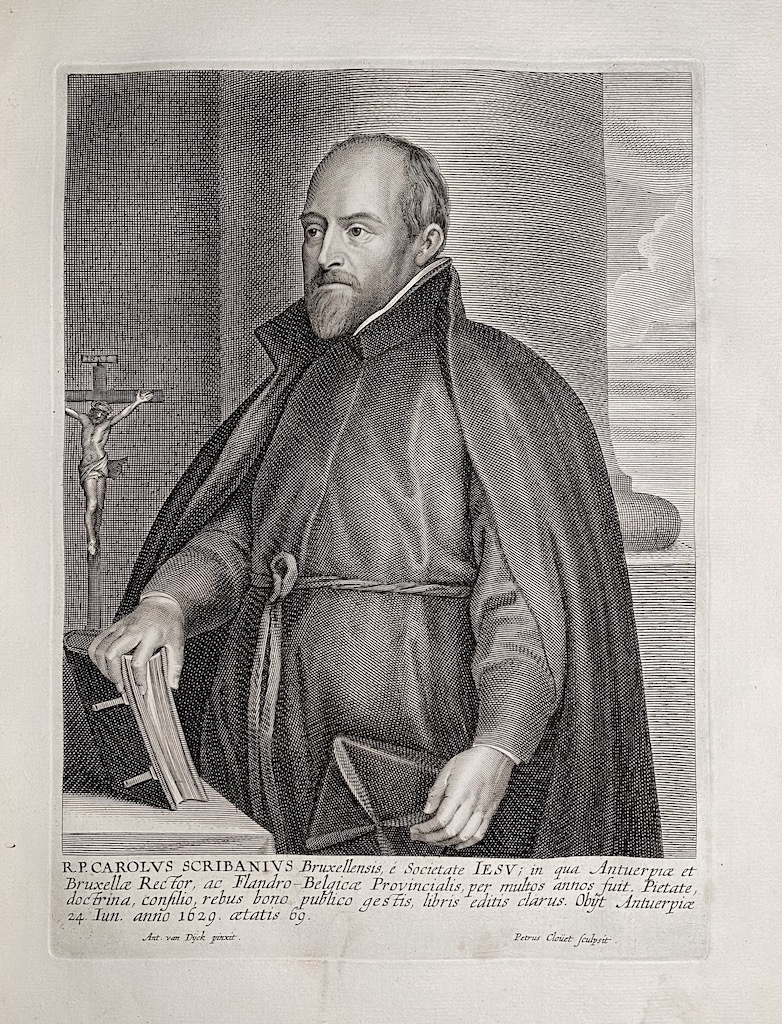
27. Carolus Scribani (Flemish, 1561 – 1629); engraved by Pieter Clouwet. Inscription: “R. P. CAROLVS SCRIBANIVS Bruxellensis, é Societate IESV; in qua Antuerpiæ et I Bruxellæ Rector, ac Flandro-Belgicæ Provincialis, per multos annos fuit. Pietate, | doctrina, consilio, rebus bono publico gestis, libris editis clarus. Obijt Antverpiæ | 24. Iun. anno 1629. ætatis 69.”. In lower margin: “Antonius van Dÿck pinxit.” <–> “Petrus Cloüet Sculpsit.”. Second, lettered state with the title and production details. 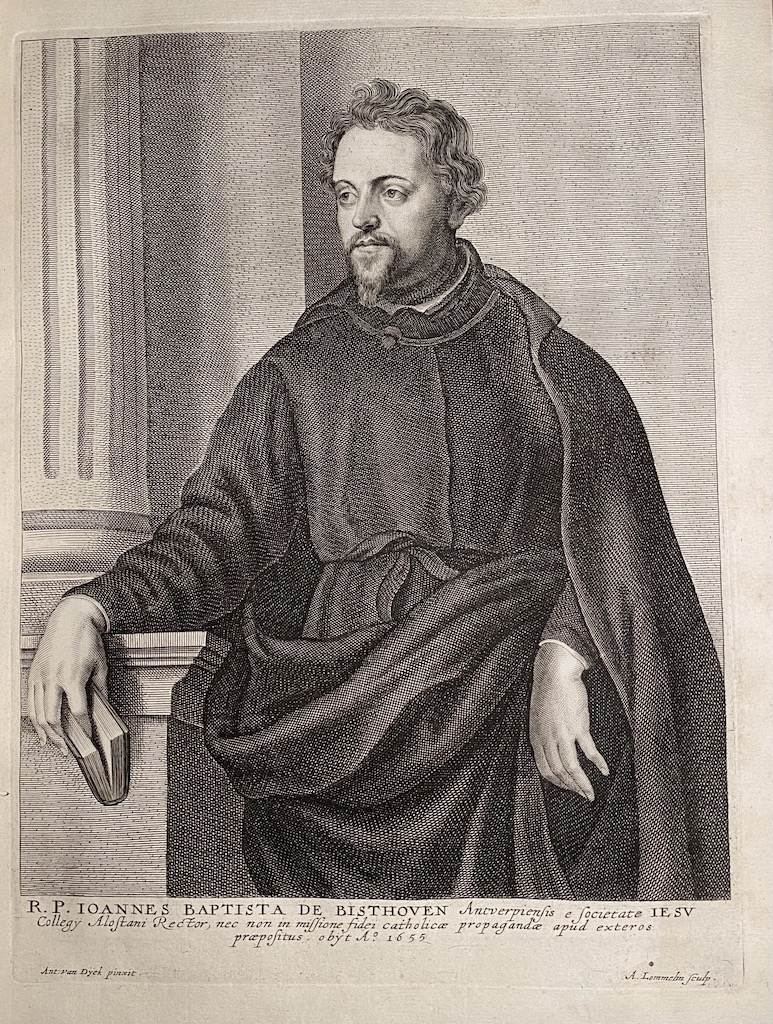
28. Jan Baptist van Bisthoven (Flemish, 1602 – 1655); engraved by Adriaen Lommelin. Inscription: “R.P. IOANNES BAPTISTA DE BISTHOVEN Antverpiensis e societate IESV | Collegÿ Alostani Rector, nec non in missione fidei catholicæ propagandæ apud exteros | præpositus obÿt A.o 1655”. In lower margin: “Ant:van Dÿck pinxit”, and “A. Lommelin sculp”. Second, lettered state with the title and production details. 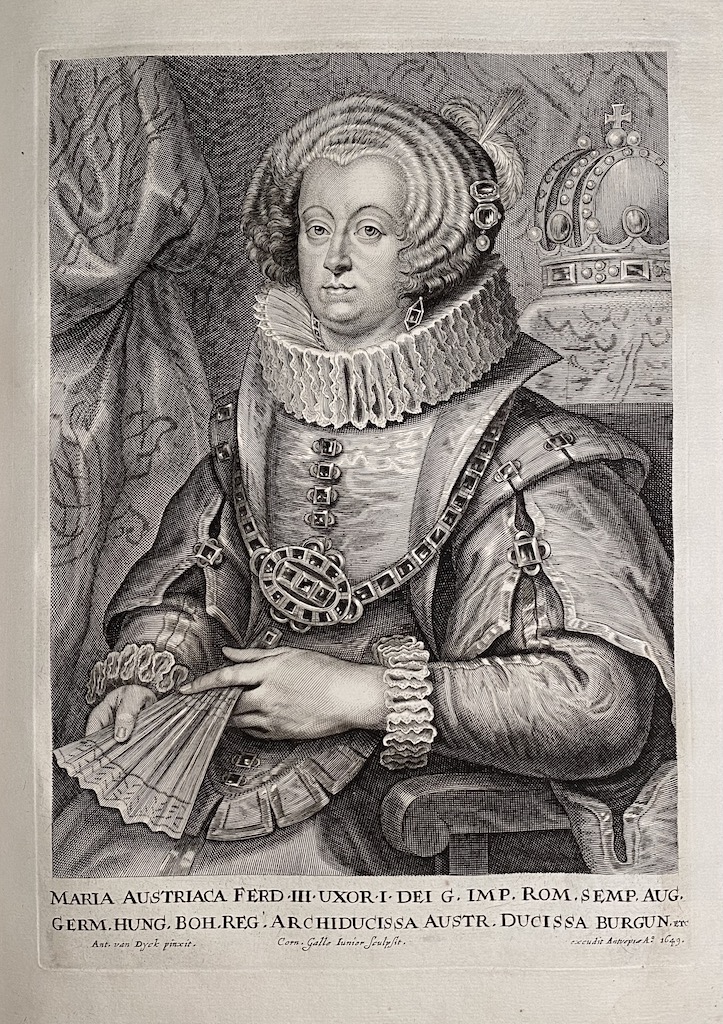
29. Maria of Austria (Spanish, 1606 – 1646); engraved by Cornelis Galle the Younger, published by Johannes Meyssens. Inscription: “MARIA AUSTRIACA FERD. III. UXOR. I. DEI G. IMP. ROM. SEMP. AUG. | GERM. HUNG. BOH. REG. ARCHIDUCISSA AUTR. DUCISSA BURGUN. ETC”. In lower margin: “Ant. van Dyck pinxit.” <–> “Corn. Galle Iunior sculpsit.” <–> “...excudit Antuerpiæ A.o 1649”. Third, lettered state with Meyssens’ name burnished badly. 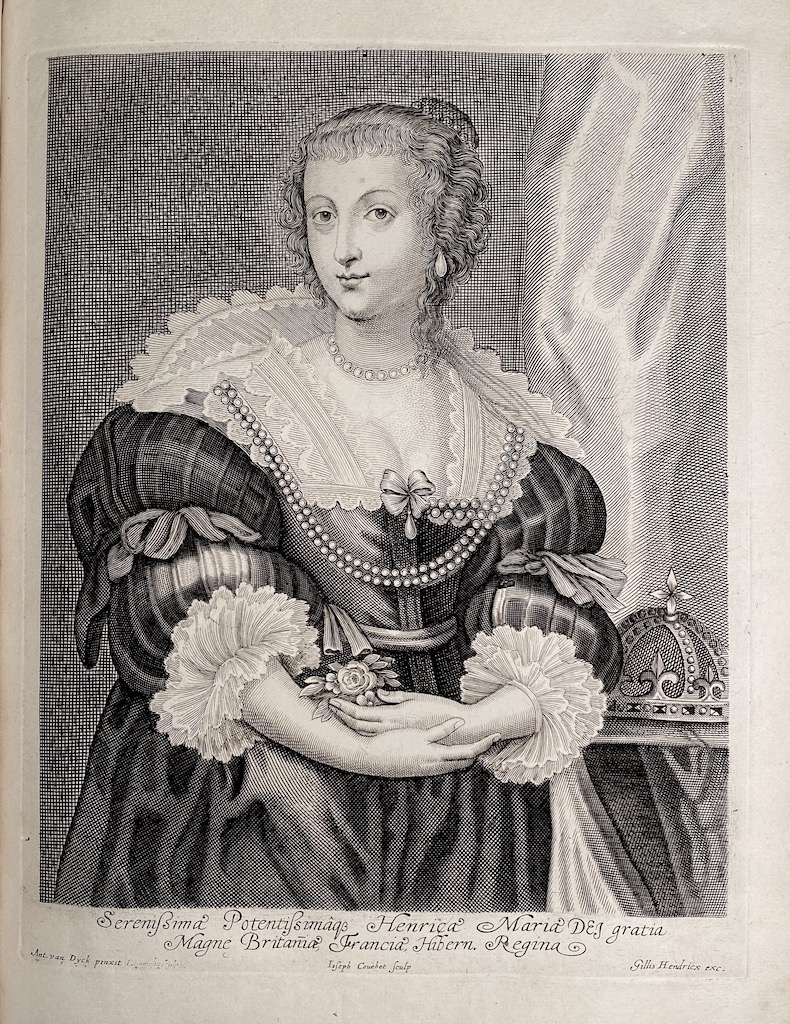
30. Henriette Marie de Bourbon, Queen of Charles I (French, 1609 – 1669); engraved by Antoine Couchet and Adriaen Lommelin, published by Gillis Hendricx. Inscription: “Serenißima Potenti∫simâq Henrica Maria Dei gratia | Magne Britaniæ, Franciæ, Hibern. Regina”. In lower margin: “Ant. van Dyck pinxit” <–> “Ioseph Couchet sculp” <–> “Gillis Hendricx exc.”. State with “Lommelin sculp.” right after “Ant. van Dyck pinxit” burnished, but still legible. 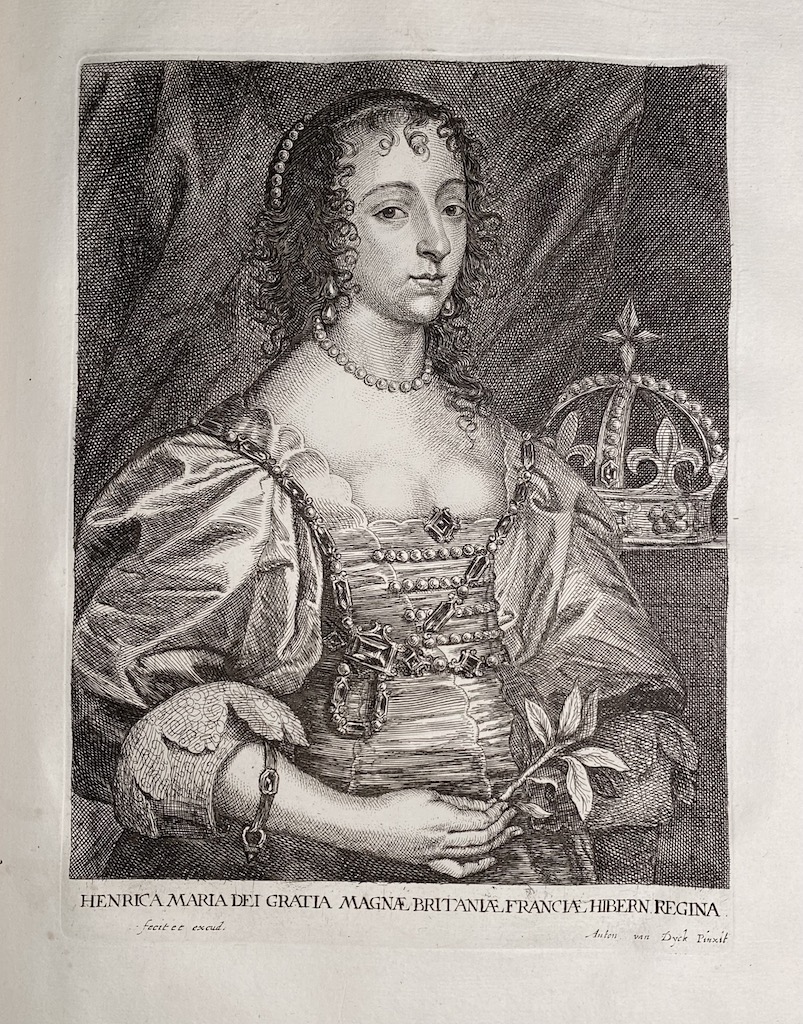
31. Henriette Marie de Bourbon, engraved and published by Ioannes Meyssens. Inscription: “HENRICA MARIA DEI GRATIA MAGNÆ BRITANIÆ FRANCIAÆ HIBERN. REGINA.”. In lower margin: “fecit et excud.” <–> “Anton van Dyck Pinxit”. Third state, finished with a burin; with Meyssens’ name burnished. [Similar to print №62 which has "Ioan. Mey∫ens" signature present]. 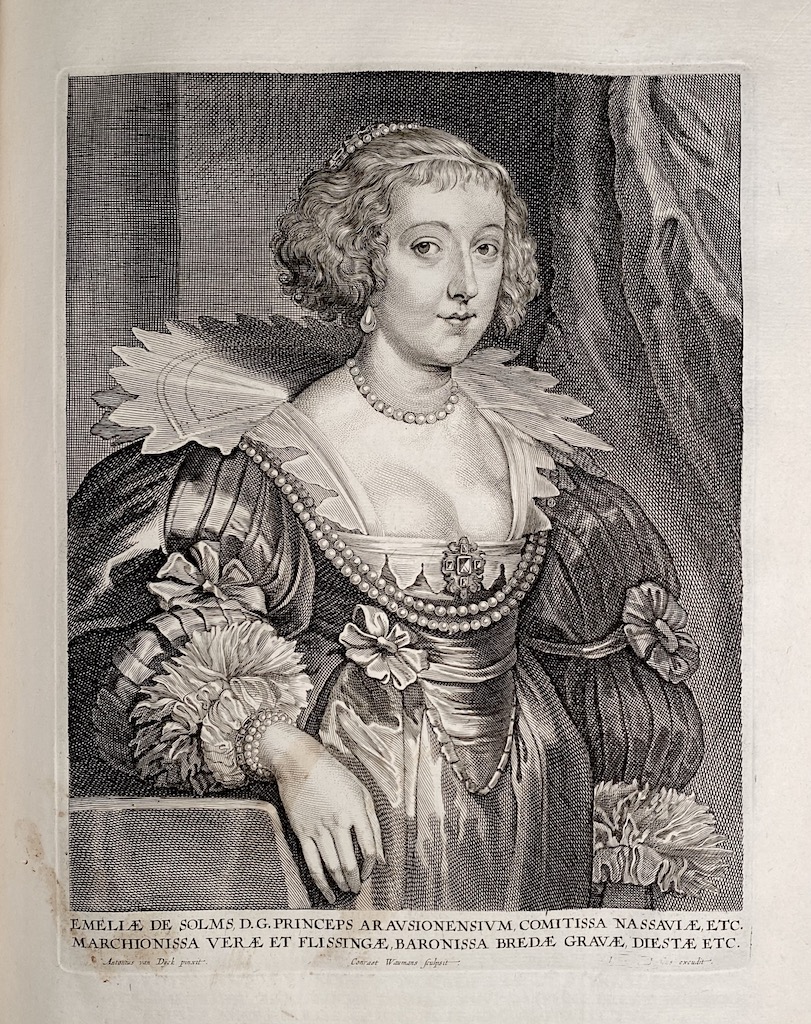
32. Amalia van Solms, Princess of Orange (German, 1602 – 1675), engraved by Conraad Waumans and published by Johannes Meyssens. Inscription: “EMELIÆ DE SOLMS, D. G. PRINCPES ARAVSIONENSIVM, COMITISSA NASSAUVIÆ, ETC. | MARCHIONISSA VERÆ ET FLISSINGÆ, BARONISSA BREDÆ, GRAVÆ, DIESTÆ ETC.”. In lower margin: “Antonius van Dijck pinxit.” <–> “Conraet Waumans sculpsit.” <–> “… excudit”. First, lettered state with the title and production details, with Meyssens’ name burnished. [Similar to №66, which has Ioannes Meysens name present]. 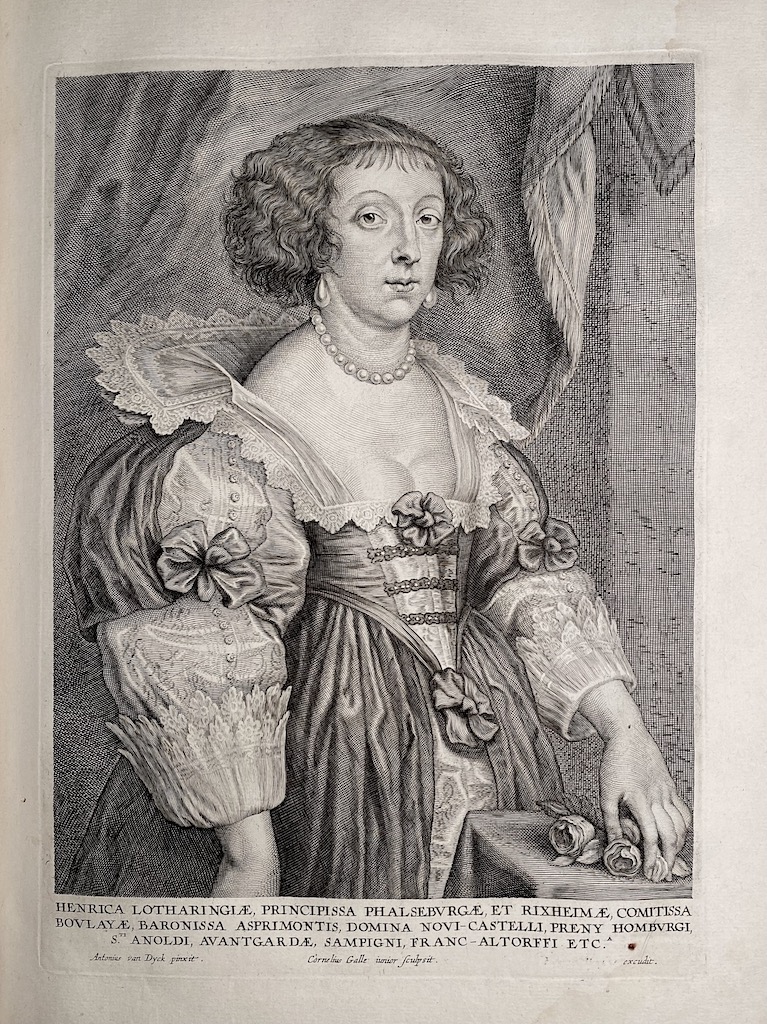
33. Henriette de Lorraine, Princess of Phalsbourg (or Pfalzburg) (French, 1605 – 1660); engraved by Cornelis Galle the Younger, published by Ioannes Meyssens. Inscription: “HENRICA LOTHARINGIÆ, PRINCIPISSA PHALSEBVRGÆ, ET RIXHEIMÆ, COMITISSA | BOVLAYÆ, BARONISSA ASPIRIMONTIS, DOMINA NOVI-CASTELLI, PRENY | HOMBVRGI, S.TI ANOLDI, AVANTGARDÆ, SAMPIGNI, FRANC-ALTORFFI ETC.A”. In lower margin: “Antonius van Dyck pinxit.” <–> “Cornelius Galle iunior sculpsit.” <–> “… excudit.”. First state with the title and production details, with Ioannes Meyssens’ name burnished. British Museum # R,1a.248. 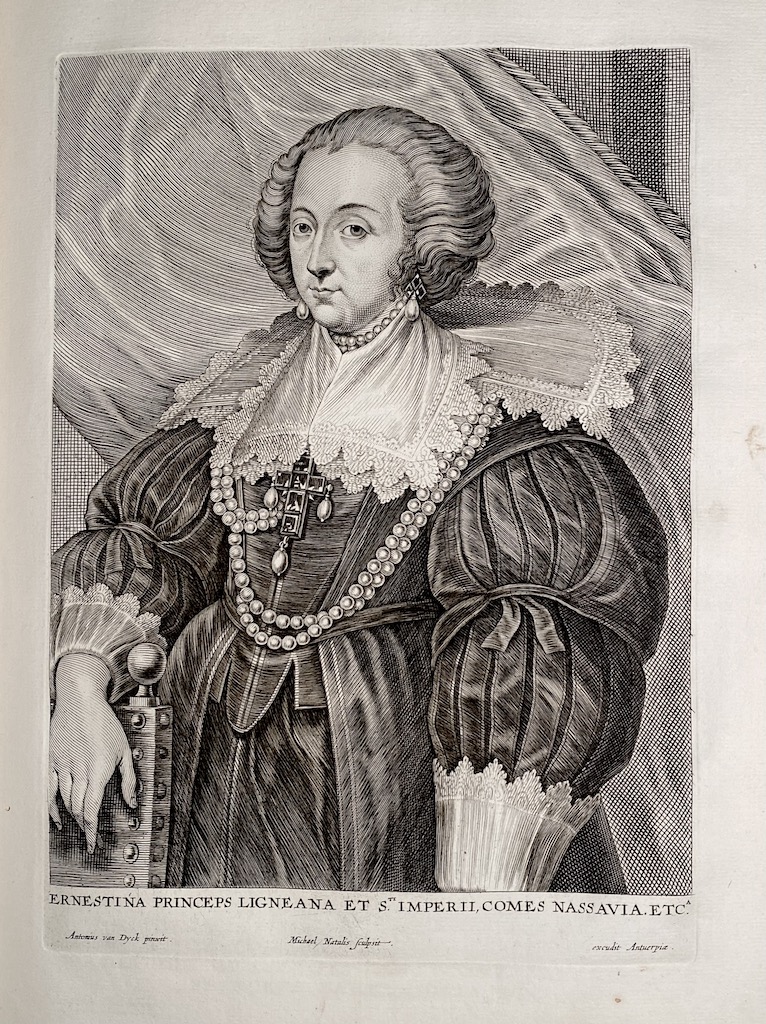
34. Ernestine Yolande de Ligne, Countess of Nassau-Siegen (Flemish, 1594 – 1668); engraved by Michiel Natalis, published by Jan Meyssens. Inscription: “ERNESTINA PRINCEPS LIGNEANA ET S.TI IMPERII, COMES NASSAVI. ETC.A”. In lower margin: “Antonius van Dyck pinxit.” <–> “Michael Natalis sculpsit.” <–> “…excudit Antuerpiæ.”. Second state with the initials of Ioannes Meyssens erased. 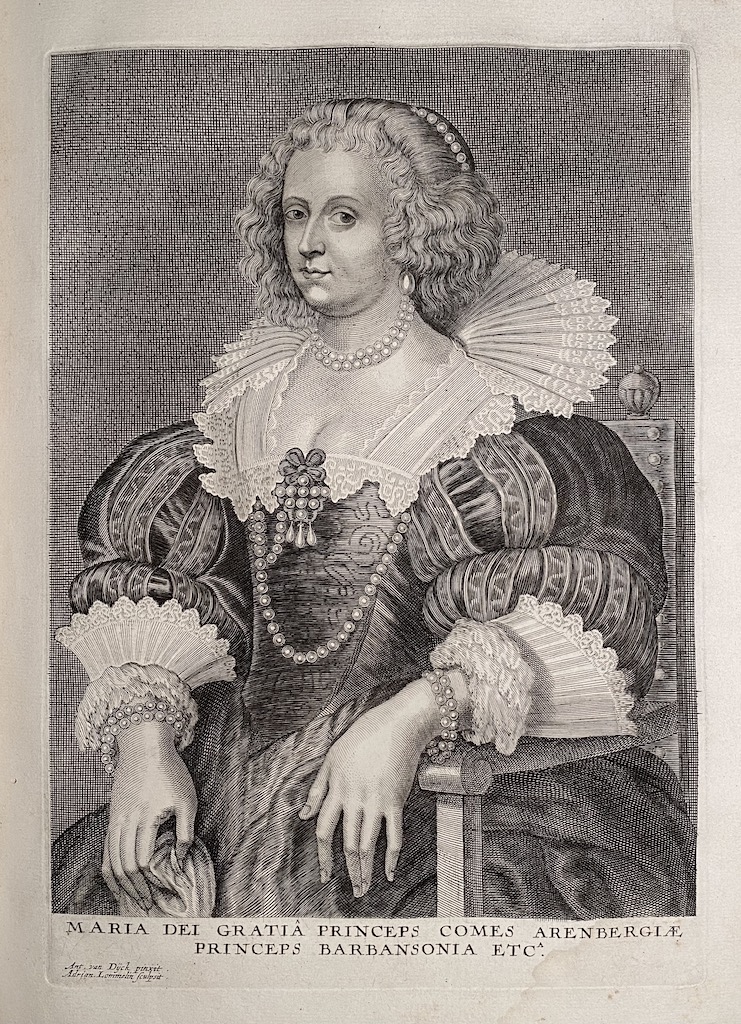
35. Marie de Barbançon, Princess of Arenberg (1602 – 1675); engraved by Adriaen Lommelin. Inscription: “MARIA DEI GRATIÂ PRINCEPS COMES ARENBERGIÆ | PRINCEPS BARBASONIA ETC.A”. In lower margin: “Ant. van Dÿck pinxit. | Adrian. Lommelin sculpsit.”. Second, lettered state with title and production details and adjustments made in the face. British Museum # 1876,1014.181 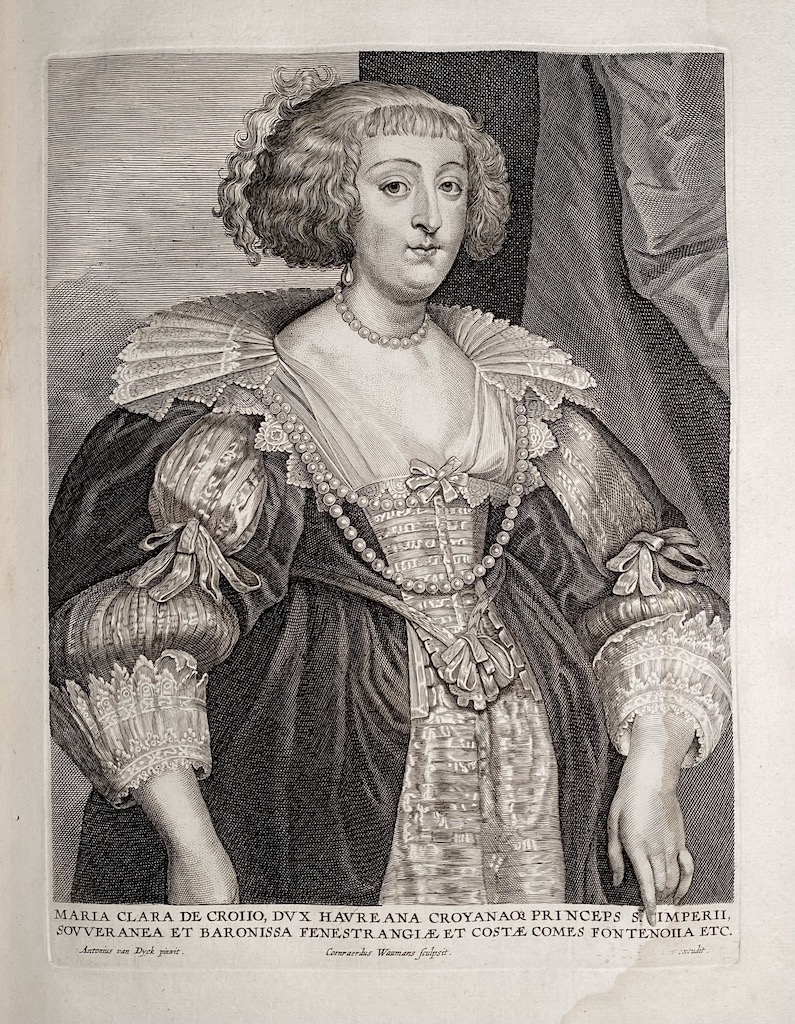
36. Marie-Claire de Croy, Duchess of Havré (Flemish, 1605 – 1664); engraved by Conraad Waumans, published by Ioannes Meyssens. Inscription: “MARIA CLARA DE CROIIO, DVX HAVREANA CROYANAQ3 PRINCEPS STE. IMPERII, | SOVVERANEA ET BARONISSA FENESTRANGIÆ ET COSTÆ COMES FONTENOIIA ETC.”. In lower margin: “Antonius van Dyck pinxit.” <–> “Coenraerdus Waumans sculpsit.” <–> “…excudit.”. Third state with Ioannes Meyssens’ name burnished. British Museum # 1891,1015.21. [Similar to №64, which has Ioannes Meysens’ name present]. 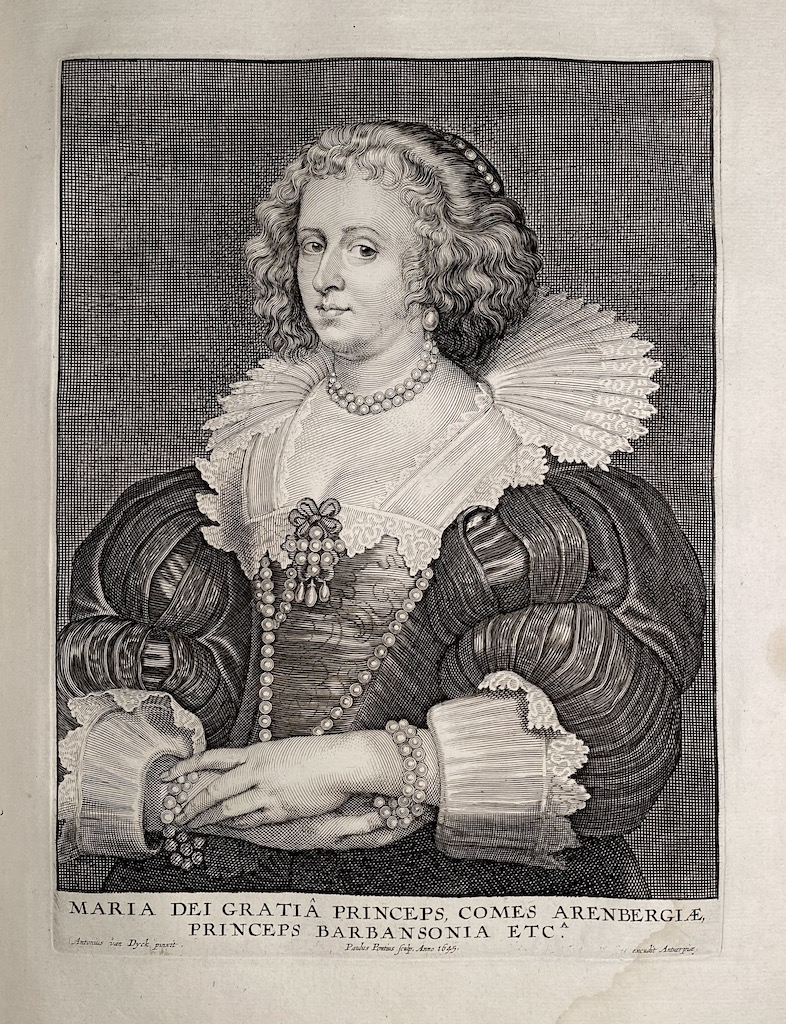
37. Marie de Barbançon, Princess of Arenberg (1602 – 1675); engraved by Paulus Pontius, published by Ioannes Meyssens. Inscription: “MARIA DEI GRATIÂ PRINCEPS COMES ARENBERGIÆ, | PRINCEPS BARBASONIA ETC.A”. In lower margin: “Antonius van Dyck pinxit. | Paulus Pontius sculp. Anno 1645.” <–> “… excudit Antuerpiæ”. Second state with a thick borderline, title and production details added, Ioannes Meyssens’s name burnished. 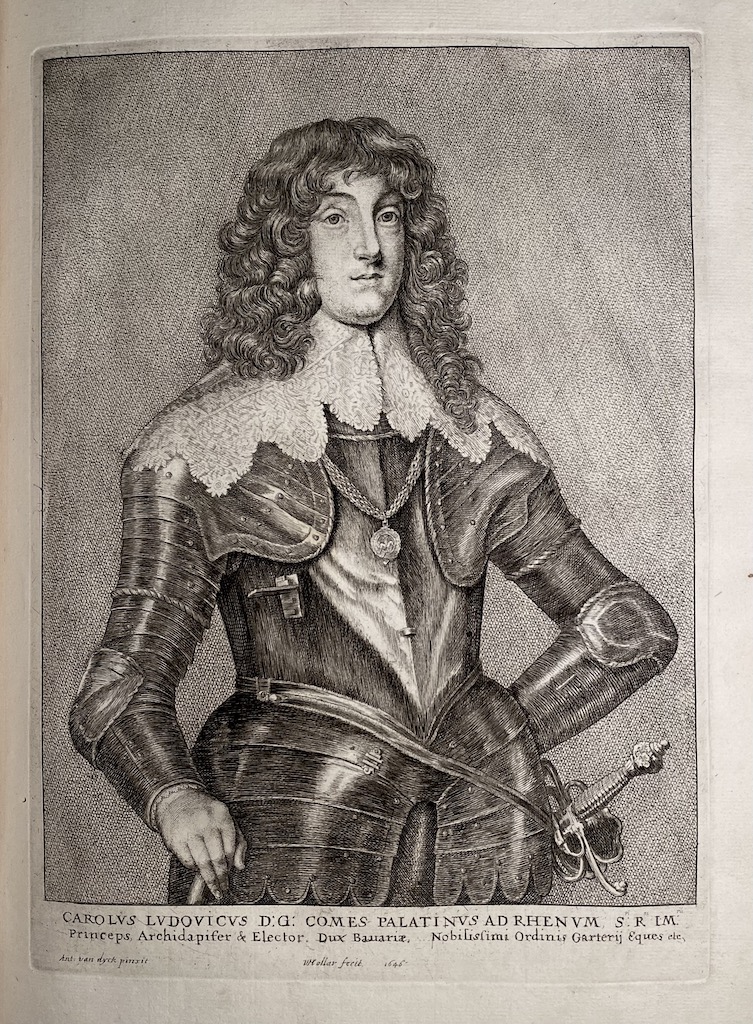
38. Karl I Ludwig, Elector Palatine (German, 1617 – 1680); engraved by Wenceslaus Hollar (Bohemian, 1607 – 1677). Inscription: “CAROLVS LVDOVICVS D:G: COMES PALATINVS AD RHENVM, S:ri R.ni IM:rii | Princeps, Archidapifer & Elector, Dux Bauariæ, …Nobilissimi Ordinis Garterij Eques etc.”. Below: “Ant: van Dyck pinxit” <–> “WHollar fecit,” <–> “1646”. First, lettered state with the title and production details, without “H: van de Borcht excu:”. British Museum # 1867,1012.598. Hendrik van der Borcht II (Dutch, 1614 – c. 1690) 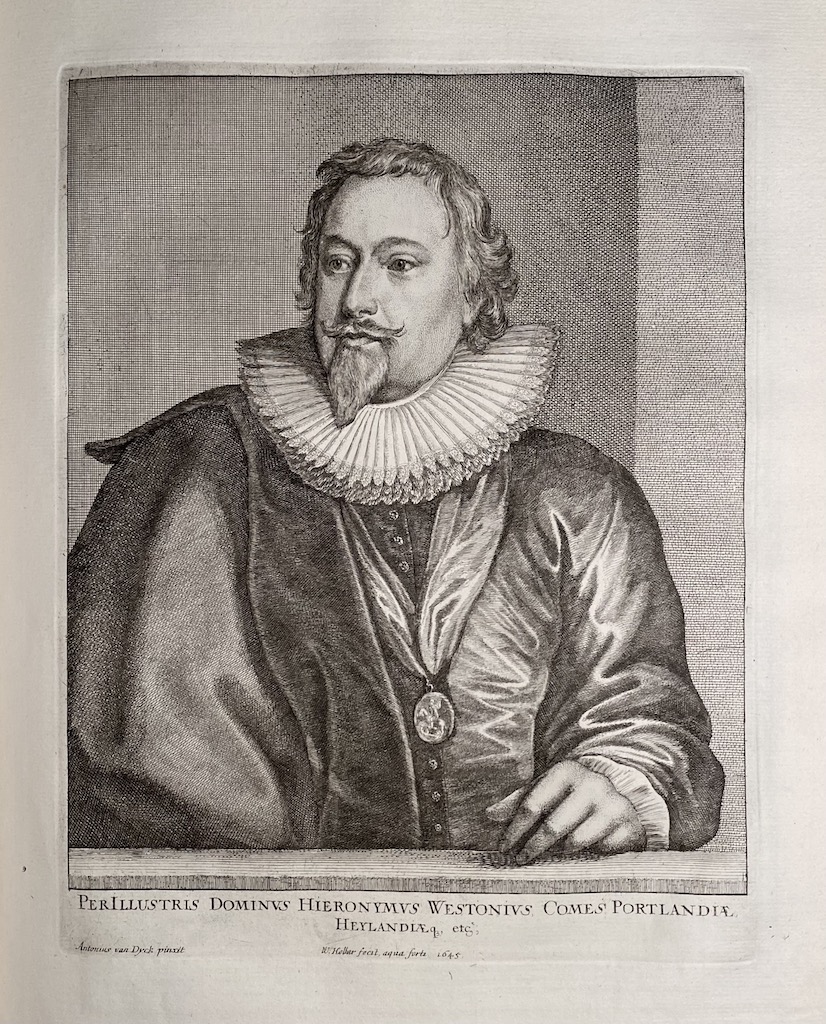
39. Richard Weston, 1st Earl of Portland (British, 1577 – 1635); engraved by Wenceslaus Hollar, published by Ioannes Meyssens. Inscription: “PERILLUSTRIS DOMINVS HIERONYMVS WESTONIVS, COMES PORTLANDIÆ, | HEYLANDÆq3, etc’,”. Below: “Antonius van Dyck pinxit”<–> “W: Hollar fecit, aqua forte. 1645”. Ioannes Meyssens’s name completely burnished. 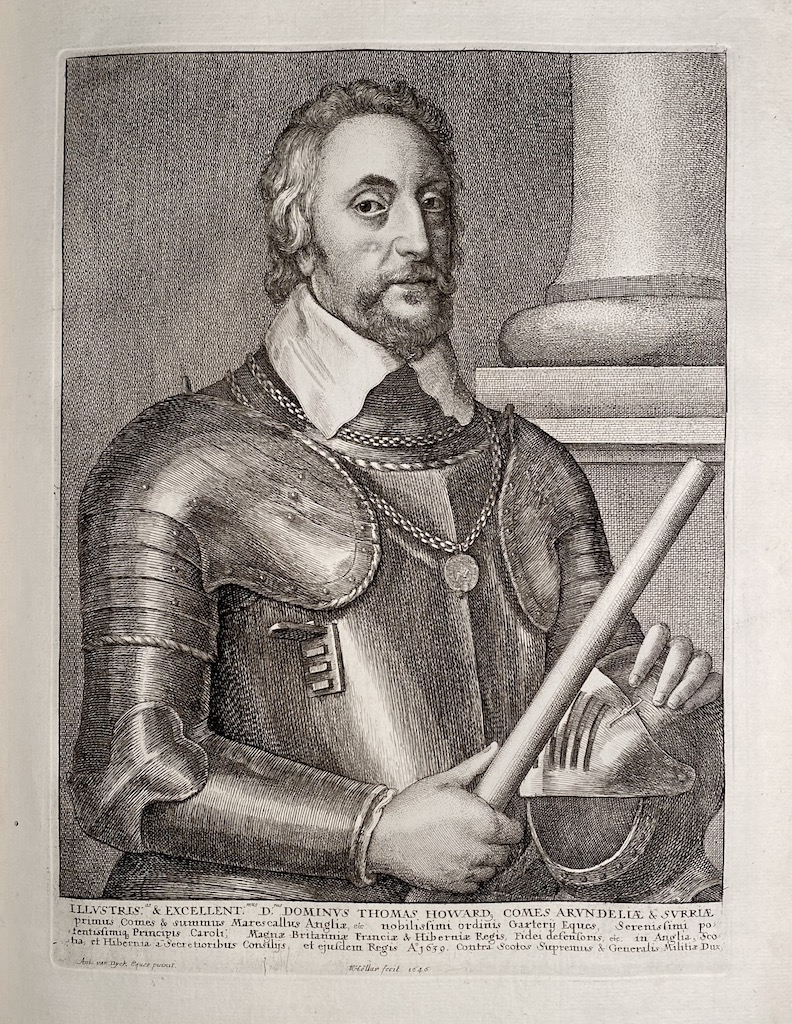
40. Thomas Howard, 14th Earl of Arundel (British, 1585 – 1646); engraved by Wenceslaus Hollar, published by Ioannes Meyssens. Inscription: "ILLVSTRIS:us & EXCELLENT:mus D:nus. DOMINVS THOMAS HOWARD, COMES ARXNDELIÆ & SVRRIÆ | primus Comes & summus Marescallus Angliæ, etc nobilisimi ordiuis Garterÿ Eques, Serenis∫imi po: | tentis∫imq3 Principis Caroli: Magnæ Britanniæ & Hiberniæ Regis, Fidei defen∫oris, etc. in Anglia, Sco | tia et Hibernia a Secretioribus Consilijs, et eju∫dem Regis Ao1639. Contra | Scotos Supremus & Generalis Militiæ Dux,”. In lower margin: “Ant: van Dyck Eques pinxit” <–> “WHollar fecit 1646”. Second state with Ioannes Meyssens’s name completely burnished. 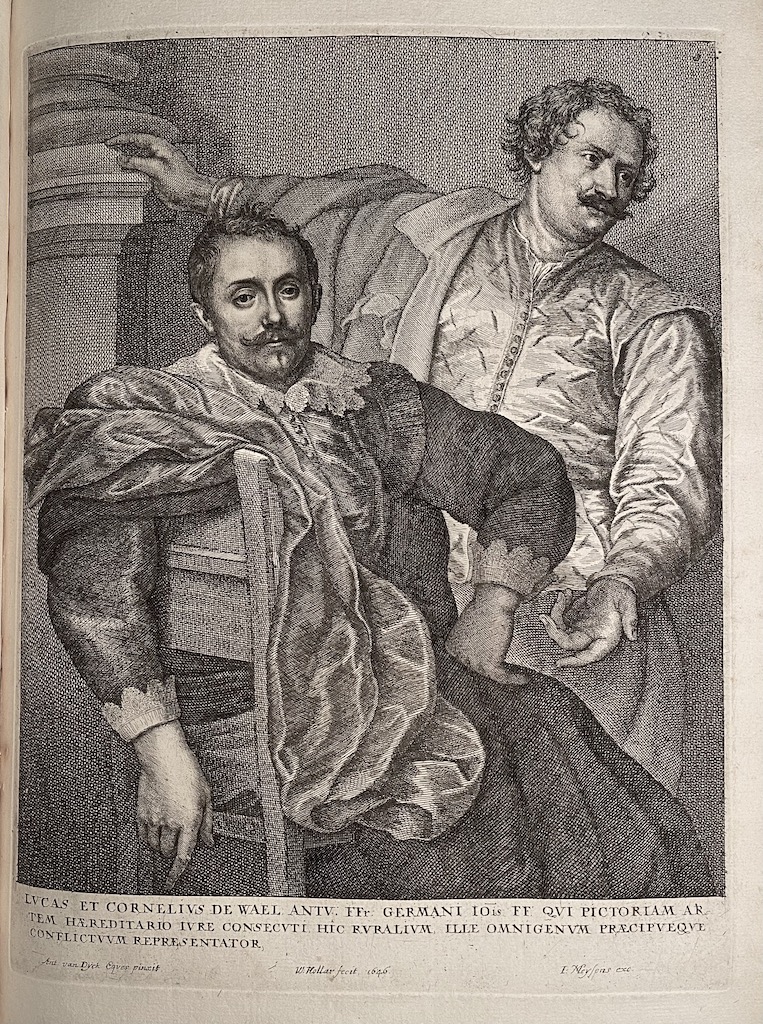
41. Lucas de Wael (Flemish, 1591 – 1661) and Cornelis de Wael (Flemish, 1592 – 1667); engraved by Wenceslaus Hollar, published by Ioannes Meyssens. Inscription: “LVCAS ET CORNELIVS DE WAEL ANTV: FFr. GERMANI IOis QUI PICTORIAM AR | TEM HÆREDITARIO IVRE CONSECVTI HIC RVRALIVM, ILLE OMNIGENVM PRÆCIPVEQVE / CONFLICTVVM REPRÆSENTATOR.”. In lower margin: “Ant. van Dyck Eques pinxit.” <–> “W: Hollar fecit, 1646.” <–> “I: Meysens exc”. First, lettered state with the title and production details. 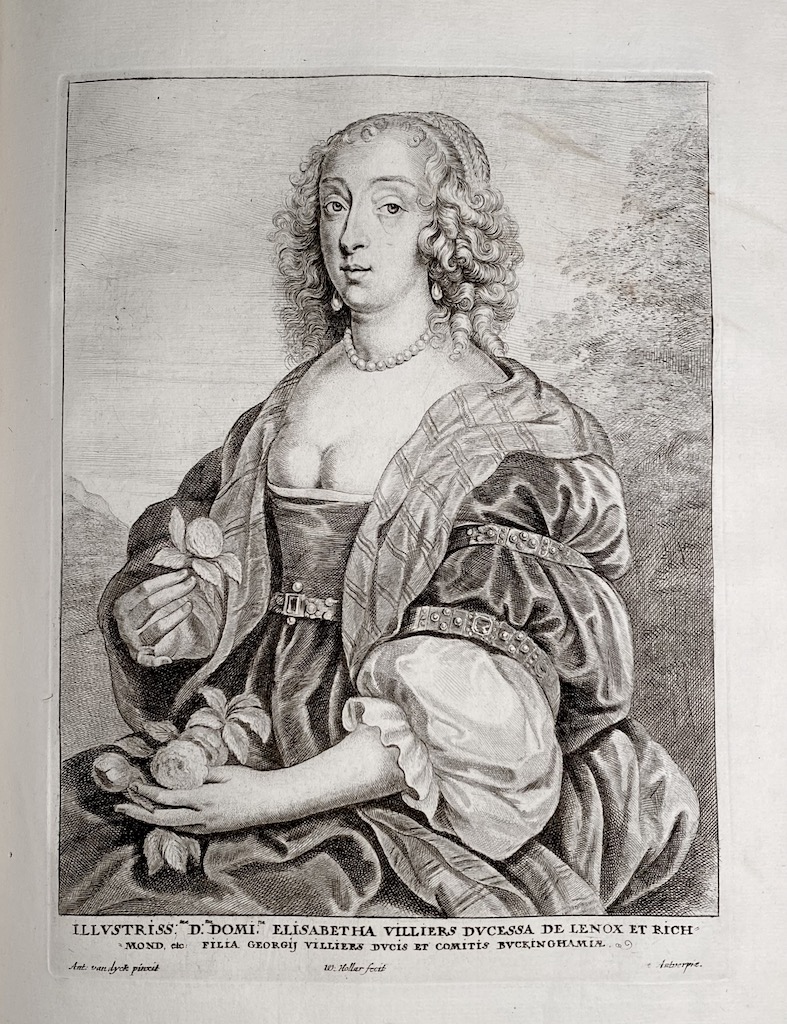
42. Mary (Elisabetha ) Villiers, Duchess of Lennox and Richmond (British, 1622 – 1685); engraved by Wenceslaus Hollar, published by Ioannes Meyssens. Inscription: “ILLUSTRISS: ma D:ma DOMI.na ELISABETHA VILLIERS DVCESSA DE LENOX ET RICH | MOND. etc: FILIA GEORGIJ VILLIERS DVCIS ET COMITIS BVCKINGHAMIÆ.”. In lower margin: “Ant: van dyck pinxit” <–> “W:Hollar fecit” <–> “… Antverpiæ.”. Ioannes Meyssens’ name completely burnished. First state with the title and production details. 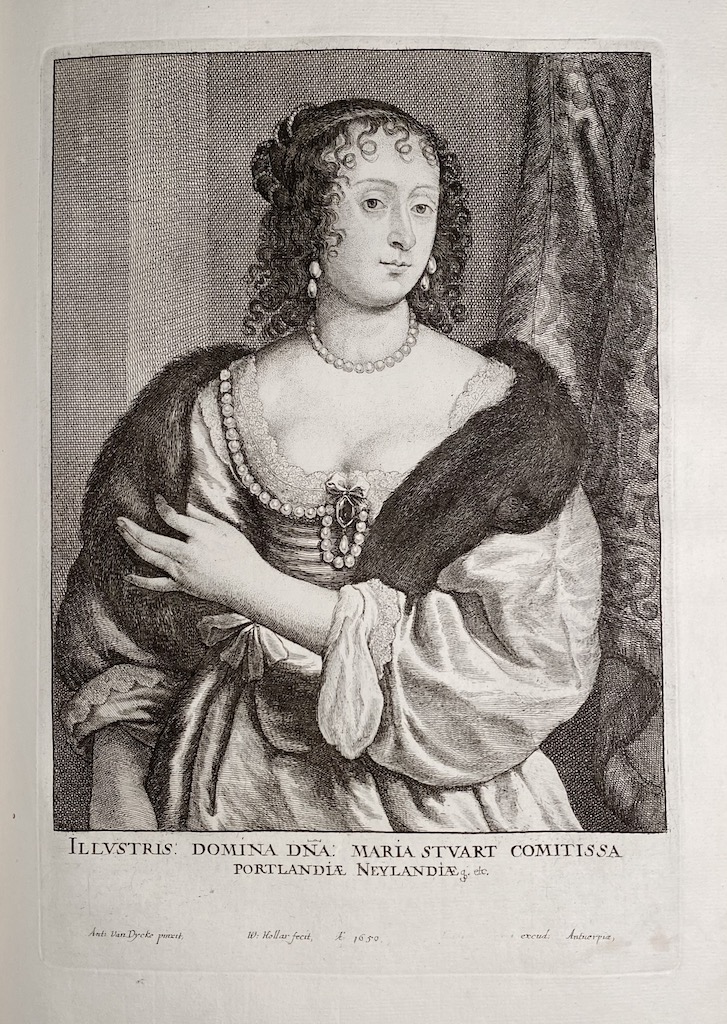
43. Frances (Maria) Stuart, Countess of Portland (British, 1617 – 1694); engraved by Wenceslaus Hollar, published by Ioannes Meyssens. Inscription: “ILLVSTRIS: DOMINA DNA: MARIA STVART COMITISSA | PORTLANDIÆ NEYLANDIÆ, etc.”. Below: “Ant: Van Dycke pinxit,” <–> “W: Hollar fecit, A:o 1650,”, “...excud: Antuerpiæ,”. Second state with Meyssens’ name burnished. British Museum # 1853,0112.1761 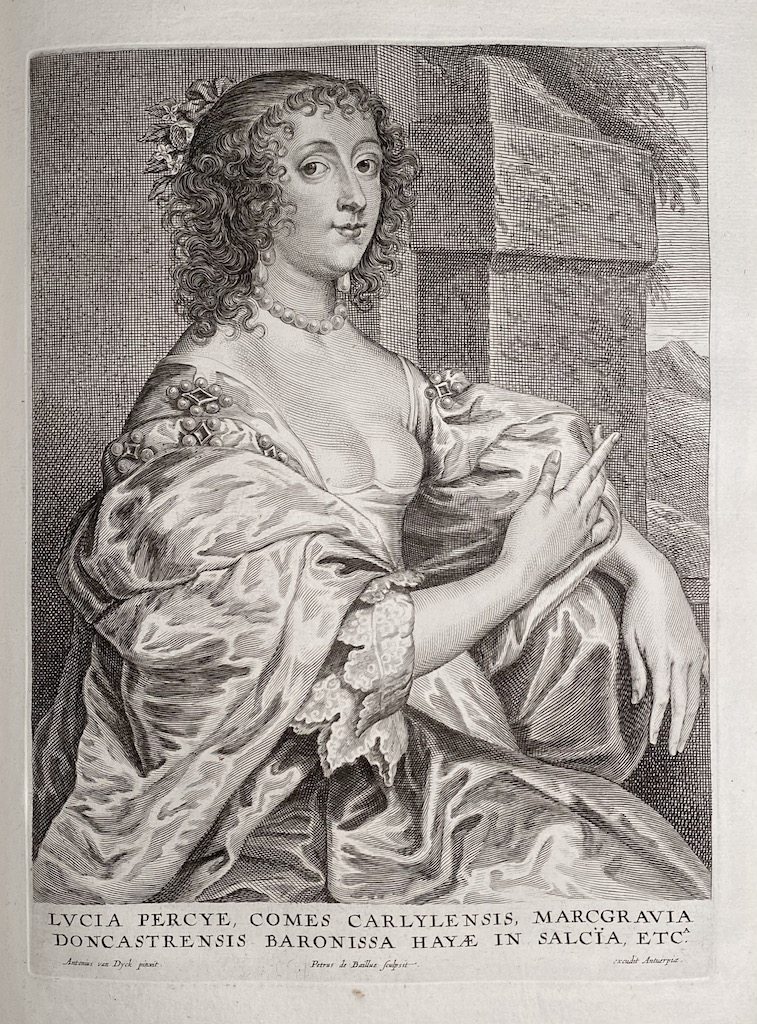
44. Lucy Percy, Countess of Carlisle (British, 1599 – 1660); engraved by Pieter de Bailliu, published by Ioannes Meyssens. Inscription: “LVCIA PERCYE, COMES CARLYLENSIS, MARCGRAVIA | DONCASTRENSIS BARONISSA HAYÆ IN SALCÏA, ETC.A”. In lower margin: “Antonius van Dyck pinxit.” <–> “Petrus de Baillue sculpsit.” <–> “...excudit Antuerpia.”. Third, lettered state with Joannes Meyssens’ name burnished. 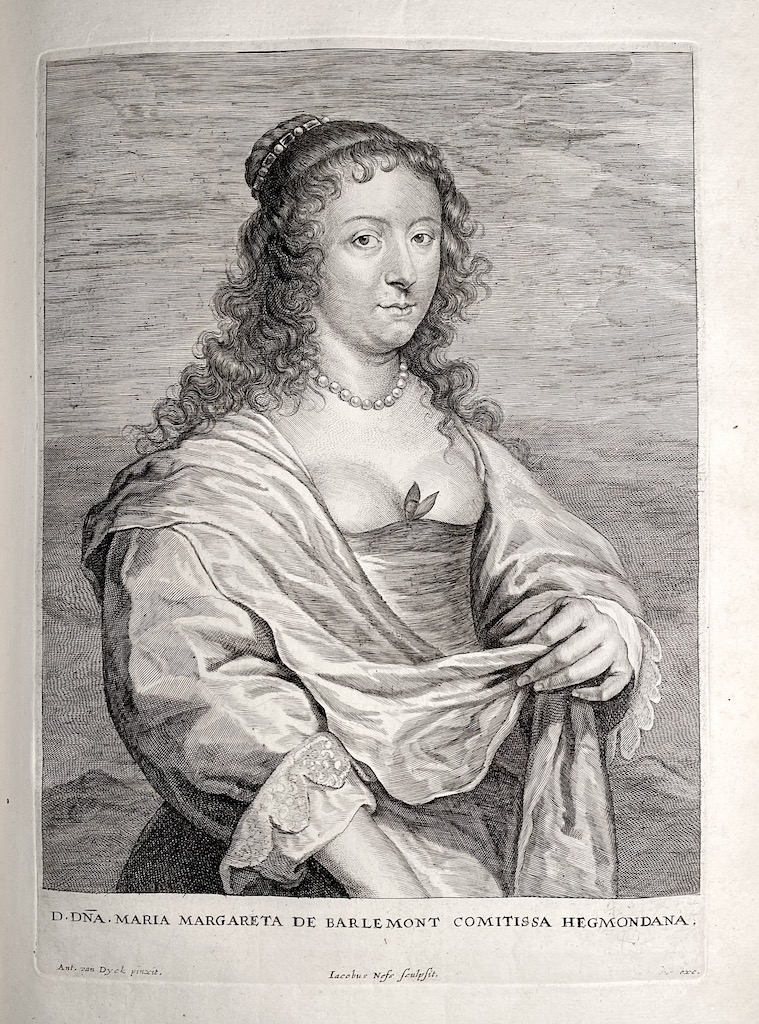
45. Marie-Marguerite de Berlaymont ( ? – 1654); engraved by Jacobus Neeffs, published by Ioannes Meyssens. Inscription: “D.DNA. MARIA MARGARETA DE BARLEMONT COMITISSA HEGMONDANA.” In lower margin: “Ant. van Dyck pinxit.” <–> “Iacobus Nefs sculpsit.”<–> “...exc.”. Fourth state with Ioannes Meyssens’ name erased. British Museum # 1876,1014.206. [Similar to №67, which has Ioannes Meysens name present]. 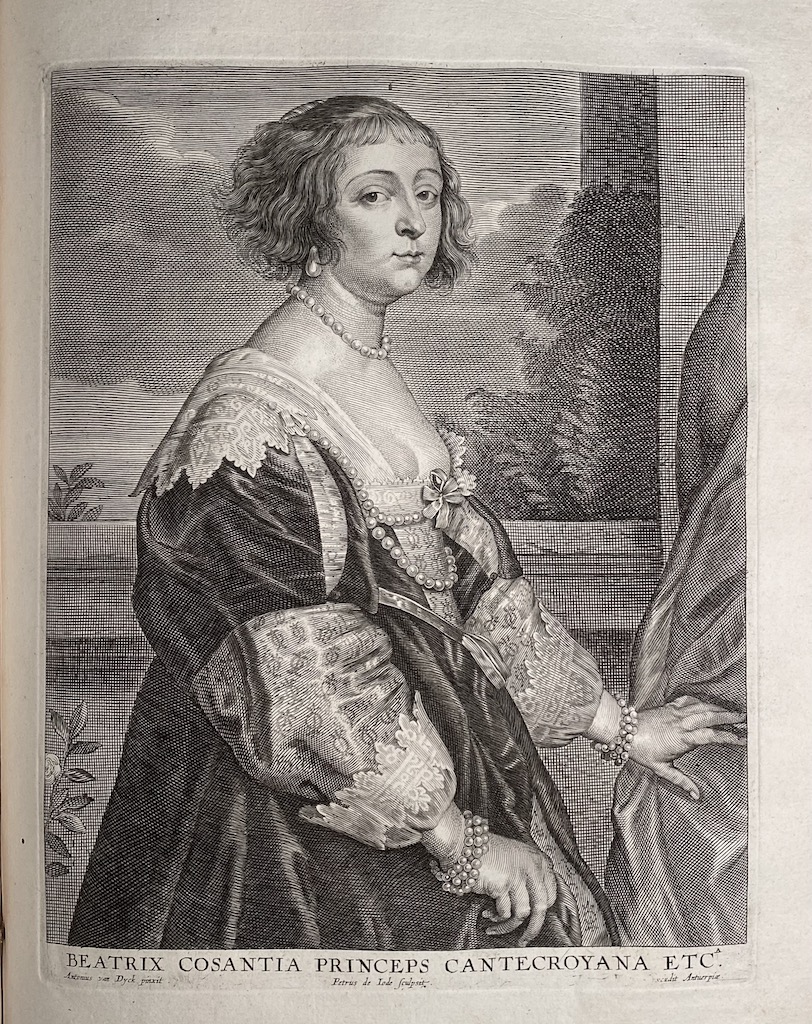
46. Béatrix Constance de Cussance, Princess of Cantecroix (French, 1614 – 1663); engraved by Pieter de Jode II, published by Ioannes Meyssens. Inscription: “BEATRIX COSANTIA PRINCEPS CANTECROYANA ETC.A”. In lower margin: “Antonius van Dyck pinxit” <–>“Petrus de Iode sculpsit.” <–> “… excudit Antuerpiæ.”. Second, lettered state with Meyssens’ name burnished. 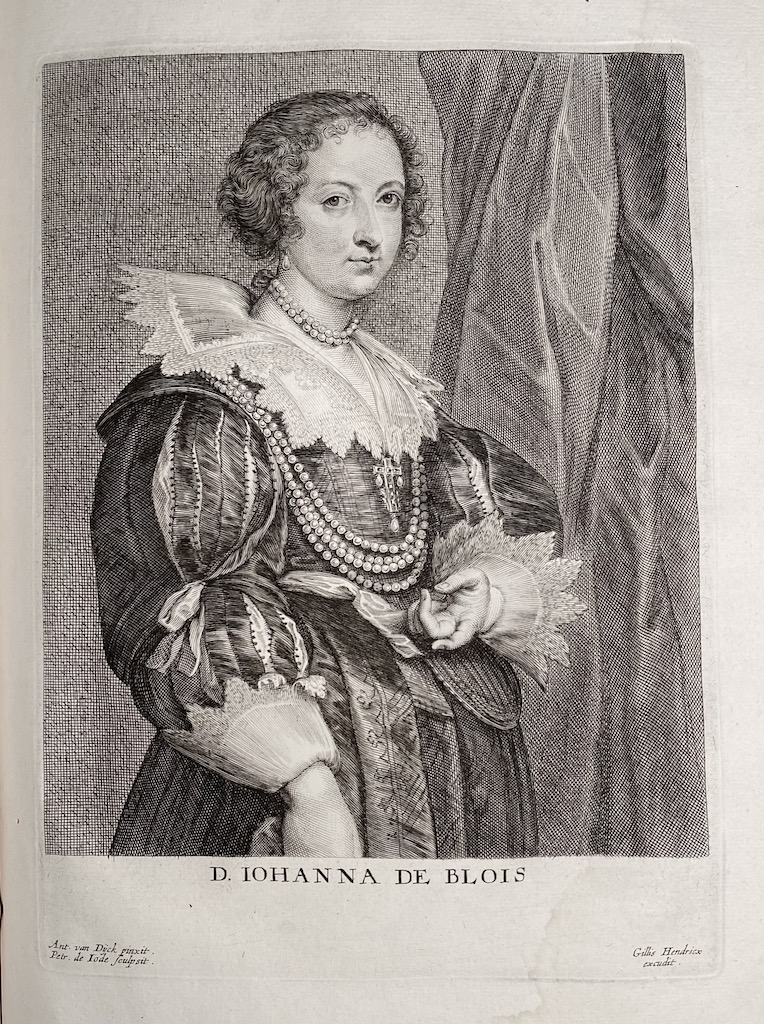
47. Johanna de Blois; engraved by Pieter de Jode II, published by Gillis Hendricx. Inscription: “D. IOHANNA DE BLOIS”. In the lower margin: “Ant. van Dÿck pinxit | Petr. de Iode sculpsit” <–> “Gillis Hendricx | excudit.”. British Museum # 1876,1014.189. 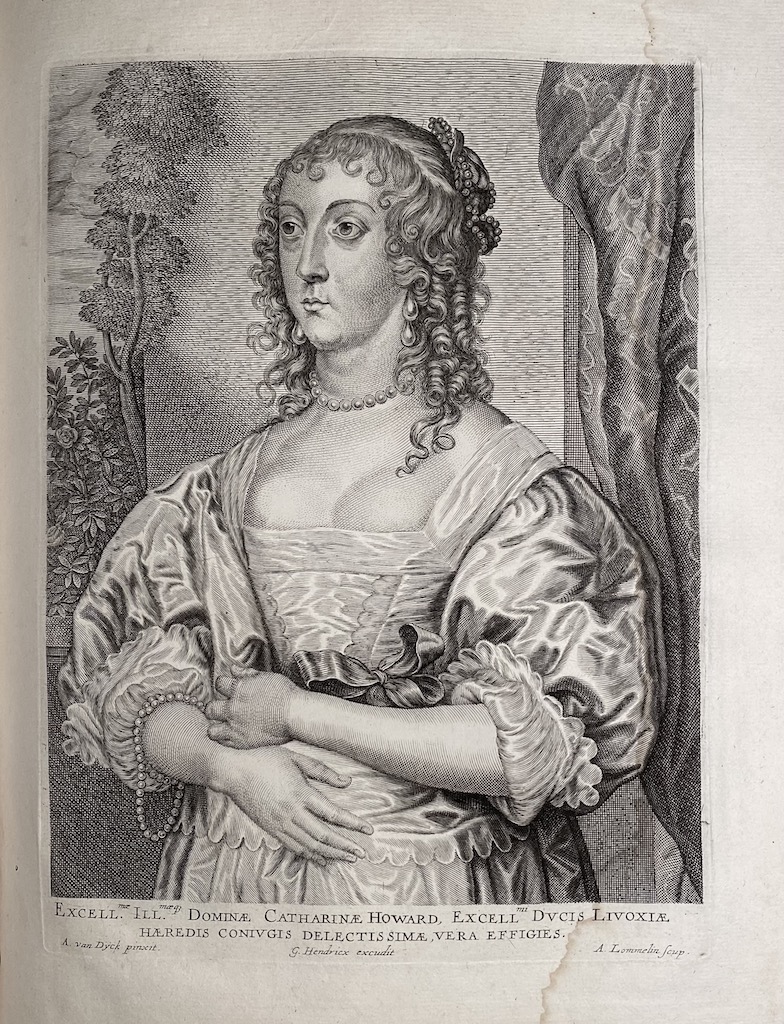
48. Katherine Howard, Countess of Newburgh, Lady d’Aubigny (British, ? – 1650); engraved by Adriaen Lommelin, published by Gillis Hendricx. Inscription: “EXCELLmæ ILL.mæq3 DOMINÆ CATHARINÆ HOWARD, EXCELLmi DUCIS LIVOXIÆ | HÆREDIS CONIUGIS DELECTISSIMÆ, VERA EFFIGIES.” In lower margin: “A. van Dÿck pinxit.” <–> “G. Hendricx excudit” <–> “A. Lommelin scup.”. British Museum # P,3.326 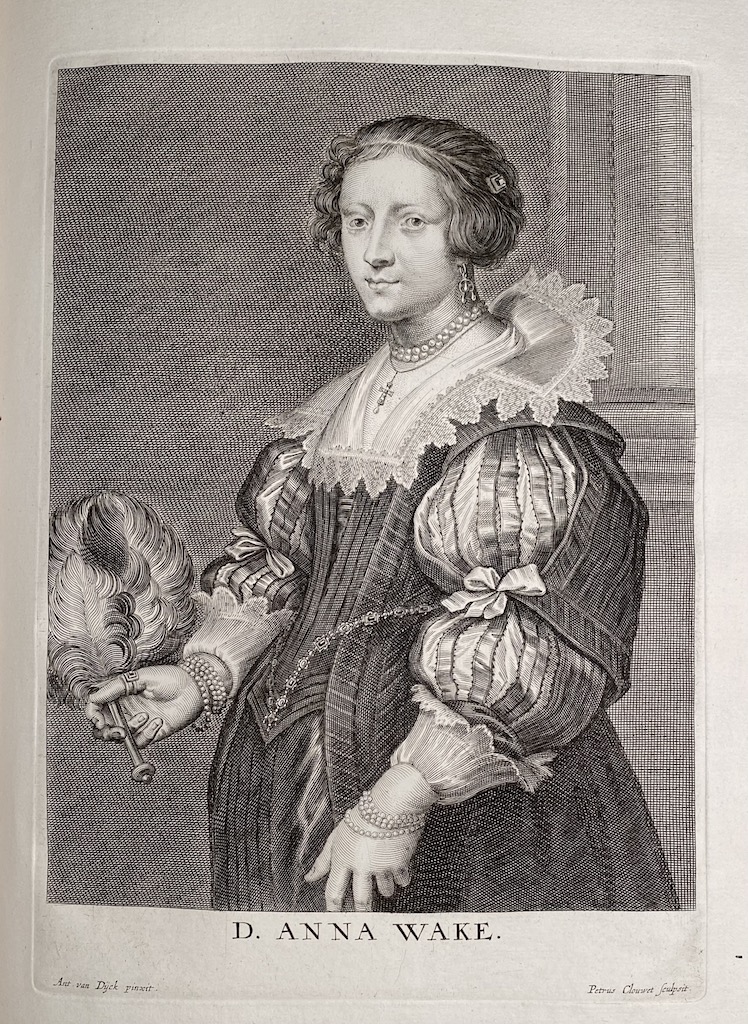
49. Anna Wake (Flemish, 1606 – 1680); engraved by Pieter Clouwet. Inscription: “D. ANNA WAKE.”. In lower margin: “Ant. van Dÿck pinxit.” <–> “Petrus Clouwet sculpsit”. 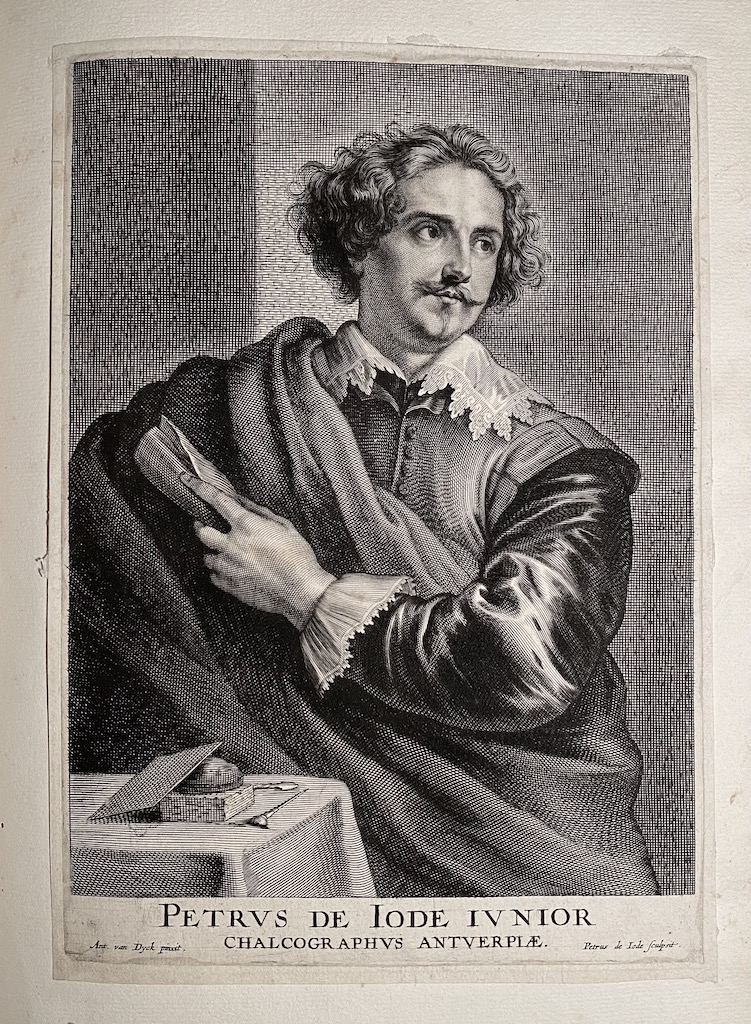
50. Pieter de Jode II (Flemish, 1606-1670/74); engraved by Pieter de Jode II. Inscription: “PETRVS DE IODE IVNIOR / CHALCOGRAPHVS ANTVERPIÆ.”. In lower margin: “Ant. van Dyck pinxit.”<–> “Petrus de Iode sculpsit.”. Third state (before the initials G.H. (of Gillis Hendricx) added. The print with cut off margins pasted to the bound-in leaf. 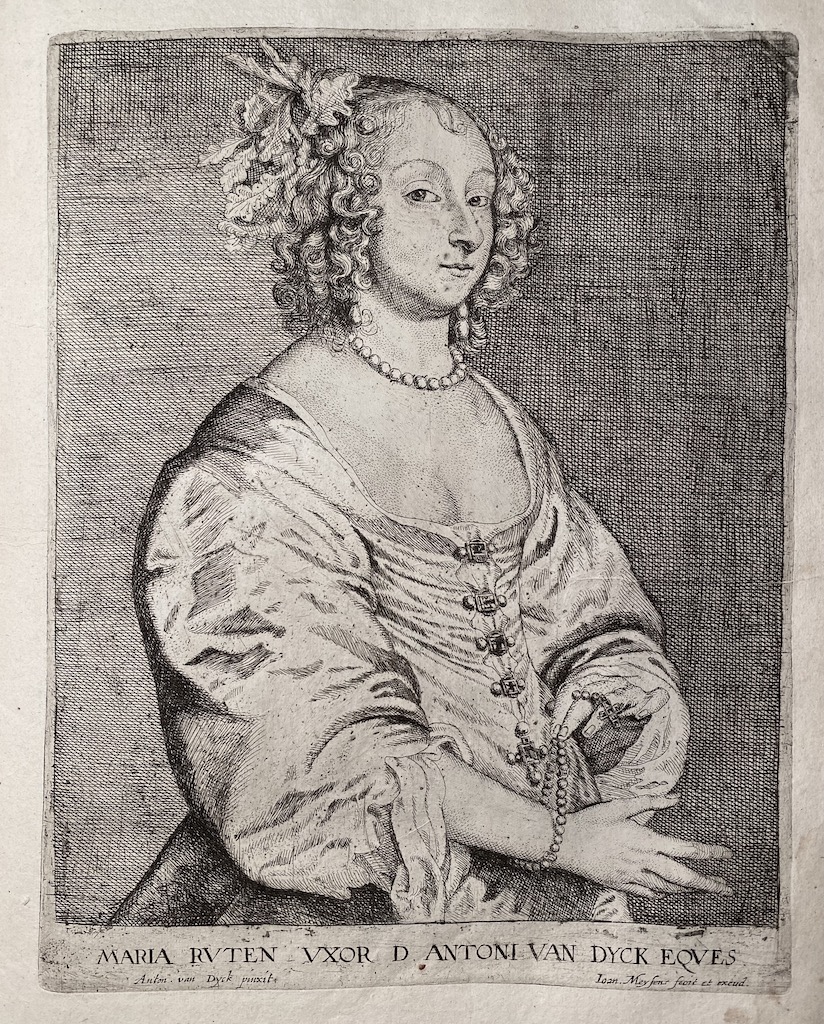
51. Mary Ruthven, Lady van Dyck (Scottish, c. 1622 – 1645); engraved and published by Ioannes Meyssens. Inscription: “MARIA RVTEN VXOR D. ANTONI VAN DYCK EQVES”. In lower margin: “Anton.van Dyck pinxit” <–> “Ioan. Meysens fecit et excud.”. First, lettered state with the title and production details. Tired plate. British Museum # 1863,0725.747. Van Dyck's wife. 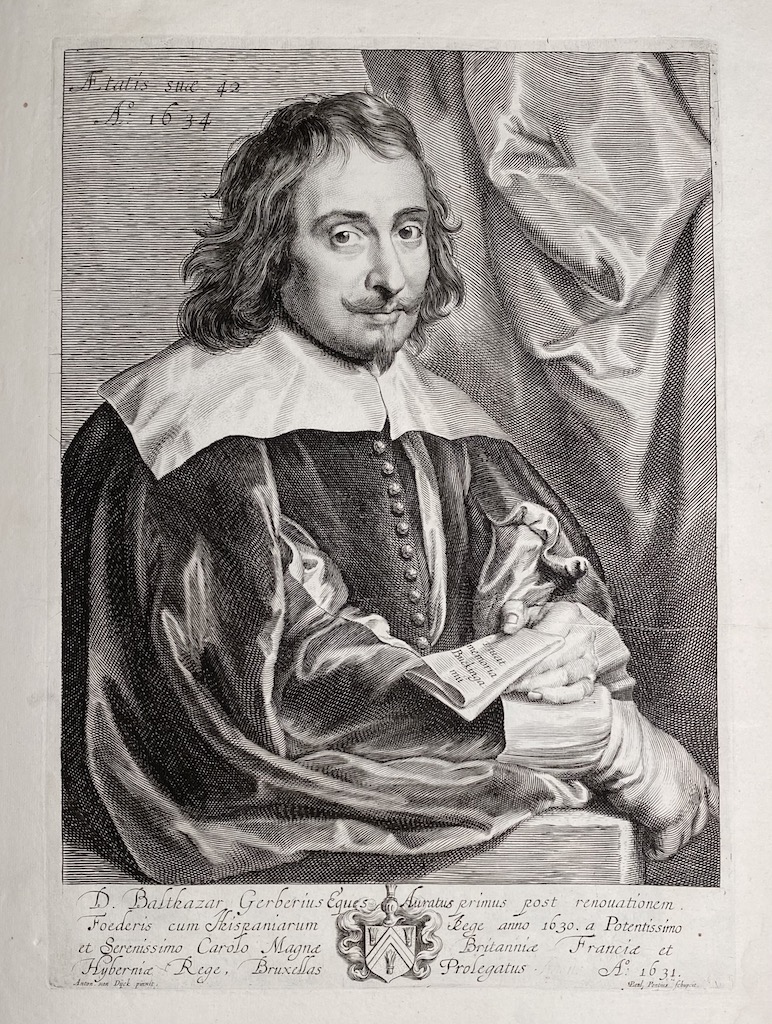
52. Sir Balthazar Gerbier (British, Flemish, 1592 – 1663); engraved by Paulus Pontius. Inscription: “D. Balthazar Gerberius Eques Auratus primus post renouationem. | Foederis cum Hispaniarum Rege anno 1630. A Potentissimo | et Serenissimo Carolo Magnæ Britanniæ Franciæ et Hiberniæ. Rege, Bruxellas Prolegatus. A:o 1631”. Below “Anton van Dyck pinxit”<–> “Paul Pontius schupcit.”. Top left corner: “Ætatis suæ 42 | A.o 1634”. The paper in Gerbier’s hand is lettered “viuat | memoria | Buckinga: | mii”. 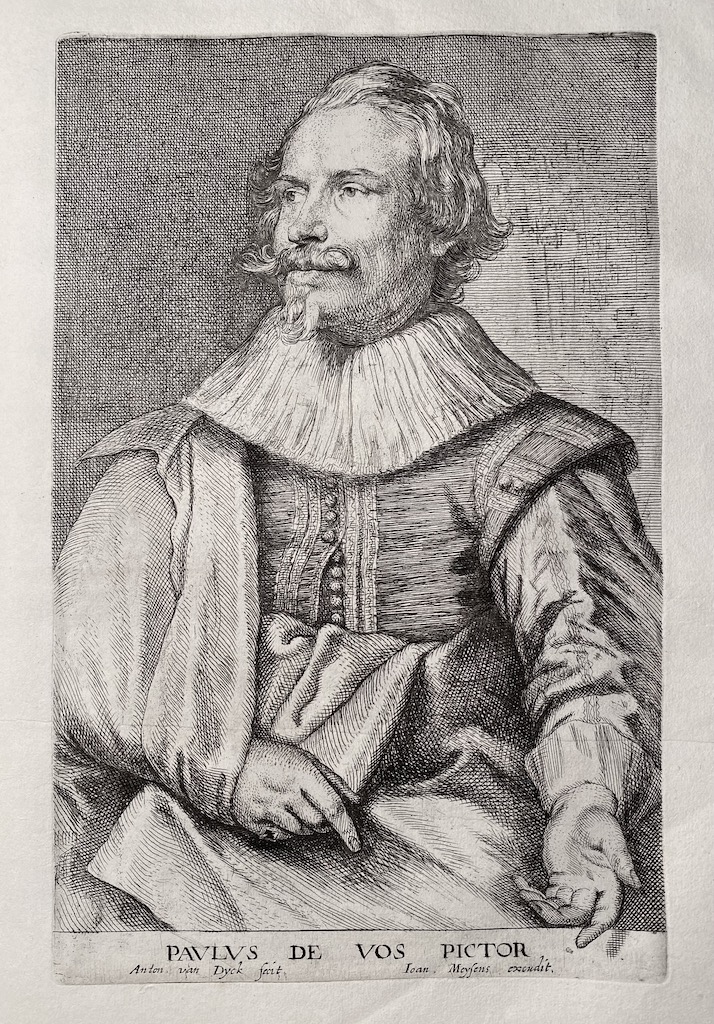
53. Paul de Vos (Flemish, 1596 – 1678); printed by Ioannes Meyssens, face and collar engraved by Anthony van Dyck, the body engraved by Ioannes Meyssens. Second, lettered state. Inscription: PAVLVS DE VOS PICTOR”. In lower margin: “Anton. van Dyck pinxit fecit.”, and “Ioan. Meysens excudit.”. British Museum # R,1b.95. [Look s very much alike №68, but with a one-line inscription and engraved by Meyssens instead of Bolswert]. 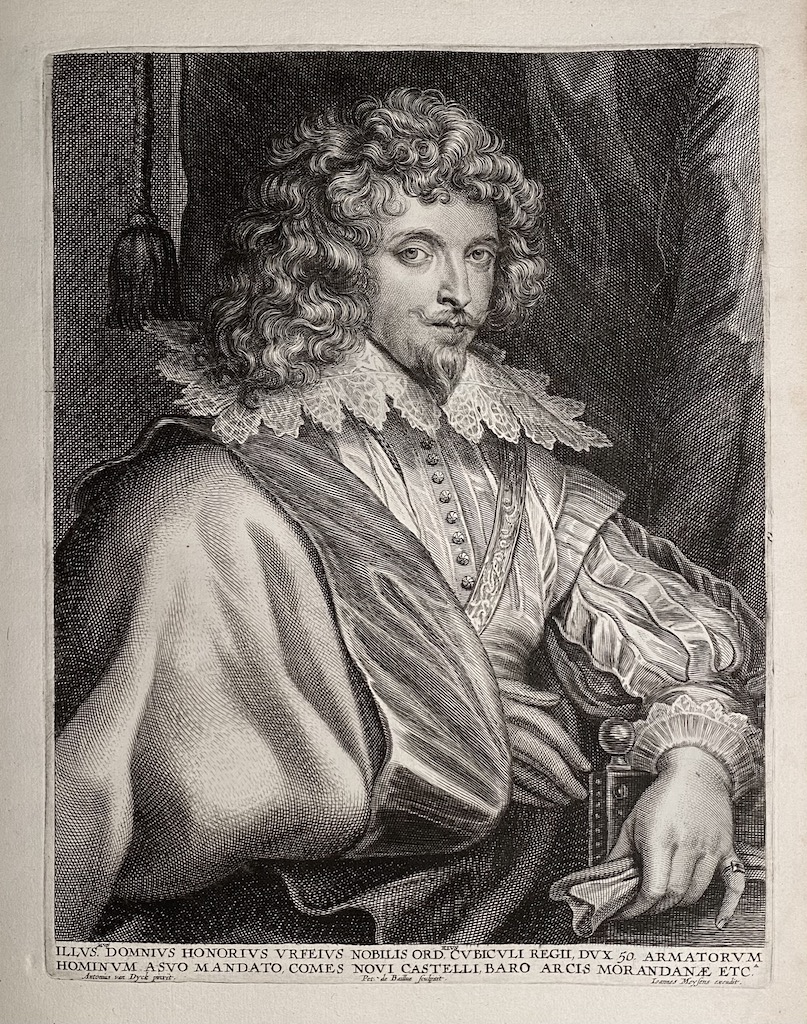
54. Honoré d’Urfé, marquis de Valromey, comte de Châteauneuf (French, 1568 – 1625); engraved by Pieter de Bailliu (Flemish, 1613 – 1660). Inscription: “ILLVS.MVS DOMNIVS HONORIVS VRFEIVS NOBILIS ORD.RIVS CVBICVLI REGII, DVX 50. ARMATORVM | HOMINVM A SVO MANDATO, COMES NOVI CASTELLI, BARO ARCIS MORANDANÆ ETC.A”. Below: “Antonius van Dyck pinxit” <–> “Pet. de Bailliue sculpsit.” <–> “Ioanes Meysens excudit.”. Second lettered state with title and production details. [Similar to №14, but with Ioanes Meysens name in place]. 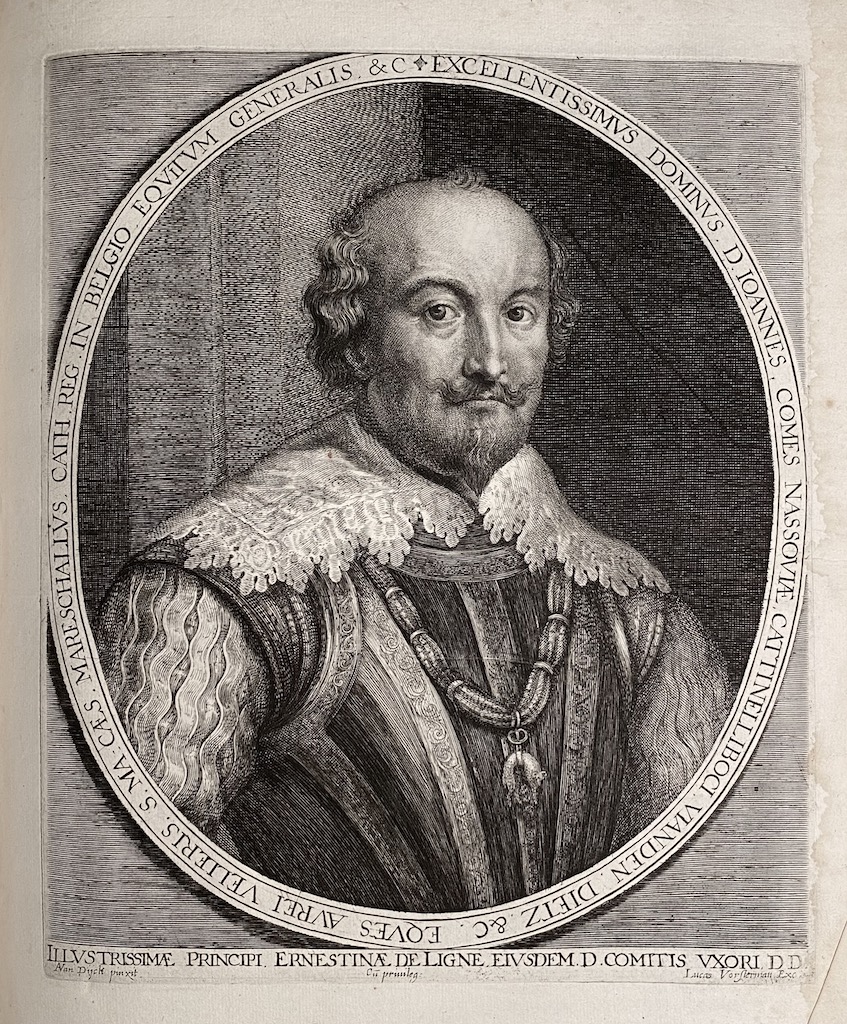
55. Johannes [John VIII], Count of Nassau-Siegen (German, 1583 – 1638); engraved by Lucas Vorsterman I (Flemish, 1595 – 1675). Inscription: in the oval around the portrait “EXCELLENTISSIMVS DOMINVS: D. IOANNES, COMES NASSAOVIÆ, CATTNELLIBOCI: VIANDEN, DIETZ, &C. EQVES AVREI VELLERIS. S. MA: CÆS, MARESCHALIVS, CATH. REG. IN BELGIO. EQVITVM GENERALIS. &C”, in lower margin: “ILLVSTRISSIMÆ PRINCIPI ERNESTINÆ DE LIGNE EIVSDEM D. COMITIS VXORI DD.”. Below: “AVan Dÿck pinxit.” <–> “Cū Priuleg” <–> “Lucas Vorsterman exc”. Third state. [For the fourth state with Lucas “Vorsterman exc” burnished see № 15]. 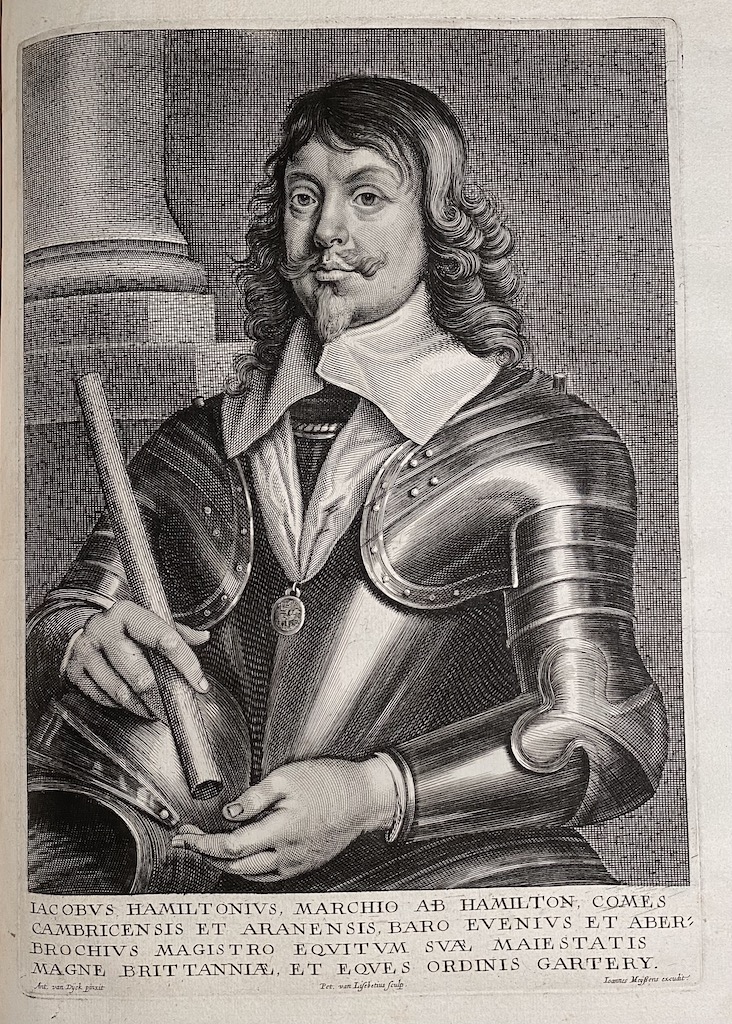
56. James Hamilton, 1st Duke of Hamilton (British, 1606 – 1649); engraved by Peeter van Lisebetten (Flemish,(1630 – 1678), published by Ioannes Meysens. Inscription: “IACOBVS HAMILTONIVS, MARCHIO AB HAMILTON, COMES | CAMBRICENSIS ET ARANENSIS, BARO EVENIVS ET ABER: | BROCHIVS MAGISTRO EQVITVM SVÆ MAIESTATIS | MAGNE BRITTANIÆ, ET EQUES ORDINIS GARTERY.”.In lower margin: “Ant. van Dÿck pinxit” <–> “Pet. van Lisebetius sculp.”<–> “Ioannes Meÿssens excudit.”. Second state with title and signatures. British Museum # P,2.208. 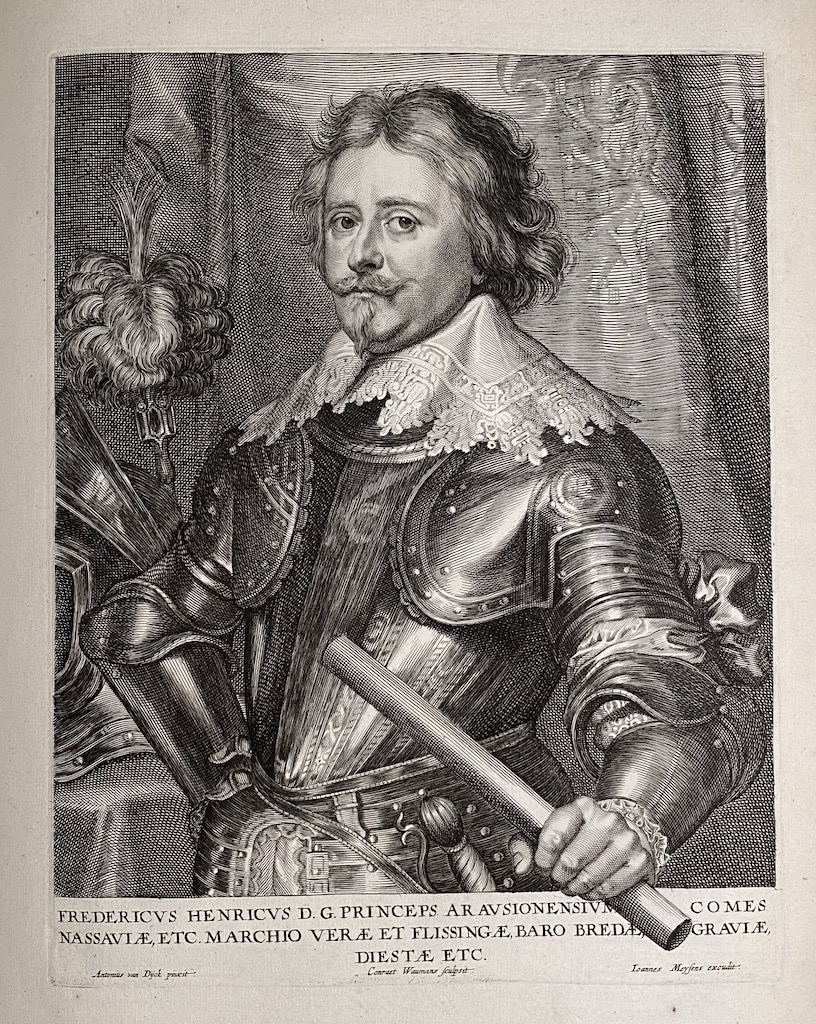
57. Frederick Henry, Prince of Orange, Count of Nassau (Dutch, 1584 – 1647); engraved by Conrad Waumans [Woumans] (Flemish, 1619 – after 1675). Inscription: “FREDERICVS HENRICVS, D.G. PRINCEPS ARAVSIONENSIVM, COMES | NASSAVIÆ, ETC. | MARCHIO VERÆ ET FLISSINGÆ, BARO BREDÆ GRAVÆ, | DIESTÆ ETC.”. Below: “Antonius van Dÿck pinxit” <–> “Conraet Waumans sculpsit” <–> “Ioannes Meyssens excudit.” First, lettered state with title and production details. [Similar to №5, but this one with Ioannes Meyssens name present]. 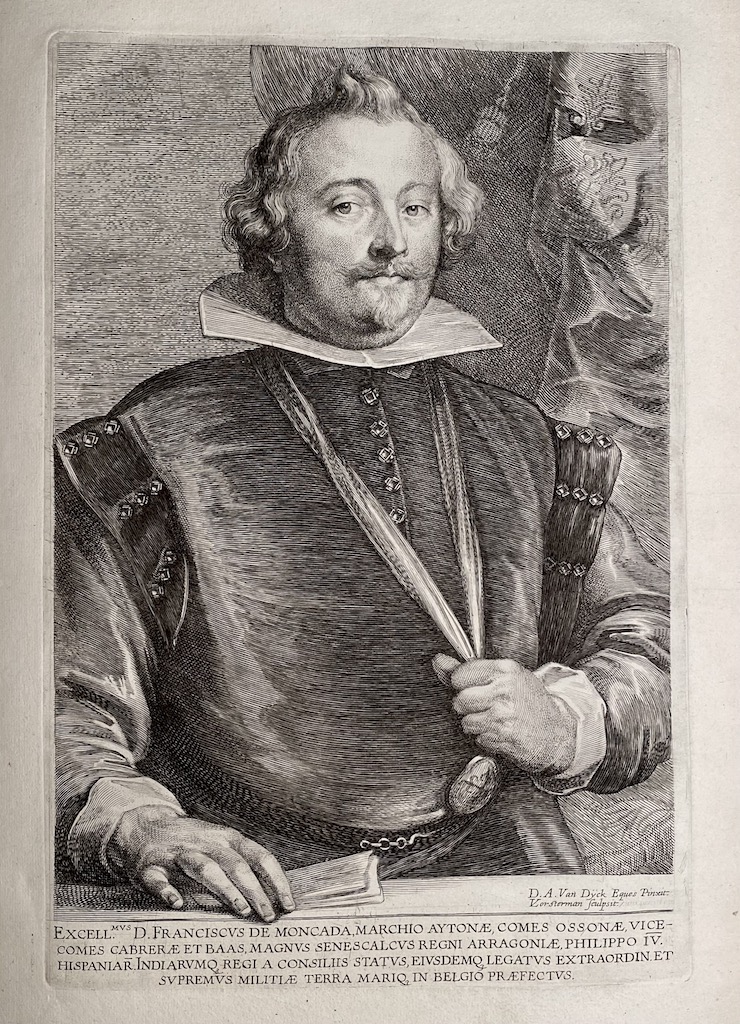
58. Francisco de Moncada, Count d’Osuna (Spanish, 1568 – 1635); engraved by Lucas Vorsterman I. Inscription: “EXCELL.MVS D. FRANCISCVS DE MONCADA MARCHIO AYTONÆ, COMES OSSONÆ VICE– | COMES CABRERÆ ET BAAS, MAGNVS SENESCALCVS REGNI ARRAGONIÆ, PHILIPPO IV. | HISPANIAR.INDIARVMQ3 REGI A CONSILIIS STATVS, EIVSDEMQ3 LEGATVS EXTRAORDIN,ET | SVPREMVS MILITIÆ TERRA MARIQ3 IN BELGIO PRÆFECTVS". Above within portrait frame, to the right: “D.A.van Dÿck pinxit. | LVorsterman sculpsit.”. 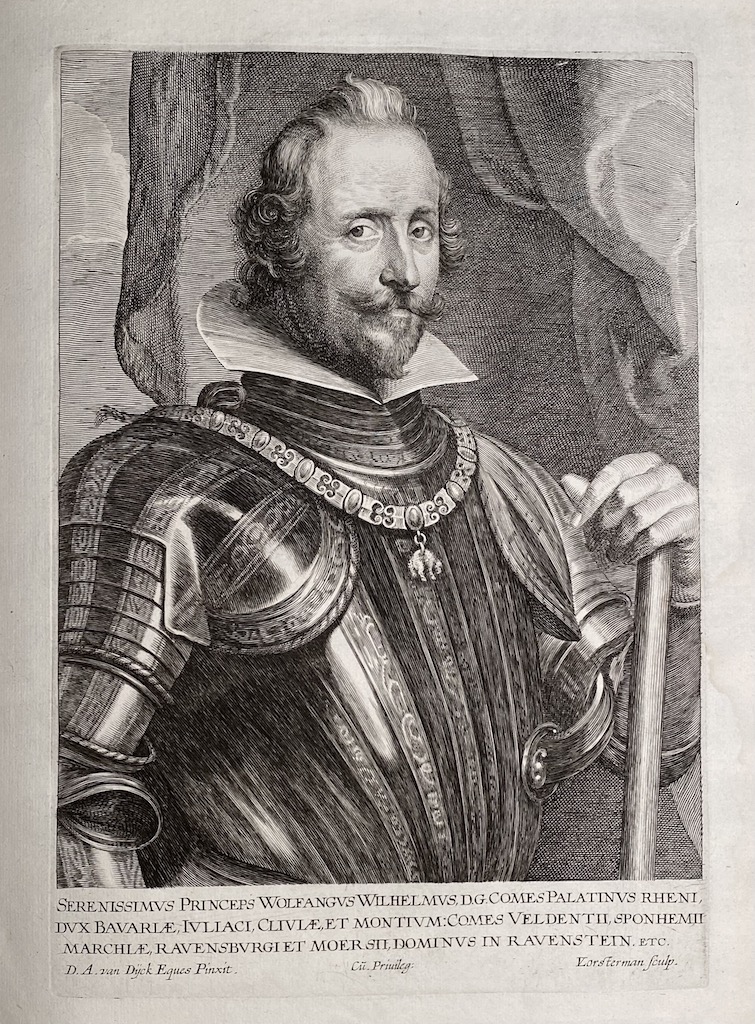
59. Wolfgang Wilhelm, Count of Pfalz-Neuburg and Duke of Jülich (German, 1578 – 1653); engraved by Lucas Vorsterman I. Inscription: "SERENISSIMVS PRINCEPS WOLFGANGVS WILHELMVS, D.G. COMES PALATINVS RHENI, | DVX BAVARIÆ, IVLIACÆ, ET MONTIVM :COMES VELDENTII, SPONHEMII | MARCHIÆ, RAVENSBVRGI ET MOERSII, DOMINVS IN RAVENSTEIN. ETC." In lower margin: "D. A. van Dÿck Eques Pinxit." <–> "Cū. Priuileg:" <–> "LVorsterman sculp.". Fifth state with initials of Gillis Hendricx burnished. British Museum # 1863,0509.825. 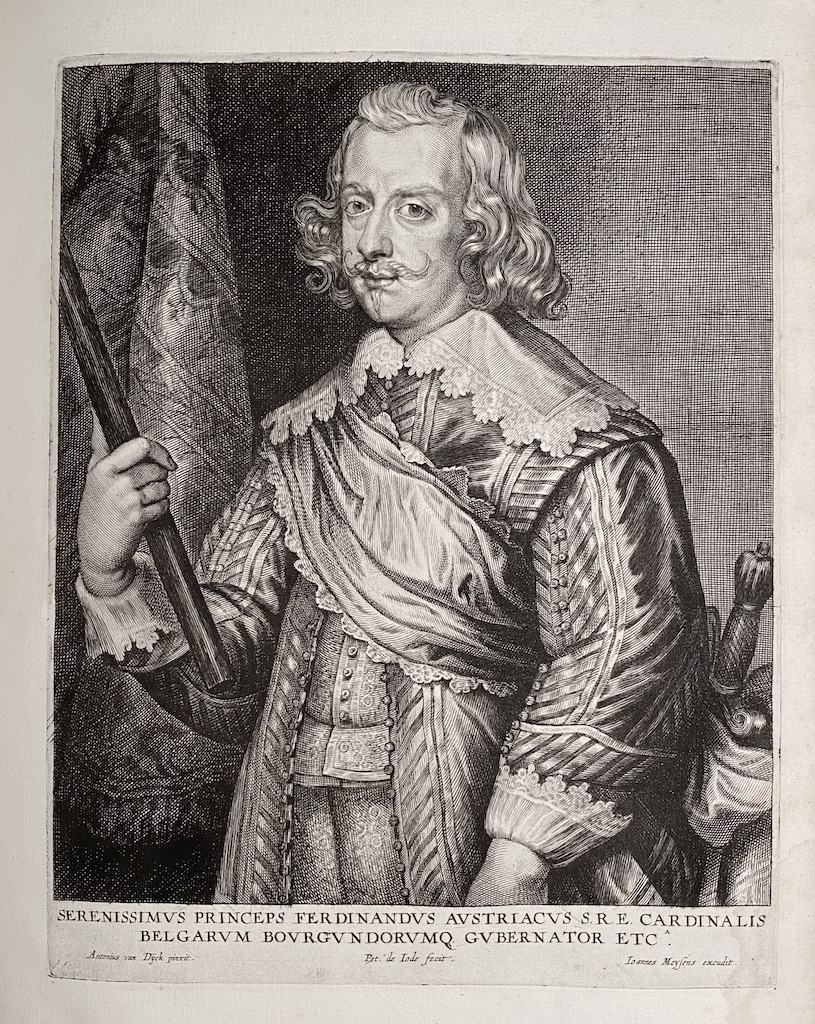
60. Ferdinand, Cardinal Infante of Spain and Archduke of Austria (Spanish, 1609 – 1641); engraved by Pieter de Jode II, published by Ioannes Meyssens. Inscription: “SERENISSIMVS PRINCEPS FERDINANDVS AVSTRIACVS S.R.E CARDINALIS | BELGARVM BORGVNDIORVMQ3 GVBERNATOR ETC.A”. In lower margin: “Antonius van Dÿck pinxit” <–> “Pet. de Iode fecit” <–> “Ioannes Meysens excudit”. Third, lettered state with title and production details. British Museum # R,1a.28. 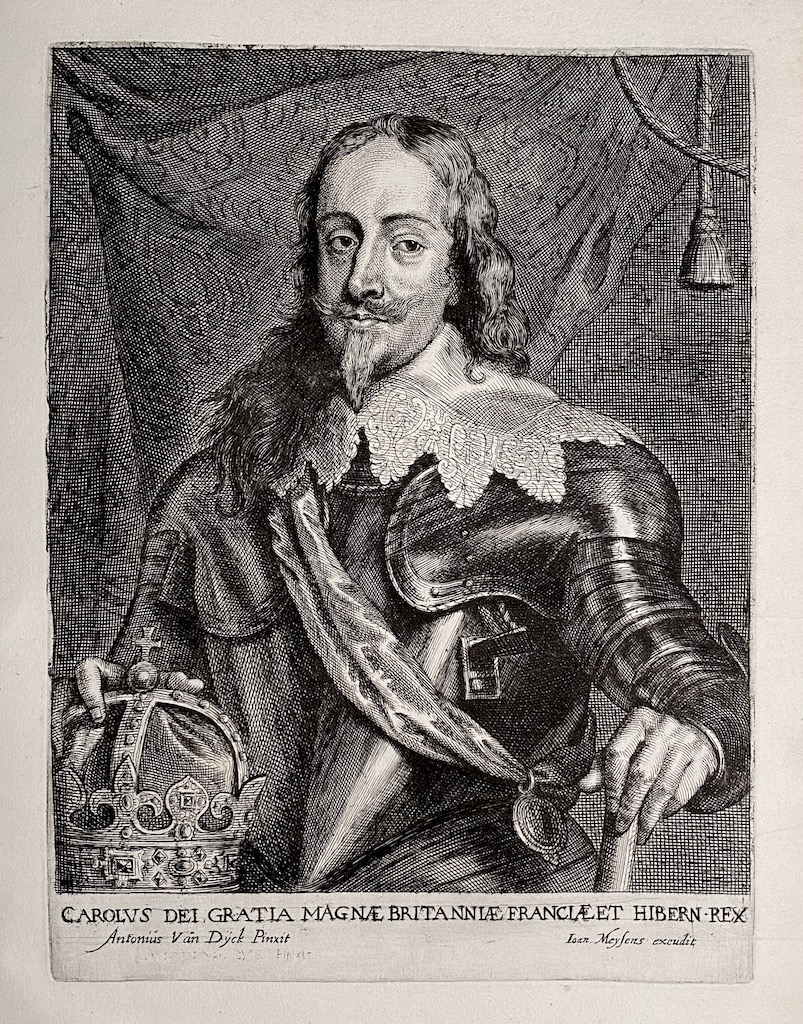
61. Charles I, King of England, Scotland, and Ireland (British, 1600 – 1649); engraved by Johannes [Jan] Meyssens (Flemish, 1612 – 1670). Inscription: “CAROLVS DEI GRATIA MAGNÆ BRITANNIÆ, FRANCIÆ ET HIBERNIÆ REX”. Below: “Antonius Van Dÿck eques pinxit” <–> “Ioan. Meysens excudit”. [Similar to №4, but with Ioannes Meysens name present]. 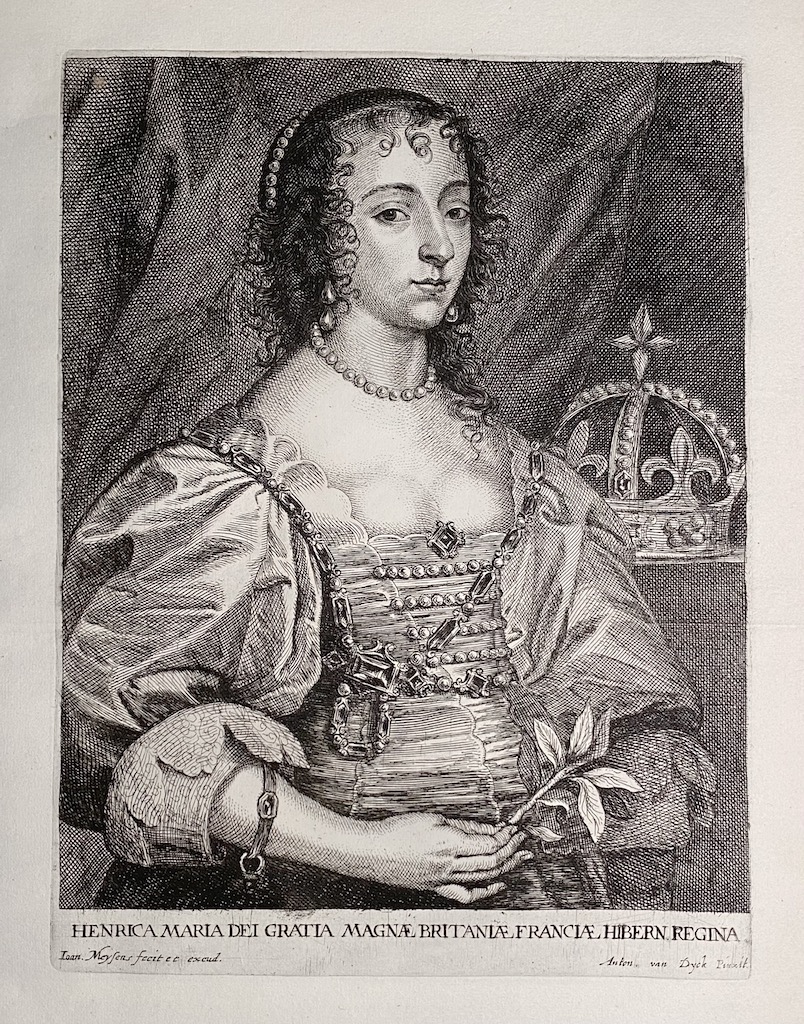
62. Henriette Marie de Bourbon, engraved and published by Ioannes Meyssens. Inscription: “HENRICA MARIA DEI GRATIA MAGNÆ BRITANIÆ FRANCIAÆ HIBERN. REGINA.” Lettered with production details in lower margin: “Ioan. Meysens fecit et excud.” <–> “Anton van Dyck Pinxit”. Third state, finished with a burin. [Similar to print №31, but this one with Ioan. Mey∫ens signature present]. 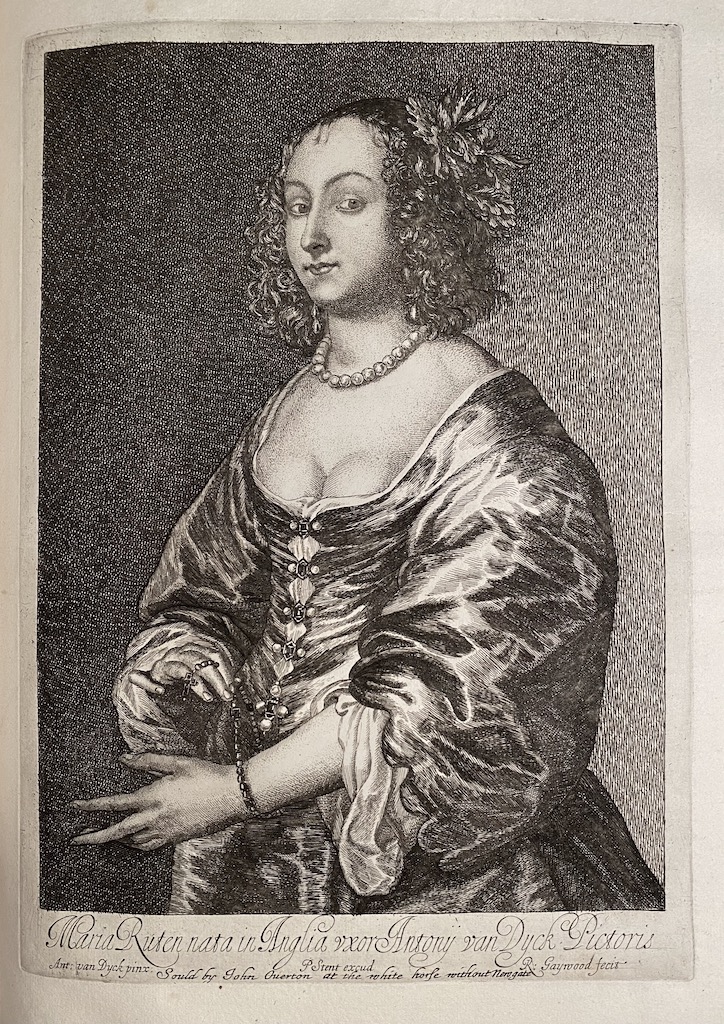
63. Mary Ruthven, Lady van Dyck (Scottish, c. 1622 – 1645); copy in reverse by Richard Gaywood after Bolswert (see also №51 by Meyssens) published by Peter Stent. Inscription: “Maria Ruten nata in Anglia vxor Antonÿ van Dyck Pictoris”. Below: “Ant: van Dyck pinx:”, “P Stent excud”, “R: Gaywood fecit”. Below centre: “Sould by John Ouerton at the white horse without New gate”. John Overton, publisher (British, 1639/40 – 1713); Richard Gaywood (British, fl. c. 1644 – 1677). Peter Stent (British, fl. c. 1637 – 1665). See BM # P,3.351. 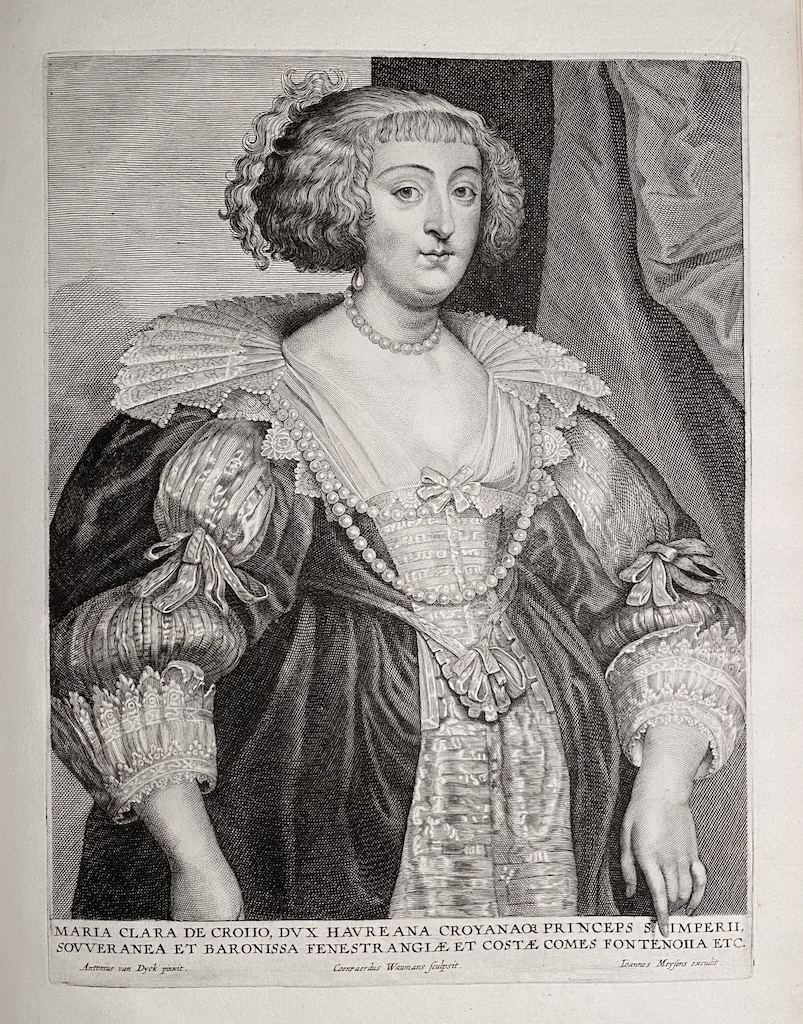
64. Marie-Claire de Croy, Duchess of Havré (Flemish, 1605 – 1664); engraved by Conraad Waumans, published by Ioannes Meyssens. Inscription: “MARIA CLARA DE CROIIO, DVX HAVREANA CROYANAQ3 PRINCEPS STE. IMPERII, | SOVVERANEA ET BARONISSA FENESTRANGIÆ ET COSTÆ COMES FONTENOIIA ETC”. In lower margin: “Antonius van Dyck pinxit.” <–> “Coenraerdus Waumans sculpsit.” <–> “Ioannes Meysens excudit.”. Second state. British Museum # R,1a.188. [Similar to №36, but this one with Ioannes Meysens name present]. 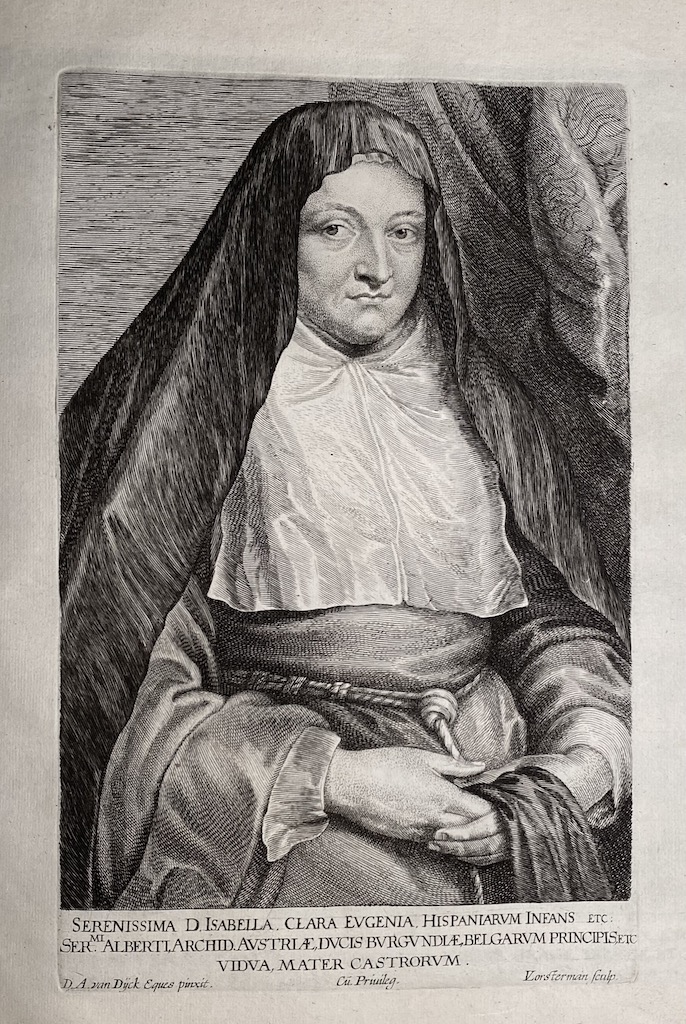
65. Isabel Clara Eugenia, ruler of the Spanish Netherlands (Spanish, 1566 – 1633); engraved by Lucas Vorsterman I. “SERENISSIMA D. ISABELLA. CLARA. EVGENIA. HISPANIARVM INFANS ETC. | SER.MI ALBERTI. ARCHID. AVSTRIÆ, DVCIS BVRGVNDIÆ, BELGARVM PRINCIPIS, ETC. | VIDVA, MATER CASTRORVM.” In lower margin: “D. A.van Dÿck Eques pinxit.” <–> “Cū Priuileg.” <–> “LVorsterman sculp.”. Fourth state with initials of Gillis Hendricx burnished. British Museum # 1863,0509.820. 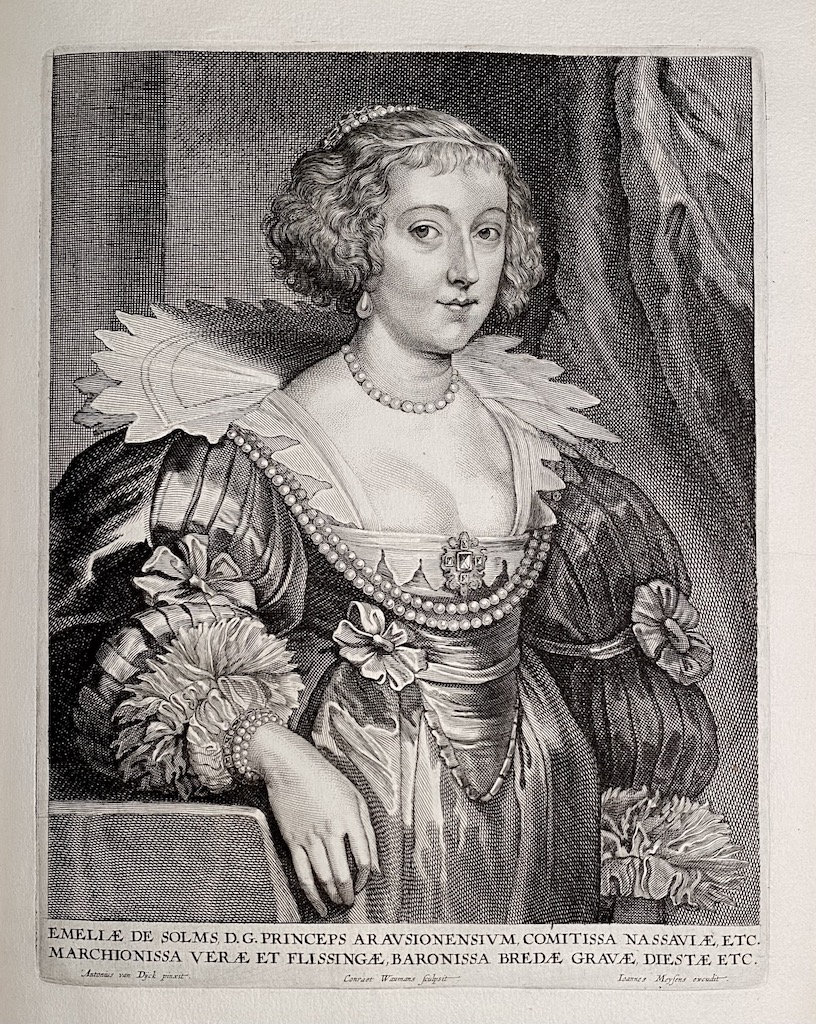
66. Amalia van Solms, Princess of Orange (German, 1602 – 1675), engraved by Conraad Waumans and published by Johannes Meyssens. Inscription: “EMELIÆ DE SOLMS, D. G. PRINCPES ARAVSIONENSIVM, COMITISSA NASSAUVIÆ, ETC. | MARCHIONISSA VERÆ ET FLISSINGÆ, BARONISSA BREDÆ, GRAVÆ, DIESTÆ ETC.” In lower margin: “Antonius van Dijck pinxit.”, “Conraet Waumans sculpsit.” and “Ioannes Meysens excudit.”. First, lettered state with the title and production details lettered. [Similar to №32, but this one with Ioannes Meysens name present]. 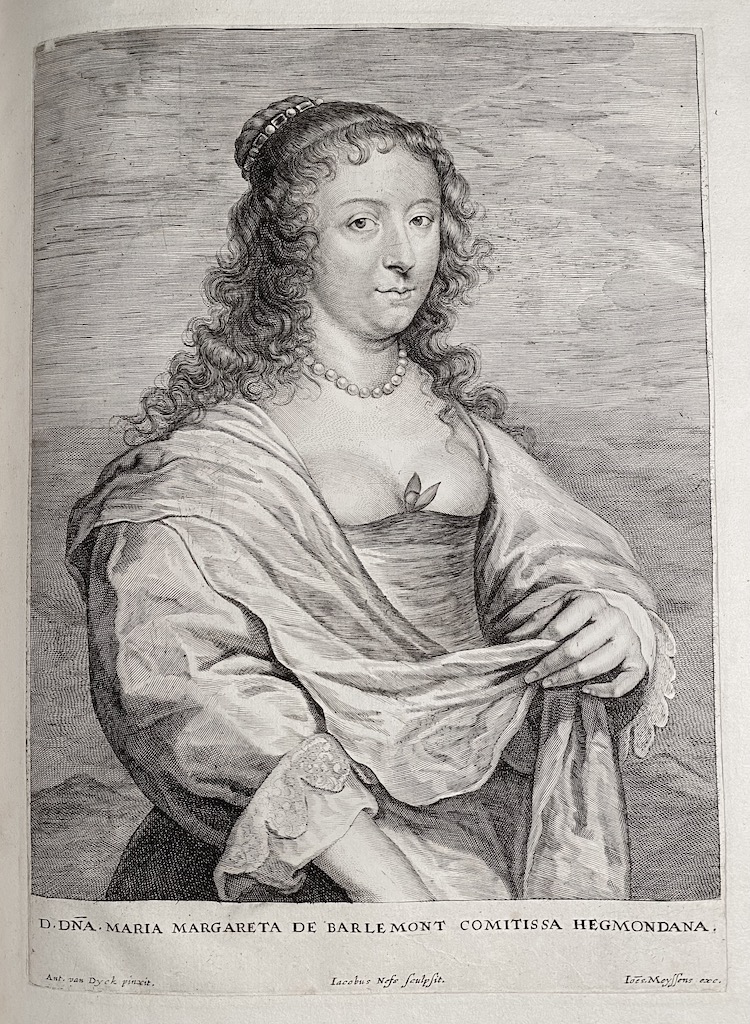
67. Marie-Marguerite de Berlaymont ( ? – 1654); engraved by Jacobus Neeffs, published by Ioannes Meyssens. Inscription: “D.DNA. MARIA MARGARETA DE BARLEMONT COMITISSA HEGMONDANA.” In lower margin: “Ant. van Dyck pinxit.” <–> “Iacobus Nefs sculpsit.” <–> “Ioes Meyssens exc.”. Fourth state. [Similar to №45, but this one with Ioannes Meysens name present]. 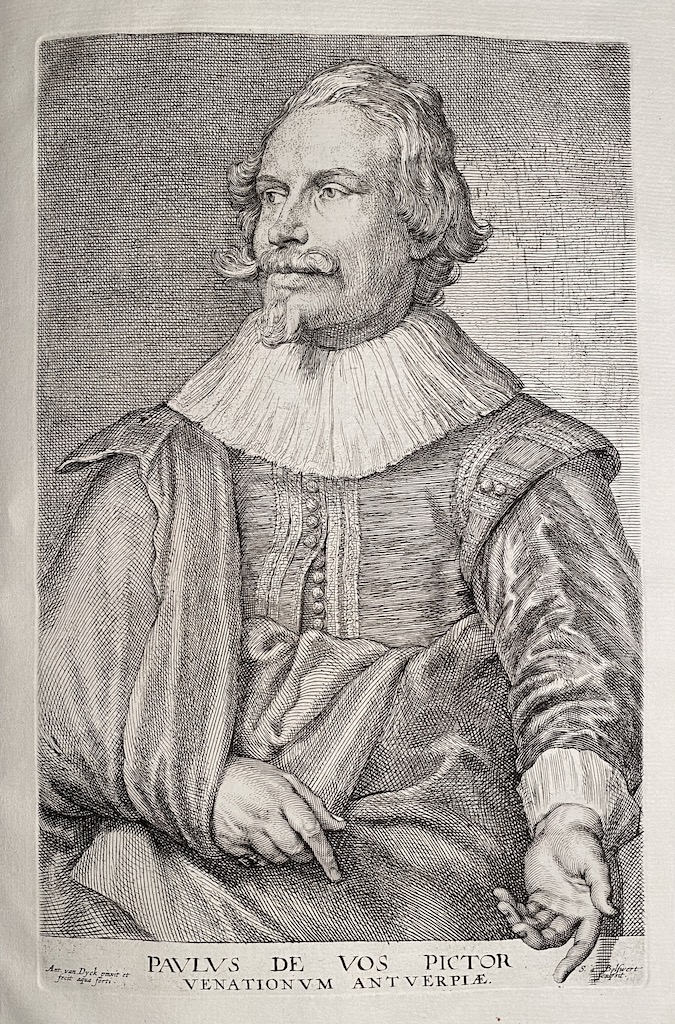
68. Paul de Vos (Flemich, 1596-1678); engraved and etched by Anthony van Dyck and by Schelte Adamsz. Bolswert, published by Gillis Hendricx. Eighth state with the initials of Gillis Hendricx burnished. Inscription: PAVLVS DE VOS PICTOR | VENATIONVM ANTVERPIÆ.”. “Ant. van Dyck pinxit et | fecit aqua forti.” <–> “S. à Bol∫wert | sculpsit. ”. [Look s very much alike №53, but with a two-line inscription and engraved by Bolswert instead of Meyssens, etc.]. 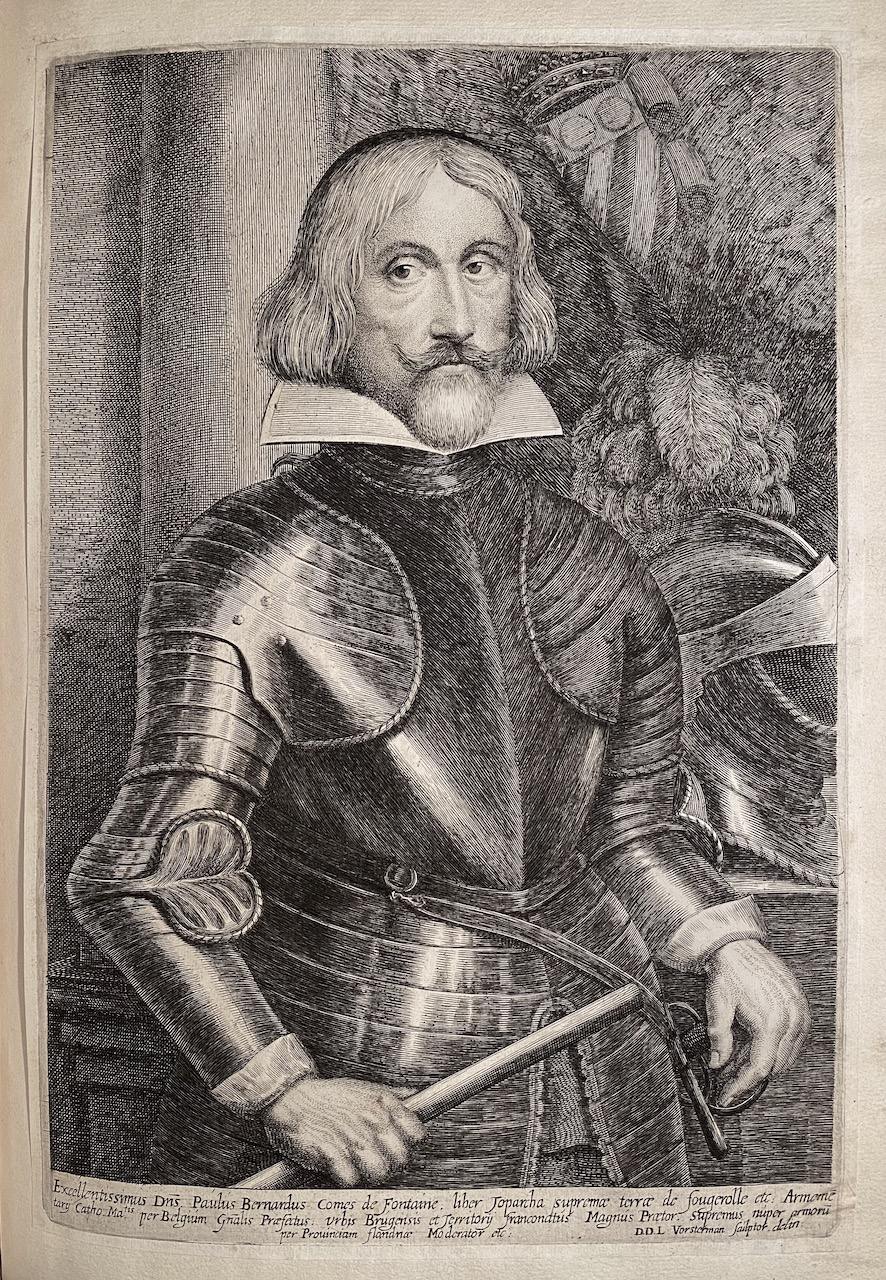
69. Paul-Bernard de Fontaines (French, 1566 – 1643) delineated and engraved by Lucas Vorsterman I (Flemish, 1595 – 1675) in 1615–75. Inscription: “Excellentissimus Dns. Paulus Bernardus Comes de Fontaine. liber Toparcha supremae terrae de fougerolle etc: Armeme tarij Catho. Matis. per Belgium Gnalis Praefectus: Vrbis Brugensis et Territorij fraconatus Magnus Praetor. Supremus nuper armpru Prouinciam flandriae Moderator etc: D.D.L Vorsterman sculptor. delin”. Cut without margins and pasted to inbound leaf. See: MET: Accession Number: 51.501.1332 -
![George Cruikshank : A Catalogue Raisonné Of The Work Executed During The Years 1806-1877; With Collations, Notes, Approximate Values, Facsimiles, And Illustrationsby Albert M. Cohn, author of a bibliographical catalogue of the printed works illustrated by George Cruikshank, etc. London : Office of "The Bookman's Jounral", 1924. [Cohn, Albert M.]](https://varshavskycollection.com/wp-content/uploads/2021/02/LIB-1650-c-scaled-500x500.jpg) GEORGE CRUIKSHANK | A CATALOGUE RAISONNÉ | OF THE WORK EXECUTED | DURING THE YEARS 1806-1877 | WITH COLLATIONS, NOTES, APPROXIMATE VALUES, | FACSIMILES, AND ILLUSTRATIONS | BY | ALBERT M. COHN | Author of A Bibliographical Catalogue of the Printed | Works Illustrated By George Cruikshank, etc. | LONDON |FROM THE OFFICE OF "THE BOOKMAN'S JOURNAL" | 7 HENRIETTA STREET, STRAND, W.C.2 | 1924. Pagination: ffl, [i, ii] – h.t. / Limited edition (122 of 500), [2] – blank / frontis. lith. portrait of G. Cruikshank w/guard, [iii, iv] – t.p. / printed in G.B., [v, vi] – dedicat. / blank, vii-xvi; [1, 2] – f.t. / blank, 3-375, [376] – Imprint., bfl; 31 leaves of plates, some mounted. Binding: size 30 x 24 x 5.5 cm, hardcover, bevelled boards, original brown cloth with gilded lettering to spine. Top edge gilt, other untrimmed; printed on laid paper. To front pastedown: "Ex libris – Fred Robison Heryer" (round, 55 mm, resembles a coin, printed on heavy gold-coloured foil with embossed lettering and an image of a seated man lettered ALEXANDROY in Greek. To back pastedown: Seller's sticker "From the book of J.W.Robinson Co., Seventh & Grand, Los Angeles." J. W. Robinson Co. – a chain of department stores, established by Joseph Winchester Robinson (American, 1846 – 1891). Some Fred Robison Heryer (American, 1907 – 1992) died in Kansas.
GEORGE CRUIKSHANK | A CATALOGUE RAISONNÉ | OF THE WORK EXECUTED | DURING THE YEARS 1806-1877 | WITH COLLATIONS, NOTES, APPROXIMATE VALUES, | FACSIMILES, AND ILLUSTRATIONS | BY | ALBERT M. COHN | Author of A Bibliographical Catalogue of the Printed | Works Illustrated By George Cruikshank, etc. | LONDON |FROM THE OFFICE OF "THE BOOKMAN'S JOURNAL" | 7 HENRIETTA STREET, STRAND, W.C.2 | 1924. Pagination: ffl, [i, ii] – h.t. / Limited edition (122 of 500), [2] – blank / frontis. lith. portrait of G. Cruikshank w/guard, [iii, iv] – t.p. / printed in G.B., [v, vi] – dedicat. / blank, vii-xvi; [1, 2] – f.t. / blank, 3-375, [376] – Imprint., bfl; 31 leaves of plates, some mounted. Binding: size 30 x 24 x 5.5 cm, hardcover, bevelled boards, original brown cloth with gilded lettering to spine. Top edge gilt, other untrimmed; printed on laid paper. To front pastedown: "Ex libris – Fred Robison Heryer" (round, 55 mm, resembles a coin, printed on heavy gold-coloured foil with embossed lettering and an image of a seated man lettered ALEXANDROY in Greek. To back pastedown: Seller's sticker "From the book of J.W.Robinson Co., Seventh & Grand, Los Angeles." J. W. Robinson Co. – a chain of department stores, established by Joseph Winchester Robinson (American, 1846 – 1891). Some Fred Robison Heryer (American, 1907 – 1992) died in Kansas. -
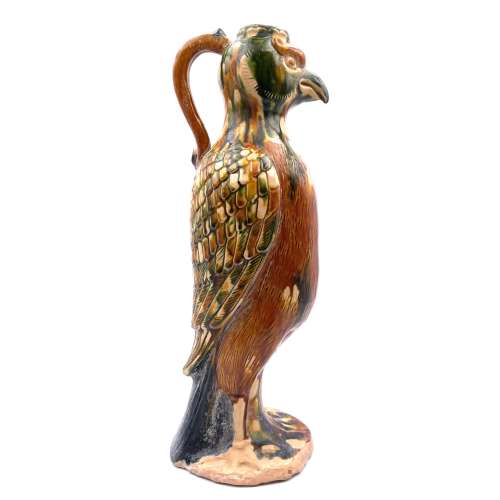 Made of two moulded symmetrical halves, joined before attaching the handle. On an unglazed base. Glazed in three colours (green, amber and ivory) and the tail is glazed black or dark blue. China, the Tang dynasty [唐朝] (618 – 907). Height: 37 cm.
Made of two moulded symmetrical halves, joined before attaching the handle. On an unglazed base. Glazed in three colours (green, amber and ivory) and the tail is glazed black or dark blue. China, the Tang dynasty [唐朝] (618 – 907). Height: 37 cm. -
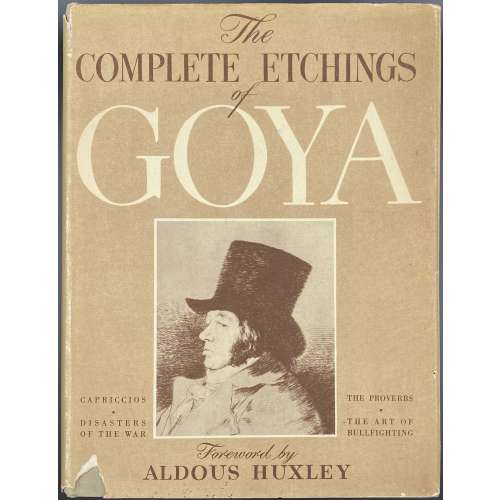 Title: THE COMPLETE ETCHINGS OF | Goya | With a Foreword by Aldous Huxley | CROWN PUBLISHERS. NEW YORK|| Pagination: [2 blank] [1-6] 7-16 [6], 234 plates on 118 leaves [2 blank] Contents: The capriccios [Los caprichos]. The disasters of the war [Los desastres de la guerra]. The art of bullfighting [La Tauromaquia]. The proverbs [Los disparates, Proverbios]. Miscellany. Binding: Hardcover, grey cloth, black lettering to cover and spine, pictorial DJ.
Title: THE COMPLETE ETCHINGS OF | Goya | With a Foreword by Aldous Huxley | CROWN PUBLISHERS. NEW YORK|| Pagination: [2 blank] [1-6] 7-16 [6], 234 plates on 118 leaves [2 blank] Contents: The capriccios [Los caprichos]. The disasters of the war [Los desastres de la guerra]. The art of bullfighting [La Tauromaquia]. The proverbs [Los disparates, Proverbios]. Miscellany. Binding: Hardcover, grey cloth, black lettering to cover and spine, pictorial DJ. -
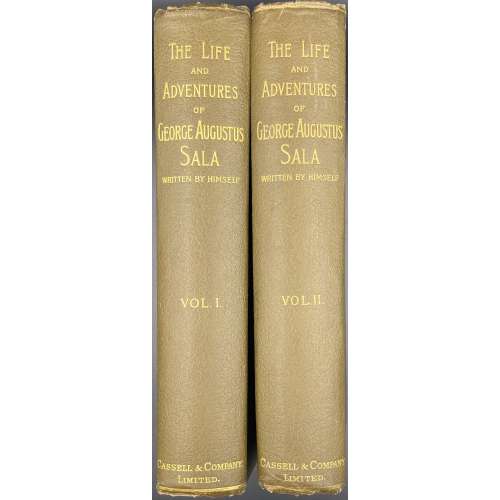 Vol. 1. Title: THE | LIFE AND ADVENTURES | OF | George Augustus Sala | WRITTEN BY HIMSELF | In Two Volumes | VOL. I. | (WITH PORTRAIT OF THE AUTHOR) | CASSEL AND COMPANY, Limited | LONDON, PARIS & MELBOURNE | 1895 | ALL RIGHTS RESERVED || Pagination: frontispiece portrait of Sala by Boussod, Valadon & Cie. w/guard tissue, [i, ii] – t.p./blank, [iii, iv] – dedication/blank, [v]-x – preface, [xi]-xvi – content, [1] 2-442, [16] advert. Collation: A-Z8 AA-BB8 CC5 [Advert.]8. Vol. 2. Title: THE | LIFE AND ADVENTURES | OF | George Augustus Sala | WRITTEN BY HIMSELF | In Two Volumes | VOL. II. | (WITH PORTRAIT OF THE AUTHORS MOTHER) | CASSEL AND COMPANY, Limited | LONDON, PARIS & MELBOURNE | 1895 | ALL RIGHTS RESERVED || Pagination: frontispiece portrait of Sal’s mother w/guard tissue, [i, ii] – t.p. / blank, [iii] iv-viii – content, [1] 2-457-[460], [16] advert. Collation: A-Z8 aa-cc8 dd6 [Advert.]8. Binding: two volumes in uniform green publisher’s pebbled buckram, gilt lettering to spine, contemporary newspaper clippings to front and back pastedowns, vol. 2 uncut. Note: George Augustus Sala's mother was an actress Henrietta Simon Sala, known as Madame Sala, (Guyanese, British, 1789 – 1860). Here she is depicted by an engraver Thomas Alfred Woolnoth (British, 1785 – 1857) after a portrait painted by Rose Emma Drummond (British, fl. 1820 – 1840).
Vol. 1. Title: THE | LIFE AND ADVENTURES | OF | George Augustus Sala | WRITTEN BY HIMSELF | In Two Volumes | VOL. I. | (WITH PORTRAIT OF THE AUTHOR) | CASSEL AND COMPANY, Limited | LONDON, PARIS & MELBOURNE | 1895 | ALL RIGHTS RESERVED || Pagination: frontispiece portrait of Sala by Boussod, Valadon & Cie. w/guard tissue, [i, ii] – t.p./blank, [iii, iv] – dedication/blank, [v]-x – preface, [xi]-xvi – content, [1] 2-442, [16] advert. Collation: A-Z8 AA-BB8 CC5 [Advert.]8. Vol. 2. Title: THE | LIFE AND ADVENTURES | OF | George Augustus Sala | WRITTEN BY HIMSELF | In Two Volumes | VOL. II. | (WITH PORTRAIT OF THE AUTHORS MOTHER) | CASSEL AND COMPANY, Limited | LONDON, PARIS & MELBOURNE | 1895 | ALL RIGHTS RESERVED || Pagination: frontispiece portrait of Sal’s mother w/guard tissue, [i, ii] – t.p. / blank, [iii] iv-viii – content, [1] 2-457-[460], [16] advert. Collation: A-Z8 aa-cc8 dd6 [Advert.]8. Binding: two volumes in uniform green publisher’s pebbled buckram, gilt lettering to spine, contemporary newspaper clippings to front and back pastedowns, vol. 2 uncut. Note: George Augustus Sala's mother was an actress Henrietta Simon Sala, known as Madame Sala, (Guyanese, British, 1789 – 1860). Here she is depicted by an engraver Thomas Alfred Woolnoth (British, 1785 – 1857) after a portrait painted by Rose Emma Drummond (British, fl. 1820 – 1840). -
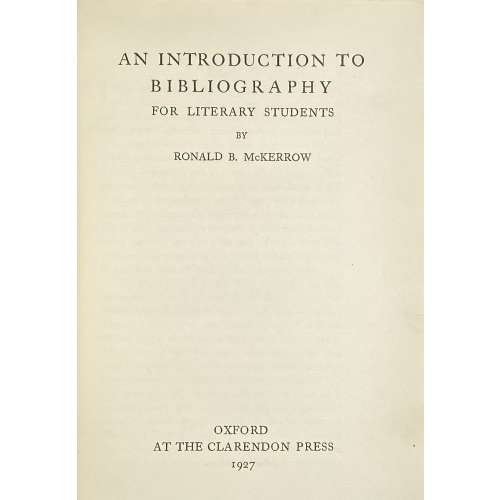 Title: AN INTRODUCTION TO | BIBLIOGRAPHY | FOR LITERARY STUDENTS | BY | RONALD B. McKERROW | OXFORD | AT THE CLARENDON PRESS | 1927 Pagination: [i-iv] v-xv [xvi blank], 1-358 [2]. Collation: [a]4 b4 B-Z4 Aa-Zz4. Exterior: 23 x 15 cm, publisher’s black cloth, gilt lettering and publisher’s device to spine. Bookseller's sticker to ffl: CHAS. E. LAURIAT CO., | IMPORTERS & BOOKSELLERS | 385 Wash’n St. Boston || – this is of Lauriat, Charles Emelius Jr. (American, 1874 – 1937).
Title: AN INTRODUCTION TO | BIBLIOGRAPHY | FOR LITERARY STUDENTS | BY | RONALD B. McKERROW | OXFORD | AT THE CLARENDON PRESS | 1927 Pagination: [i-iv] v-xv [xvi blank], 1-358 [2]. Collation: [a]4 b4 B-Z4 Aa-Zz4. Exterior: 23 x 15 cm, publisher’s black cloth, gilt lettering and publisher’s device to spine. Bookseller's sticker to ffl: CHAS. E. LAURIAT CO., | IMPORTERS & BOOKSELLERS | 385 Wash’n St. Boston || – this is of Lauriat, Charles Emelius Jr. (American, 1874 – 1937). -
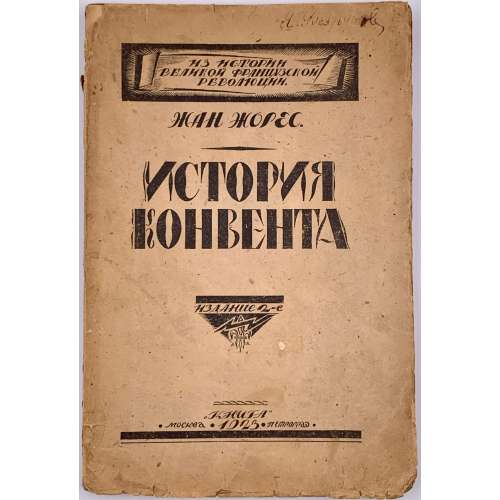 Cover: ИЗ ИСТОРИИ | ВЕЛИКОЙ ФРАНЦУЗСКОЙ | РЕВОЛЮЦИИ | ЖАН ЖОРЕС | ИСТОРИЯ КОНВЕНТА | ИЗДАНИЕ 2-е | “Книга” | • МОСКВА • 1923 • ПЕТРОГРАД • || Title page: Жан Жорес | История Конвента | Сокращенный перевод В. Левицкого | под редакцией Ф. Дана. | Второе издание. | {publisher’s device} | “Книга” | Москва. […] Петроград | Тверская, 38, тел. 2-64-61. […] Невский, 74, тел. 1-34-34. || Print run: 3,000 copies. Printer: 10-я типография МСНХ «Мосполиграф». Original Title: Histoire socialiste : 1789-1900. La convention nationale / par J. Jaurès. — Paris : Jules Rouff et Cie, 1901 Bibliographical description: 23.5 x 16 cm, publisher’s letterpress wrappers, pp. [1-3] 4-191 [192]; collation: 8vo, [1-2]8 3-128; ink inscription to front wrapper: Я. Безруков Jean Jaurès [Жан Жорес] (French, 1859 – 1914) Цедербаум, Владимир Осипович [Левицкий, В.] (Russian-Jewish, 1883 – 1938) Дан [Гурвич], Федор Ильич (Russian-Jewish, 1871-1947)
Cover: ИЗ ИСТОРИИ | ВЕЛИКОЙ ФРАНЦУЗСКОЙ | РЕВОЛЮЦИИ | ЖАН ЖОРЕС | ИСТОРИЯ КОНВЕНТА | ИЗДАНИЕ 2-е | “Книга” | • МОСКВА • 1923 • ПЕТРОГРАД • || Title page: Жан Жорес | История Конвента | Сокращенный перевод В. Левицкого | под редакцией Ф. Дана. | Второе издание. | {publisher’s device} | “Книга” | Москва. […] Петроград | Тверская, 38, тел. 2-64-61. […] Невский, 74, тел. 1-34-34. || Print run: 3,000 copies. Printer: 10-я типография МСНХ «Мосполиграф». Original Title: Histoire socialiste : 1789-1900. La convention nationale / par J. Jaurès. — Paris : Jules Rouff et Cie, 1901 Bibliographical description: 23.5 x 16 cm, publisher’s letterpress wrappers, pp. [1-3] 4-191 [192]; collation: 8vo, [1-2]8 3-128; ink inscription to front wrapper: Я. Безруков Jean Jaurès [Жан Жорес] (French, 1859 – 1914) Цедербаум, Владимир Осипович [Левицкий, В.] (Russian-Jewish, 1883 – 1938) Дан [Гурвич], Федор Ильич (Russian-Jewish, 1871-1947) -
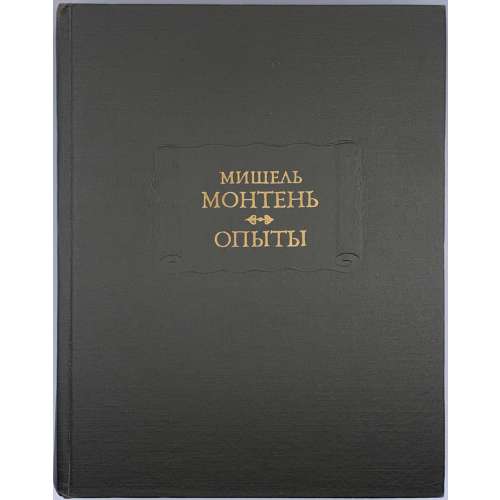 A two-volume edition. 1st vol. Title (in black and red): МИШЕЛЬ | МОНТЕНЬ | ОПЫТЫ | В ТРЕХ КНИГАХ | КНИГИ | ПЕРВАЯ И ВТОРАЯ | Издание подготовили | А. С. БОБОВИЧ | Ф. А. КОГАН-БЕРНШТЕЙН | Н. Я. РЫКОВА, А. А. СМИРНОВ | Второе издание | ИЗДАТЕЛЬСТВО "НАУКА | МОСКВА | 1979 || Opposite title: MICHEL |de | MONTAIGNE | LES ESSAIS || Pagination: [1-5] 6-703 [1], errata slip. Collation: 16mo, [1]-2216, + frontispiece portrait and 2 plates extraneous to collation. 2nd vol. Title (2) (in black and red): МИШЕЛЬ | МОНТЕНЬ | ОПЫТЫ | В ТРЕХ КНИГАХ | КНИГА ТРЕТЬЯ | Издание подготовили | А. С. БОБОВИЧ | Ф. А. КОГАН-БЕРНШТЕЙН | Н. Я. РЫКОВА, А. А. СМИРНОВ | Второе издание | ИЗДАТЕЛЬСТВО "НАУКА | МОСКВА | 1979 || Opposite title: MICHEL |de | MONTAIGNE | LES ESSAIS || Pagination: [1-5] 6-534 [2]. Collation: 8vo, [1]-348, + frontispiece portrait. Binding: Uniformly bound in serial design green cloth with gilt lettering on an embossed scroll to front cover, gilt lettering to spine, 22 x 18 cm. Print run: 200,000 copies each volume. Michel Eyquem de Montaigne (French, 1533 – 1592) Ананий [Анатолий] Самуилович Бобович (Russian-Jewish, 1904 – 1988) Надежда Януарьевна Рыкова (Russian, 1901 – 1996) Александр Александрович Смирнов (Russian, 1883– 1962) Фаина Абрамовна Коган-Бернштейн [b. Аронгауз] (Russian-Jewish, 1899 – 1976)
A two-volume edition. 1st vol. Title (in black and red): МИШЕЛЬ | МОНТЕНЬ | ОПЫТЫ | В ТРЕХ КНИГАХ | КНИГИ | ПЕРВАЯ И ВТОРАЯ | Издание подготовили | А. С. БОБОВИЧ | Ф. А. КОГАН-БЕРНШТЕЙН | Н. Я. РЫКОВА, А. А. СМИРНОВ | Второе издание | ИЗДАТЕЛЬСТВО "НАУКА | МОСКВА | 1979 || Opposite title: MICHEL |de | MONTAIGNE | LES ESSAIS || Pagination: [1-5] 6-703 [1], errata slip. Collation: 16mo, [1]-2216, + frontispiece portrait and 2 plates extraneous to collation. 2nd vol. Title (2) (in black and red): МИШЕЛЬ | МОНТЕНЬ | ОПЫТЫ | В ТРЕХ КНИГАХ | КНИГА ТРЕТЬЯ | Издание подготовили | А. С. БОБОВИЧ | Ф. А. КОГАН-БЕРНШТЕЙН | Н. Я. РЫКОВА, А. А. СМИРНОВ | Второе издание | ИЗДАТЕЛЬСТВО "НАУКА | МОСКВА | 1979 || Opposite title: MICHEL |de | MONTAIGNE | LES ESSAIS || Pagination: [1-5] 6-534 [2]. Collation: 8vo, [1]-348, + frontispiece portrait. Binding: Uniformly bound in serial design green cloth with gilt lettering on an embossed scroll to front cover, gilt lettering to spine, 22 x 18 cm. Print run: 200,000 copies each volume. Michel Eyquem de Montaigne (French, 1533 – 1592) Ананий [Анатолий] Самуилович Бобович (Russian-Jewish, 1904 – 1988) Надежда Януарьевна Рыкова (Russian, 1901 – 1996) Александр Александрович Смирнов (Russian, 1883– 1962) Фаина Абрамовна Коган-Бернштейн [b. Аронгауз] (Russian-Jewish, 1899 – 1976) -
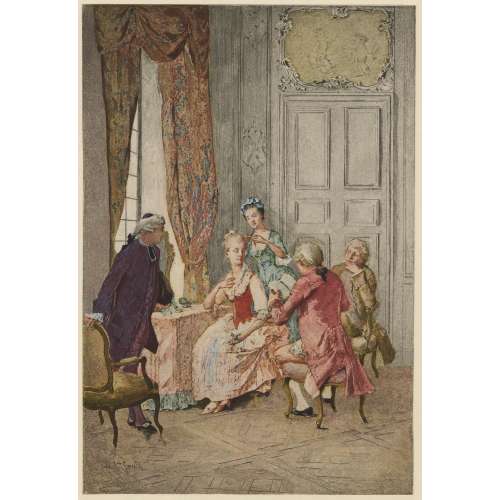
Coloured etching by E. Charreyre (French, fl. 1880 – ?) after a watercolour by Juan Antonio González, (Spanish, 1842 – 1914). A book illustration for 'Son Altesse La Femme' by Octave Uzanne (1851 – 1931), chapter: 'La Caillette' (Le lever d’une petite-maitresse au XVIIIe siècle). Published by Albert Quantin (French, 1850 – 1930) in 1885.
Size: print 17.5 x 12 cm, pasted to leaf 27.7 x 19.5 cm.
-
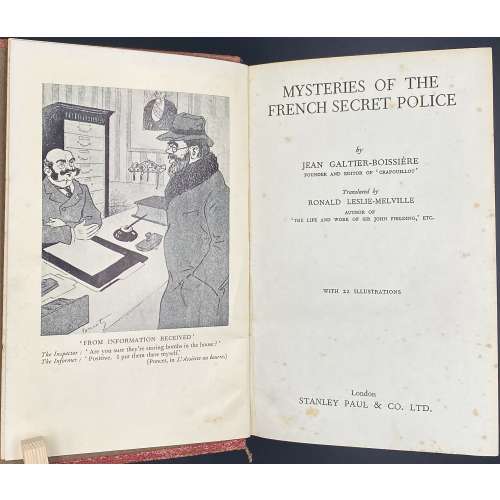 Title page: MYSTERIES OF THE | FRENCH SECRET POLICE | by | JEAN GALTIER-BOISSIÈRE | FOUNDER AND EDITOR OF ‘CRAPOUILLOT’ | Translated by | RONALD LESLIE-MELVILLE | AUTHOR OF | ‘THE LIFE AND WORK OF SIR JOHN FIELDING’, ETC. | WITH 22 ILLUSTRATIONS | London | STANLEY PAUL & CO. LTD. || Pagination: [1-8] 9-292 [16 advert], frontis., 14 pp of ill. Collation: 8vo; [A]8 B-R8 S10 + 8 leaves of advertisement + frontispiece and 7 leaves of b/w photomechanical illustrations. Binding: Burgundy cloth, gilt lettering to spine, brown endpapers. Contributors: Galtier-Boissière, Jean (French, 1891 – 1966) – author. Leslie-Melville, Ronald (British, 1905 – 1942) – translator. Stanley Paul (London) – publisher. Mayflower Press (Plymouth), William Brendon & Son (Plymouth) – printers.
Title page: MYSTERIES OF THE | FRENCH SECRET POLICE | by | JEAN GALTIER-BOISSIÈRE | FOUNDER AND EDITOR OF ‘CRAPOUILLOT’ | Translated by | RONALD LESLIE-MELVILLE | AUTHOR OF | ‘THE LIFE AND WORK OF SIR JOHN FIELDING’, ETC. | WITH 22 ILLUSTRATIONS | London | STANLEY PAUL & CO. LTD. || Pagination: [1-8] 9-292 [16 advert], frontis., 14 pp of ill. Collation: 8vo; [A]8 B-R8 S10 + 8 leaves of advertisement + frontispiece and 7 leaves of b/w photomechanical illustrations. Binding: Burgundy cloth, gilt lettering to spine, brown endpapers. Contributors: Galtier-Boissière, Jean (French, 1891 – 1966) – author. Leslie-Melville, Ronald (British, 1905 – 1942) – translator. Stanley Paul (London) – publisher. Mayflower Press (Plymouth), William Brendon & Son (Plymouth) – printers. -
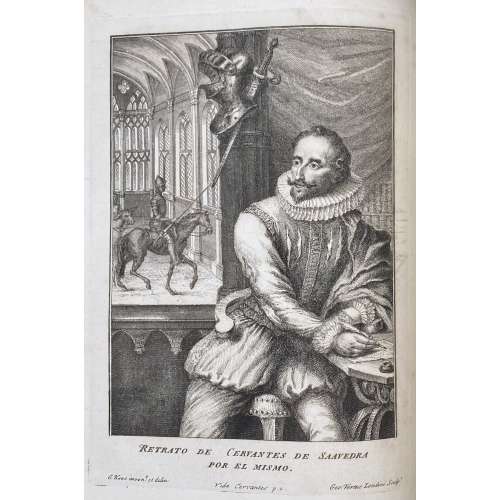 Two volumes uniformly bound by Riviere & Son in full red marbled calf, triple fillet border stamped in gilt, elaborate gilt ornament and brown morocco labels with gilt lettering to spine, all edge gilt, gilt dentelles. Vol. 1: Title page: THE | LIFE AND EXPLOITS | Of the ingenious gentleman | DON QUIXOTE | DE LA MANCHA. | Translated from the Original Spanish of | Miguel Cervantes de Saavedra. | By CHARLES JARVIS, Esq; | IN TWO VOLUMES. | {single rule} | VOLUME the FIRST. | {double rule} | LONDON: | Printed for J. and R. Tonson in the Strand, and | R. Dodsley in Pall-Mall. | {single rule} | M DCC XLII || Pagination: [i-iii] iv-xxxii, [i-iii] iv-vi, [2], [1] 2-90, [14], [1] 2-355 [356]; 500 pages total + ils. Collation: 4to; 250 leaves; A4 a-b4 c-d2, A4, a-l4 m2 n4 o2, B-Z4, Aa-Yy4 Z2, ils. Illustrations: 27 full-page copperplate engravings, incl. frontispiece (skillfully repaired), portrait of Cervantes by George Vertue After G. Kent and a fictional portrait of Don Quixote by George Vertue after John Vanderbank. Vol. 2: Title page: THE | LIFE AND EXPLOITS | Of the ingenious gentleman | DON QUIXOTE | DE LA MANCHA. | Translated from the Original Spanish of | Miguel Cervantes de Saavedra. | By CHARLES JARVIS, Esq; | {single rule} | VOLUME the SECOND. | {double rule} | LONDON: | Printed for J. and R. Tonson in the Strand, and | R. Dodsley in Pall-Mall. | {single rule} | M DCC XLII || Pagination: [i-iii] iv-xii, [1] 2-388; 400 pages total + ils. Collation: 4to; 200 leaves; A4 a2 B-Z4 Aa-Zz4 Aaa-Ccc4 Ddd2, ils. Illustrations:41 full-page copperplate engravings, pl. 29 (as frontispieces) precedes pl. 28. Contributors: Author: Miguel de Cervantes Saavedra (Spanish, 1547 – 1616) Translator: Charles Jervas (British, 1675 – 1739) Author: Cervantes biography by Gregorio Mayans y Siscar (Spanish, 1699 – 1781) Translator: Cervantes biography by John Ozell (British, d. 1743) Illustrator: John Vanderbank, the younger (British, 1694 – 1739) Artist: (Cervantes portrait): G. Kent (British, fl. 1738 – 1742) Engravers: Gerard Vandergucht (British, 1696 – 1776); George Vertue (British, 1684 – 1756); Bernard Baron (French, 1696 – 1762); Claude Du Bosc (French, 1682 – 1746 or later) Publishers: J. and R. Tonson (London); Robert Dodsley (British, 1703 – 1764) Catalogue raisonné: Lewine p. 102 Reference: Metropolitan Museum (New York)
Two volumes uniformly bound by Riviere & Son in full red marbled calf, triple fillet border stamped in gilt, elaborate gilt ornament and brown morocco labels with gilt lettering to spine, all edge gilt, gilt dentelles. Vol. 1: Title page: THE | LIFE AND EXPLOITS | Of the ingenious gentleman | DON QUIXOTE | DE LA MANCHA. | Translated from the Original Spanish of | Miguel Cervantes de Saavedra. | By CHARLES JARVIS, Esq; | IN TWO VOLUMES. | {single rule} | VOLUME the FIRST. | {double rule} | LONDON: | Printed for J. and R. Tonson in the Strand, and | R. Dodsley in Pall-Mall. | {single rule} | M DCC XLII || Pagination: [i-iii] iv-xxxii, [i-iii] iv-vi, [2], [1] 2-90, [14], [1] 2-355 [356]; 500 pages total + ils. Collation: 4to; 250 leaves; A4 a-b4 c-d2, A4, a-l4 m2 n4 o2, B-Z4, Aa-Yy4 Z2, ils. Illustrations: 27 full-page copperplate engravings, incl. frontispiece (skillfully repaired), portrait of Cervantes by George Vertue After G. Kent and a fictional portrait of Don Quixote by George Vertue after John Vanderbank. Vol. 2: Title page: THE | LIFE AND EXPLOITS | Of the ingenious gentleman | DON QUIXOTE | DE LA MANCHA. | Translated from the Original Spanish of | Miguel Cervantes de Saavedra. | By CHARLES JARVIS, Esq; | {single rule} | VOLUME the SECOND. | {double rule} | LONDON: | Printed for J. and R. Tonson in the Strand, and | R. Dodsley in Pall-Mall. | {single rule} | M DCC XLII || Pagination: [i-iii] iv-xii, [1] 2-388; 400 pages total + ils. Collation: 4to; 200 leaves; A4 a2 B-Z4 Aa-Zz4 Aaa-Ccc4 Ddd2, ils. Illustrations:41 full-page copperplate engravings, pl. 29 (as frontispieces) precedes pl. 28. Contributors: Author: Miguel de Cervantes Saavedra (Spanish, 1547 – 1616) Translator: Charles Jervas (British, 1675 – 1739) Author: Cervantes biography by Gregorio Mayans y Siscar (Spanish, 1699 – 1781) Translator: Cervantes biography by John Ozell (British, d. 1743) Illustrator: John Vanderbank, the younger (British, 1694 – 1739) Artist: (Cervantes portrait): G. Kent (British, fl. 1738 – 1742) Engravers: Gerard Vandergucht (British, 1696 – 1776); George Vertue (British, 1684 – 1756); Bernard Baron (French, 1696 – 1762); Claude Du Bosc (French, 1682 – 1746 or later) Publishers: J. and R. Tonson (London); Robert Dodsley (British, 1703 – 1764) Catalogue raisonné: Lewine p. 102 Reference: Metropolitan Museum (New York) -
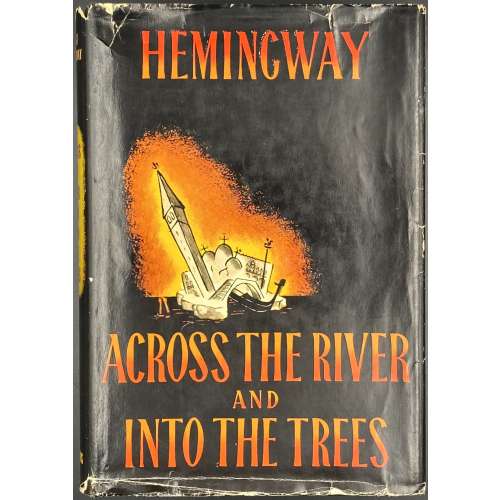 Title page: ACROSS THE RIVER | AND | INTO THE TREES | BY | ERNEST HEMINGWAY | CHARLES SCRIBNER'S SONS | NEW YORK | 1950 || Pagination: [12] 1-308; total 160 leaves. Binding: black cloth, gilt Hemingway's fac-simile to front board, lettering to spine, pictorial dust jacket designed by A. Ivancich; $3.00 price clipped from top of front flap. Bookplate of Feodor Rojankovsky to front pastedown. Size: 21.5 x 15 cm. Edition: 1st edition, 1st printing; DJ with yellow on spine (later copies have orange); letter “A” and the Scribner’s device to copyright page. Provenance: Rojankovsky, Feodor [Rojan; Рожанковский, Фёдор Степанович] (Russian-American, 1891 – 1970) Contributors: Ernest Hemingway (American, 1899 – 1961) – author. Adriana Ivancich (Italian, 1930 – 1983) – artist of the dust jacket (Ivancich inspired the figure of Renata in the novel). Charles Scribner's Sons – publisher.
Title page: ACROSS THE RIVER | AND | INTO THE TREES | BY | ERNEST HEMINGWAY | CHARLES SCRIBNER'S SONS | NEW YORK | 1950 || Pagination: [12] 1-308; total 160 leaves. Binding: black cloth, gilt Hemingway's fac-simile to front board, lettering to spine, pictorial dust jacket designed by A. Ivancich; $3.00 price clipped from top of front flap. Bookplate of Feodor Rojankovsky to front pastedown. Size: 21.5 x 15 cm. Edition: 1st edition, 1st printing; DJ with yellow on spine (later copies have orange); letter “A” and the Scribner’s device to copyright page. Provenance: Rojankovsky, Feodor [Rojan; Рожанковский, Фёдор Степанович] (Russian-American, 1891 – 1970) Contributors: Ernest Hemingway (American, 1899 – 1961) – author. Adriana Ivancich (Italian, 1930 – 1983) – artist of the dust jacket (Ivancich inspired the figure of Renata in the novel). Charles Scribner's Sons – publisher. -
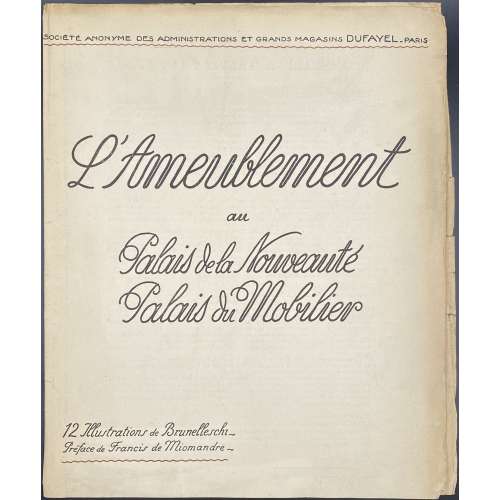 A set of 12 photomechanically reproduced illustrations after gouaches by Umberto Brunelleschi (Italian, 1879 – 1949), in colour; b/w photographs reproductions on verso, in a paper folder without the outer wrappers (b/w with birds, insects, and flowers). Text on the folder by French novelist Francis de Miomandre (French, 1880 – 1959); published by Grands Magasins Dufayel (1856 – 1930), a Parisian department store, run by Georges Dufayel (French, 1855 – 1916). Size: 29 x 24 cm. Images printed on cream paper within a beige frame, lettered above the frame in beige: "Societé Anonyme des Administrations et Grands Magasins DUFAYEL — Paris —", under the frame: "Palais de la Nouveauté ~ Palais du Mobilier | Entrée principale 7 Bould BARBES"; at the bottom of the frame lettered black on each image: Le Style Chinois, Le Style Empire, Le Style Japonais, Le Style Louis XIV, Le Style Louis XV, Le Style Louis XVI, Le Style Moderne (2), Le Style Moyen Age, Le Style Renaissance, Le Style Vénitien, Le Style Persian.
A set of 12 photomechanically reproduced illustrations after gouaches by Umberto Brunelleschi (Italian, 1879 – 1949), in colour; b/w photographs reproductions on verso, in a paper folder without the outer wrappers (b/w with birds, insects, and flowers). Text on the folder by French novelist Francis de Miomandre (French, 1880 – 1959); published by Grands Magasins Dufayel (1856 – 1930), a Parisian department store, run by Georges Dufayel (French, 1855 – 1916). Size: 29 x 24 cm. Images printed on cream paper within a beige frame, lettered above the frame in beige: "Societé Anonyme des Administrations et Grands Magasins DUFAYEL — Paris —", under the frame: "Palais de la Nouveauté ~ Palais du Mobilier | Entrée principale 7 Bould BARBES"; at the bottom of the frame lettered black on each image: Le Style Chinois, Le Style Empire, Le Style Japonais, Le Style Louis XIV, Le Style Louis XV, Le Style Louis XVI, Le Style Moderne (2), Le Style Moyen Age, Le Style Renaissance, Le Style Vénitien, Le Style Persian. -
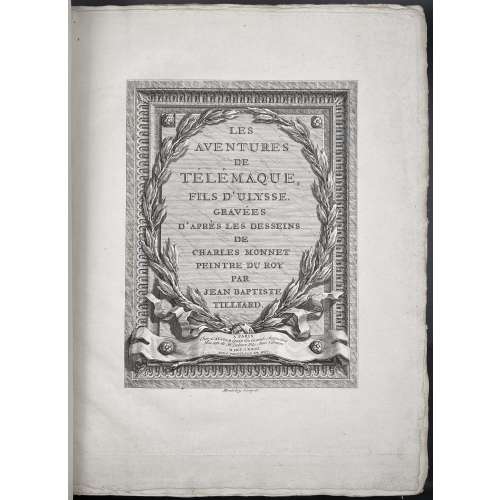 Vol. 1: Title page: LES AVENTURES | DE | TÉLÉMAQUE, | PAR FÉNELON. — | TOME PREMIER. | {publisher’s arms by Beugnet after Choffard} | DE L'IMPRIMERIE DE MONSIEUR. | M. DCC. LXXXV. || Title-frontispiece (engraved by Montulay): lettering within garland: Les Aventures de Télémaque, FILS D’ULYSSE. GRAVÉES | D’APRÈS LES DESSEINS | DE | CHARLES MONNET | PEINTRE DU ROY | PAR | JEAN BAPTISTE | TILLIARD. ||; Lettering on ribbon beneath the garland: A PARIS | Chez L’AUTEUR Quay des Grands Augustins | Maison de Mr. Debure Fils Aîné Libraire. M. DCC. LXXIII. | AVEC PRIVILEGE DU ROY. ||; Signed under the frame: Montulay Sculpsit. || Pagination: [2] – h.t. / imprint, [2] – t.p. / blank, [2] Advert., [2] d.t.p. / sommaire, [1] 2-309 [3 blanks], total 320 pages on thick wove paper plus engraved title-frontis. by Montulay, 12 engraved text leaves (one for each book), unsigned, and 36 plates (all in ornamental frame of laurel ribbon) by Tilliard after Monnet, all engravings on laid paper. Collation: 4to; vergé flyleaves at front and back, π4 A-2P4 plus 4 additional divisional titles in choirs C, F, I, and M for books 2-5, total 160 leaves, plus 49 plates. Vol. 2: Title page: Same but “TOME SECOND”. Pagination: [2] – h.t. / imprint, [2] – t.p. / blank, [1-3] 4-297 [298 blank] [2] – approb., total 304 pages plus 12 engraved text leaves (one for each book), and 36 plates, last 6 plates in a simple frame without the laurel ribbon and before signatures. Collation: 4to; π2 A-2O4 2P1 χ1, total 152 leaves, plus 48 plates. Binding: Two volumes uniformly bound in green paper boards with two red labels lettered in gilt, untrimmed. Size: overall 36.5 x 28 cm, platemark 32 x 25 cm, with white vergé flyleaves to front and back, similar pastedowns. Catalogue raisonné: Cohen, de Ricci (1912): 384-386; Ray (French): № 37, p. 74; Lewine (1898): p. 181. Contributors: François Fénelon [François de Salignac de la Mothe-Fénelon] (French, 1651 – 1715) – author. Choffard, Pierre Philippe (French, 1730 – 1809) – artist. Monnet, Charles (French, 1732 – after 1808) – artist. Montulay (French, fl. c. 1773) – engraver. Tilliard, Jean Baptiste (French, 1740 – 1813) – engraver. Beugnet, Jean (French, c. 1803) – engraver. Didot, Pierre-François (French, 1731 – 1795) – printer. Barrois, Louis-François (French, 1748 – 1835?); Barrois, Pierre-Théophile (French, 1752 – 1836); Onfroy, Eugène (French, before 1765 – 1809) ; Delalain, Louis-Alexandre (French, 1749? – 1798) – booksellers.
Vol. 1: Title page: LES AVENTURES | DE | TÉLÉMAQUE, | PAR FÉNELON. — | TOME PREMIER. | {publisher’s arms by Beugnet after Choffard} | DE L'IMPRIMERIE DE MONSIEUR. | M. DCC. LXXXV. || Title-frontispiece (engraved by Montulay): lettering within garland: Les Aventures de Télémaque, FILS D’ULYSSE. GRAVÉES | D’APRÈS LES DESSEINS | DE | CHARLES MONNET | PEINTRE DU ROY | PAR | JEAN BAPTISTE | TILLIARD. ||; Lettering on ribbon beneath the garland: A PARIS | Chez L’AUTEUR Quay des Grands Augustins | Maison de Mr. Debure Fils Aîné Libraire. M. DCC. LXXIII. | AVEC PRIVILEGE DU ROY. ||; Signed under the frame: Montulay Sculpsit. || Pagination: [2] – h.t. / imprint, [2] – t.p. / blank, [2] Advert., [2] d.t.p. / sommaire, [1] 2-309 [3 blanks], total 320 pages on thick wove paper plus engraved title-frontis. by Montulay, 12 engraved text leaves (one for each book), unsigned, and 36 plates (all in ornamental frame of laurel ribbon) by Tilliard after Monnet, all engravings on laid paper. Collation: 4to; vergé flyleaves at front and back, π4 A-2P4 plus 4 additional divisional titles in choirs C, F, I, and M for books 2-5, total 160 leaves, plus 49 plates. Vol. 2: Title page: Same but “TOME SECOND”. Pagination: [2] – h.t. / imprint, [2] – t.p. / blank, [1-3] 4-297 [298 blank] [2] – approb., total 304 pages plus 12 engraved text leaves (one for each book), and 36 plates, last 6 plates in a simple frame without the laurel ribbon and before signatures. Collation: 4to; π2 A-2O4 2P1 χ1, total 152 leaves, plus 48 plates. Binding: Two volumes uniformly bound in green paper boards with two red labels lettered in gilt, untrimmed. Size: overall 36.5 x 28 cm, platemark 32 x 25 cm, with white vergé flyleaves to front and back, similar pastedowns. Catalogue raisonné: Cohen, de Ricci (1912): 384-386; Ray (French): № 37, p. 74; Lewine (1898): p. 181. Contributors: François Fénelon [François de Salignac de la Mothe-Fénelon] (French, 1651 – 1715) – author. Choffard, Pierre Philippe (French, 1730 – 1809) – artist. Monnet, Charles (French, 1732 – after 1808) – artist. Montulay (French, fl. c. 1773) – engraver. Tilliard, Jean Baptiste (French, 1740 – 1813) – engraver. Beugnet, Jean (French, c. 1803) – engraver. Didot, Pierre-François (French, 1731 – 1795) – printer. Barrois, Louis-François (French, 1748 – 1835?); Barrois, Pierre-Théophile (French, 1752 – 1836); Onfroy, Eugène (French, before 1765 – 1809) ; Delalain, Louis-Alexandre (French, 1749? – 1798) – booksellers.


